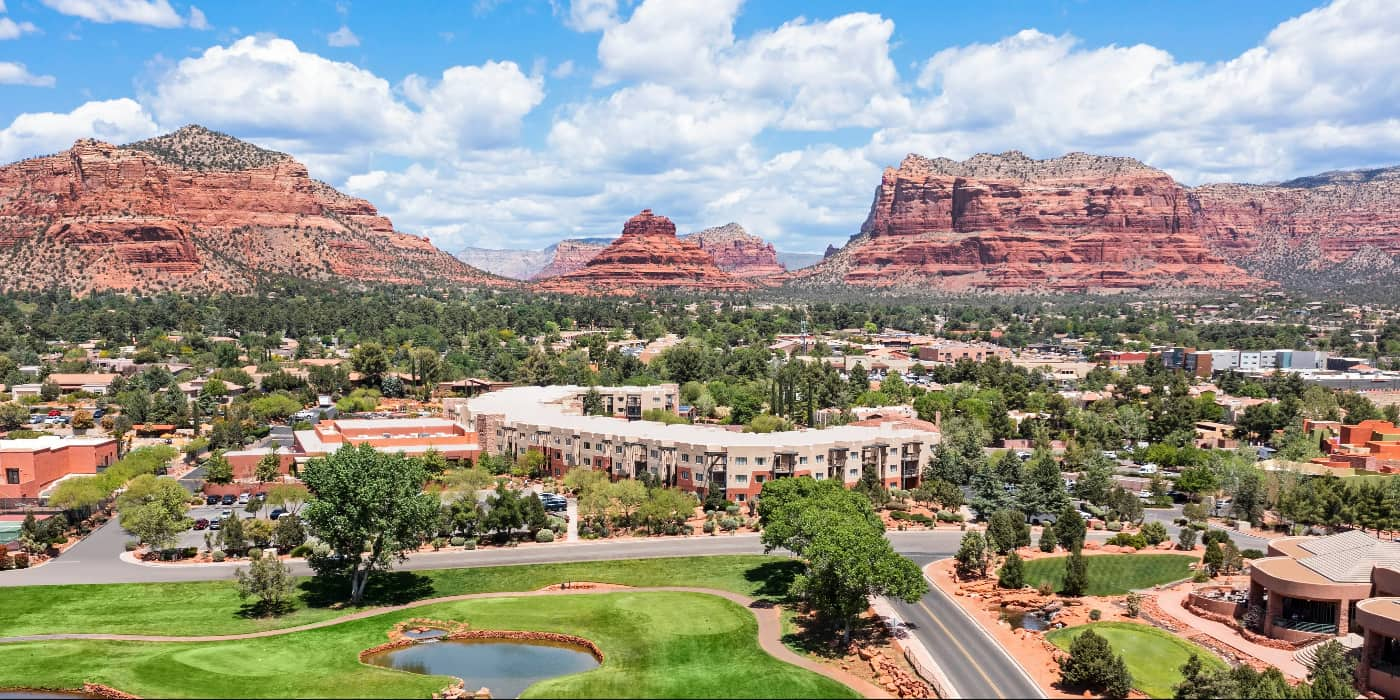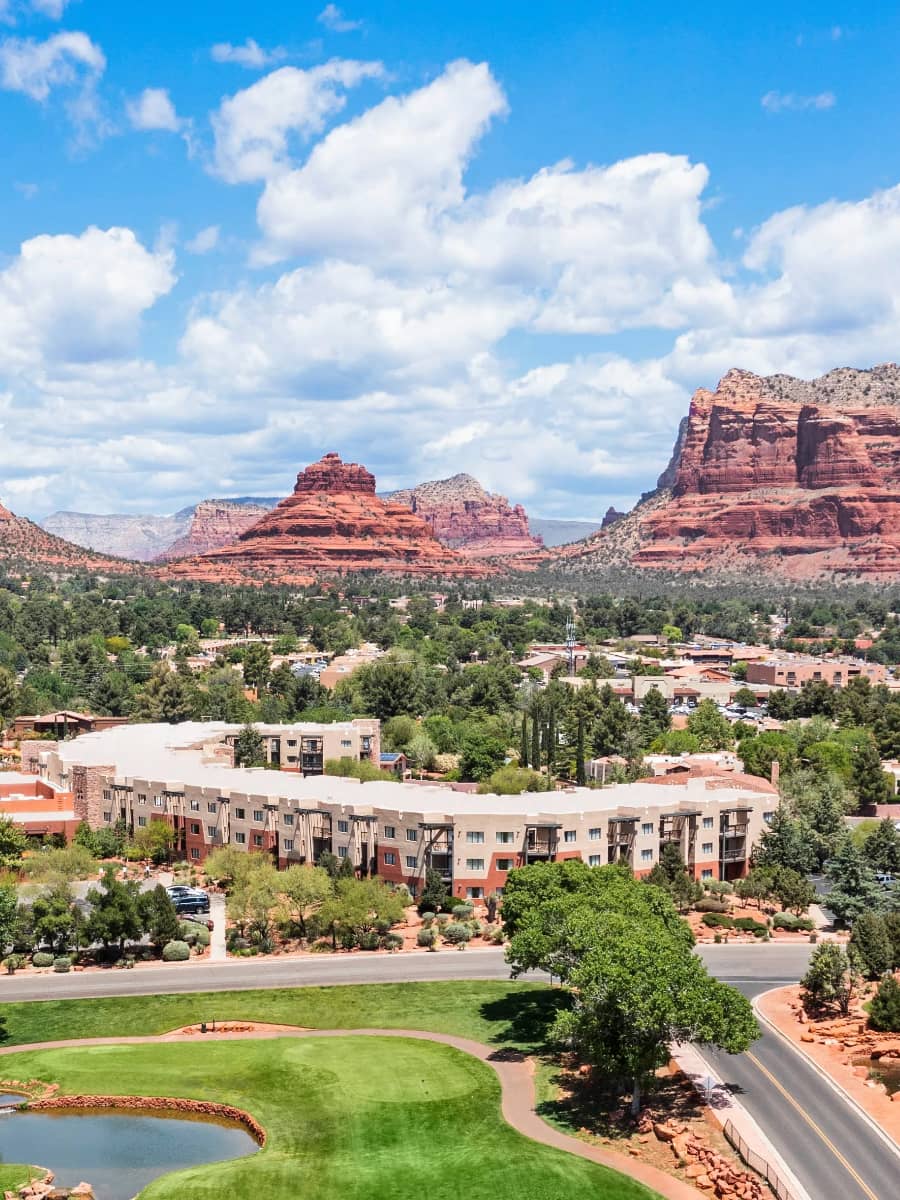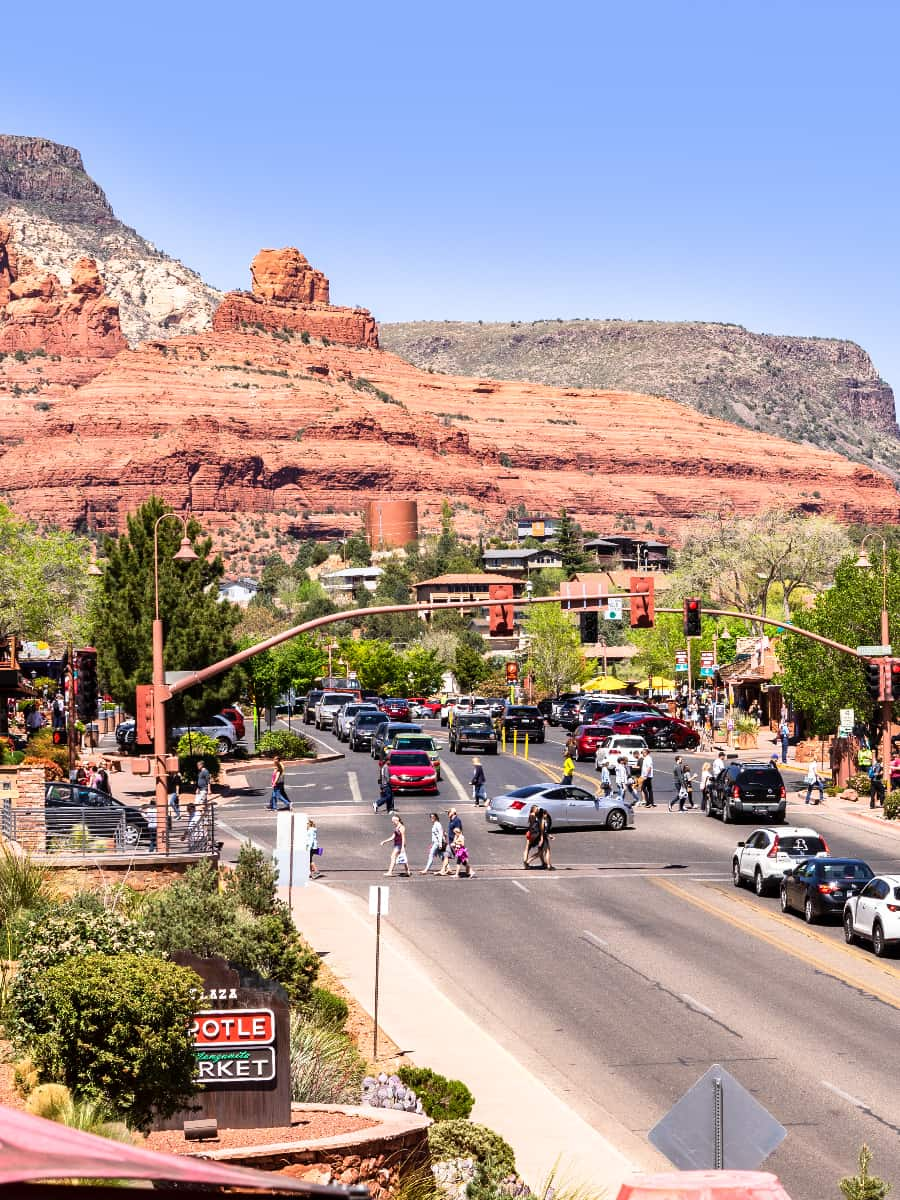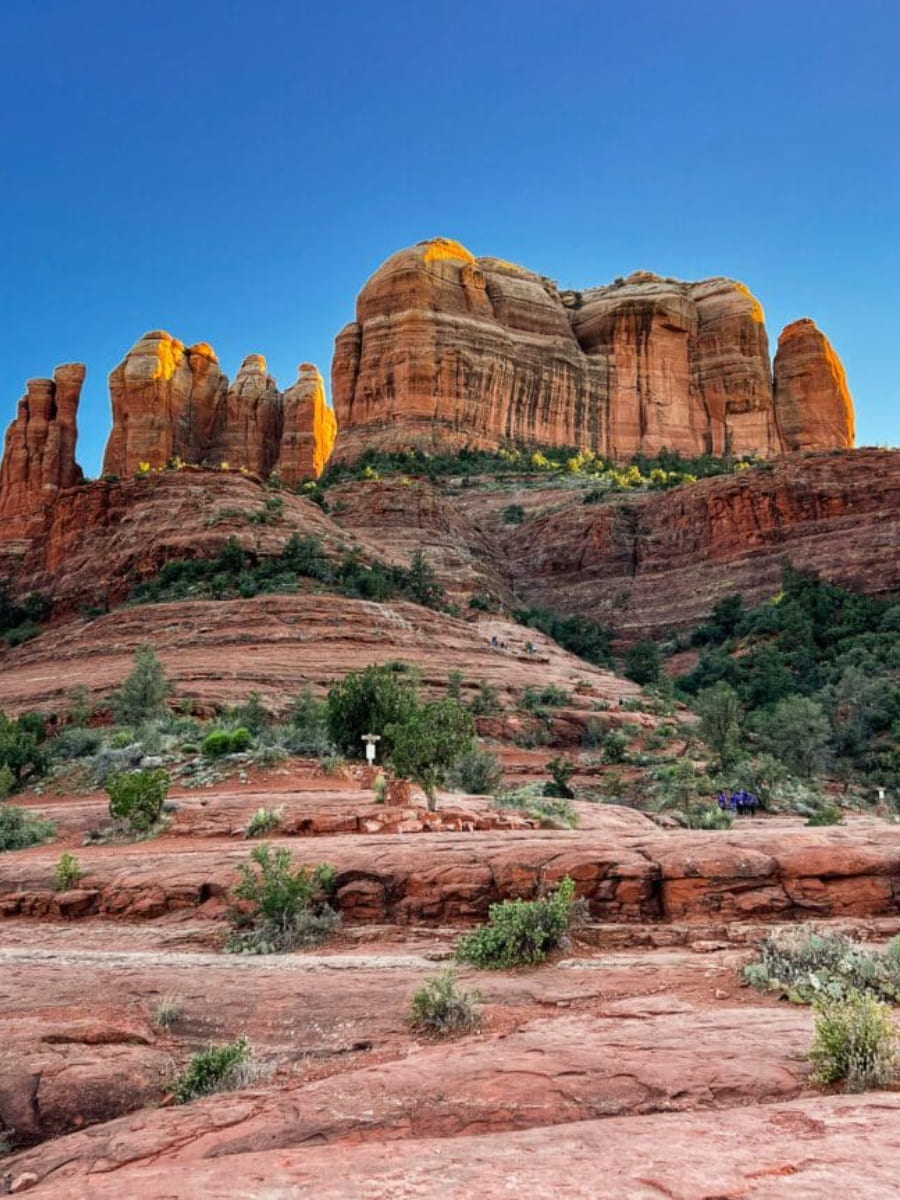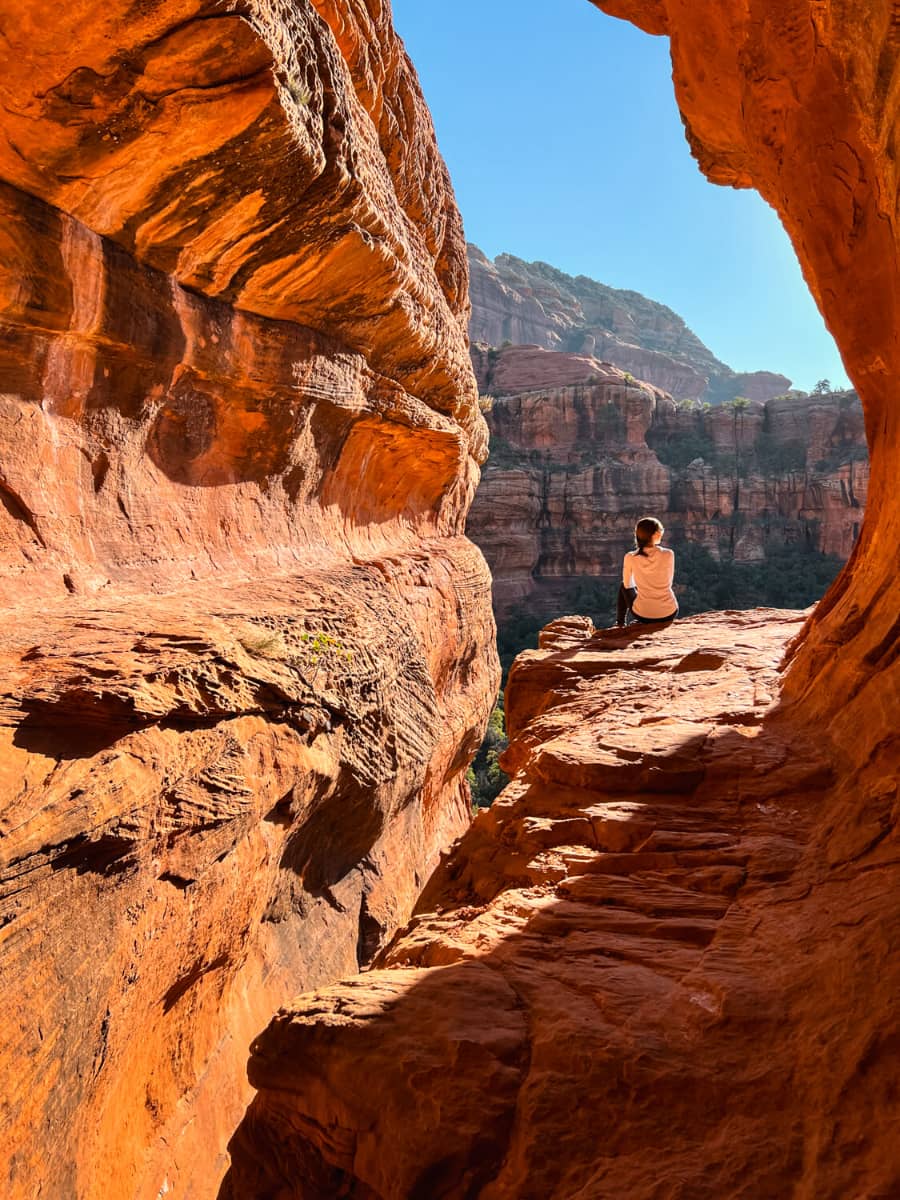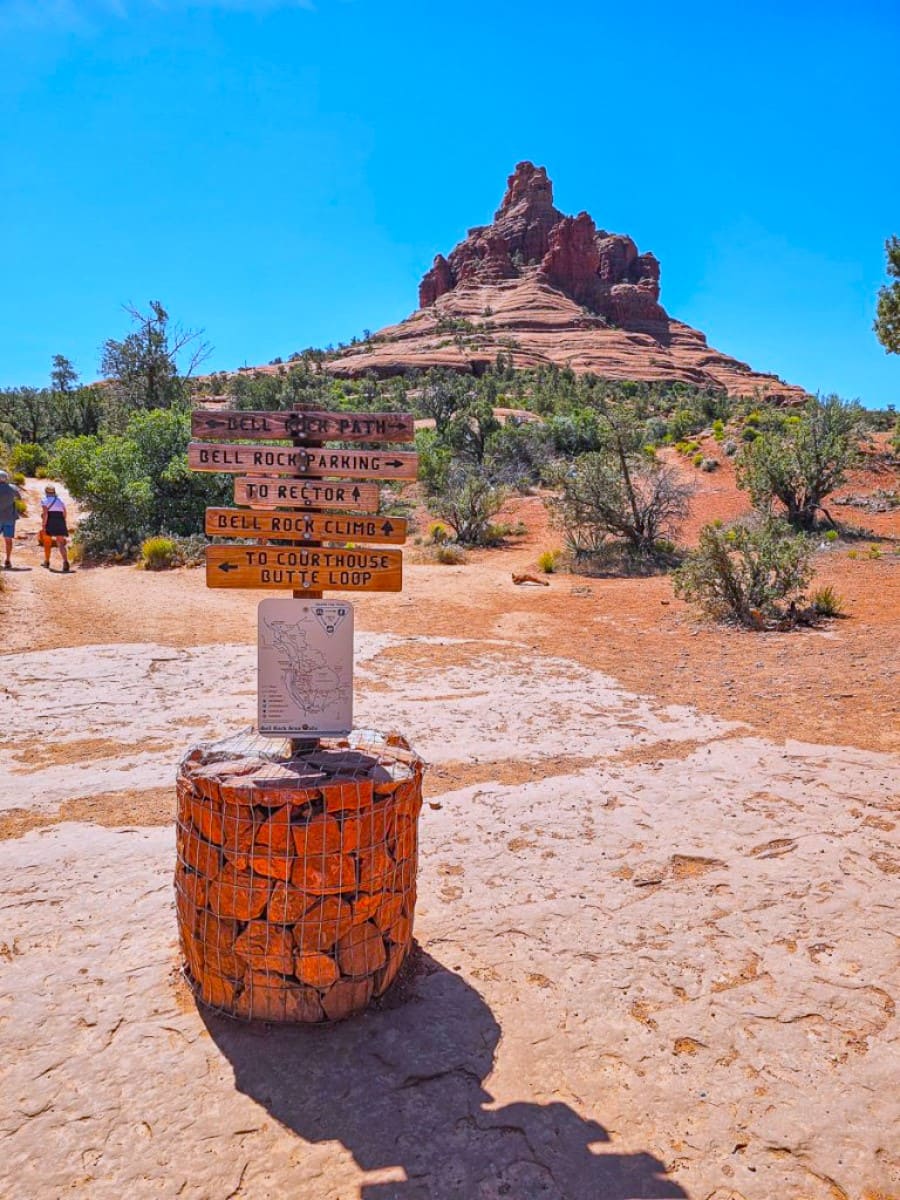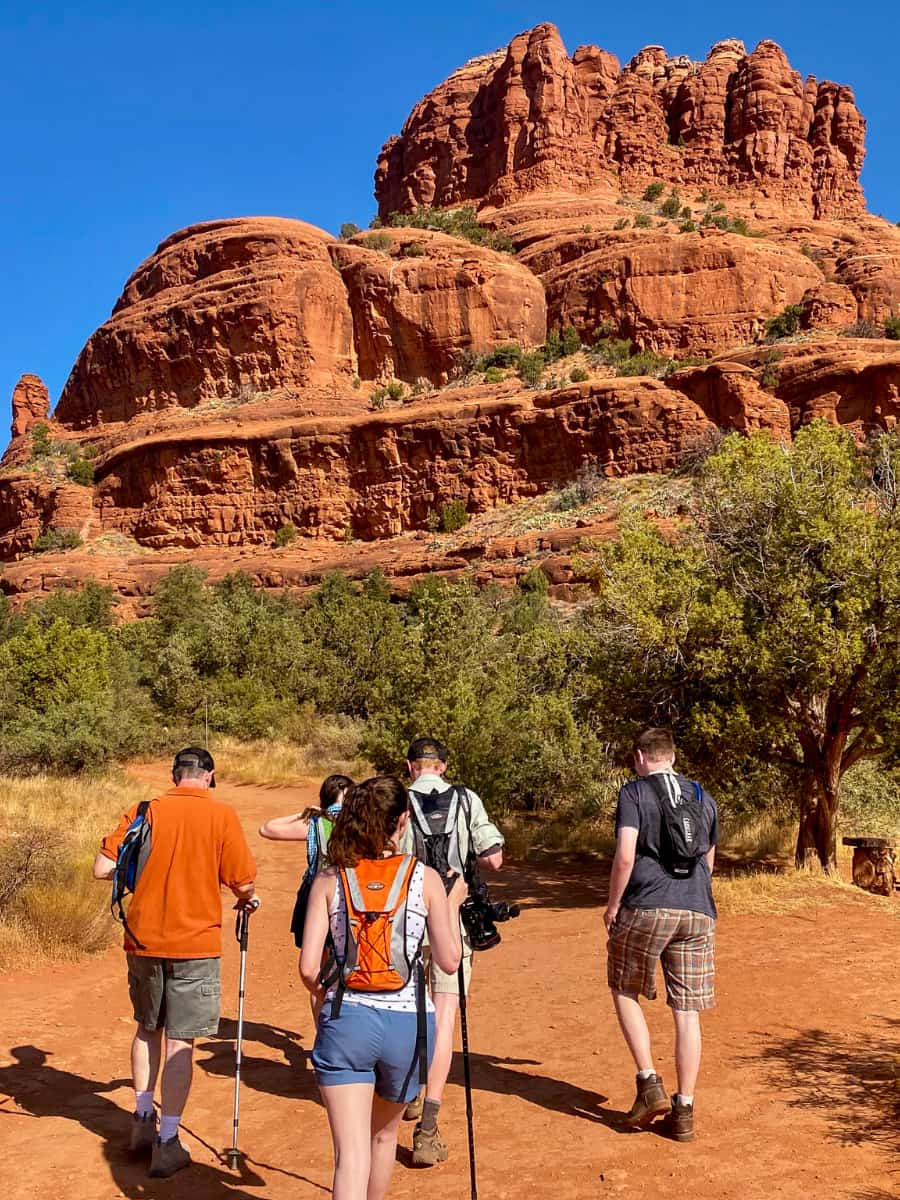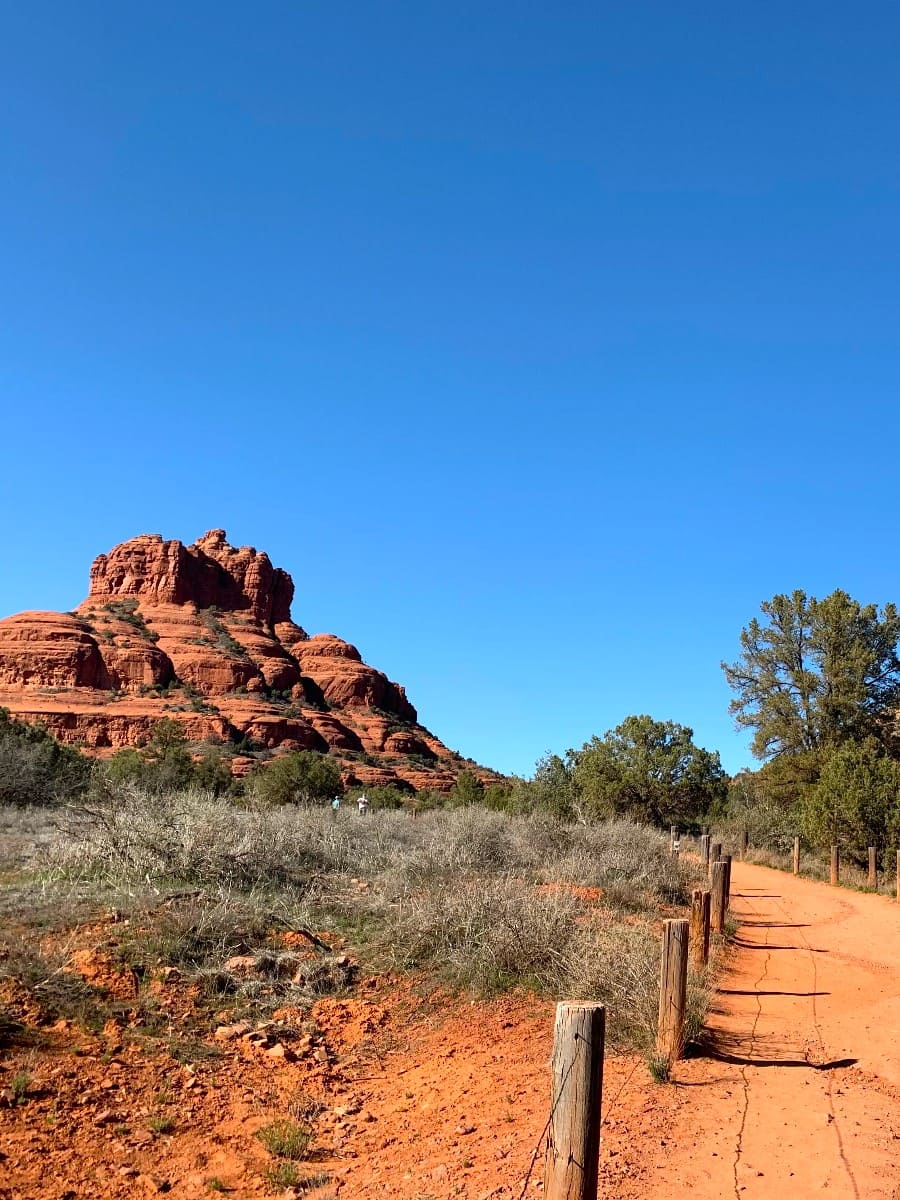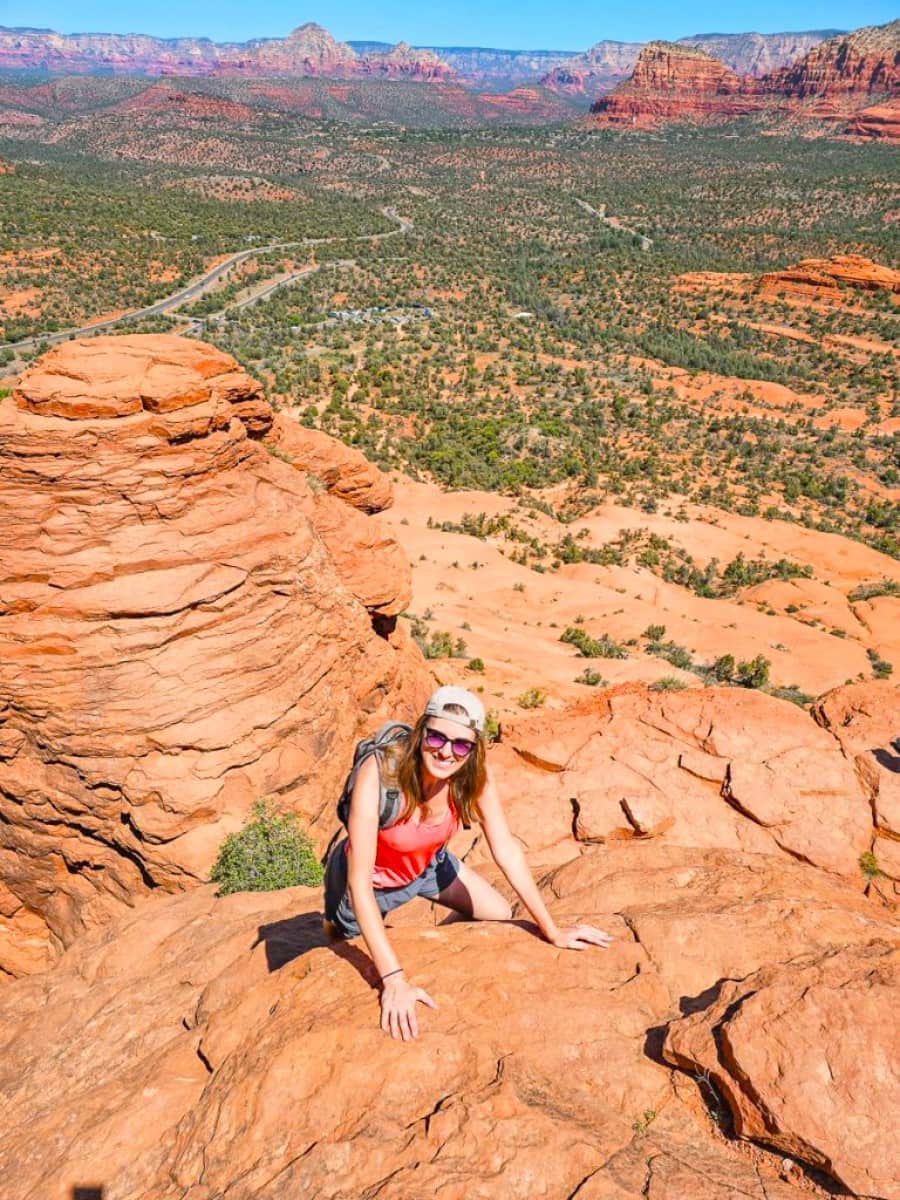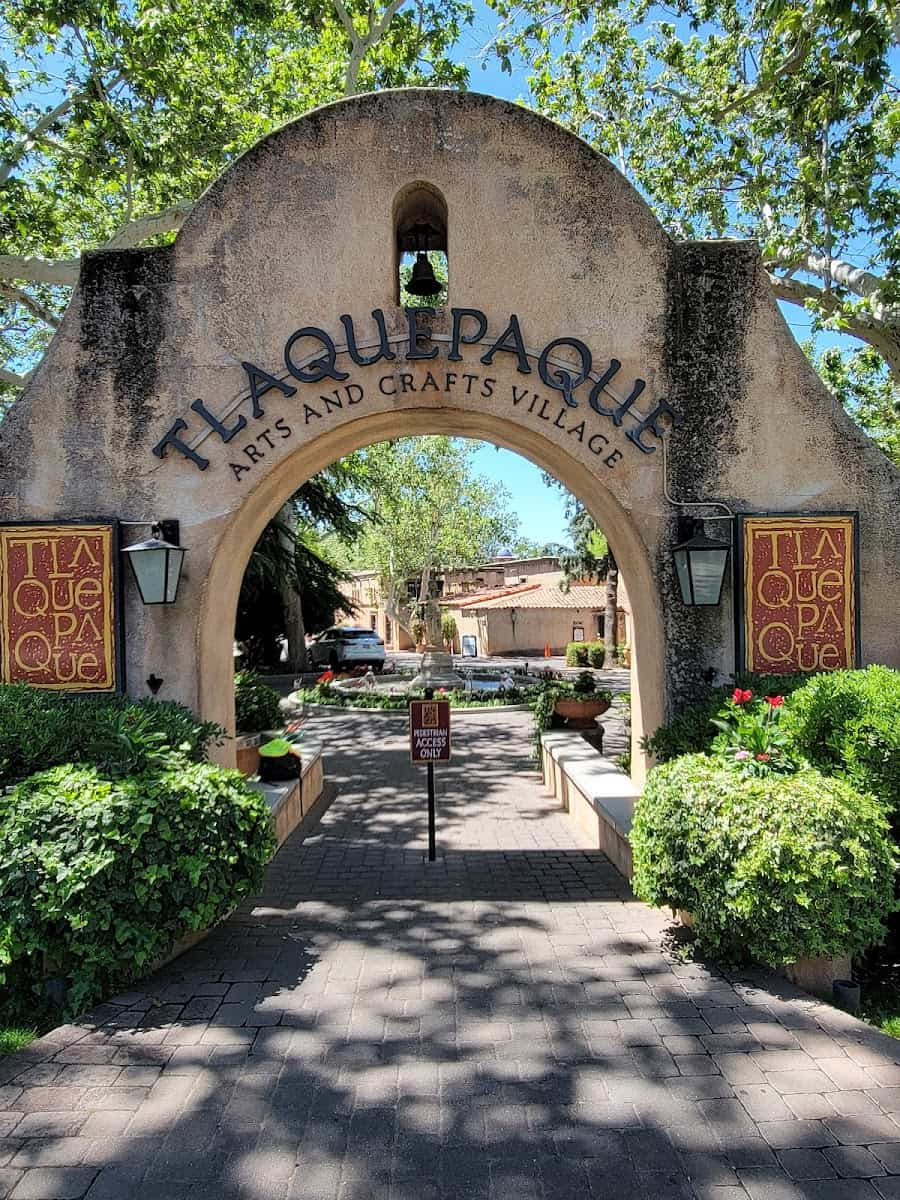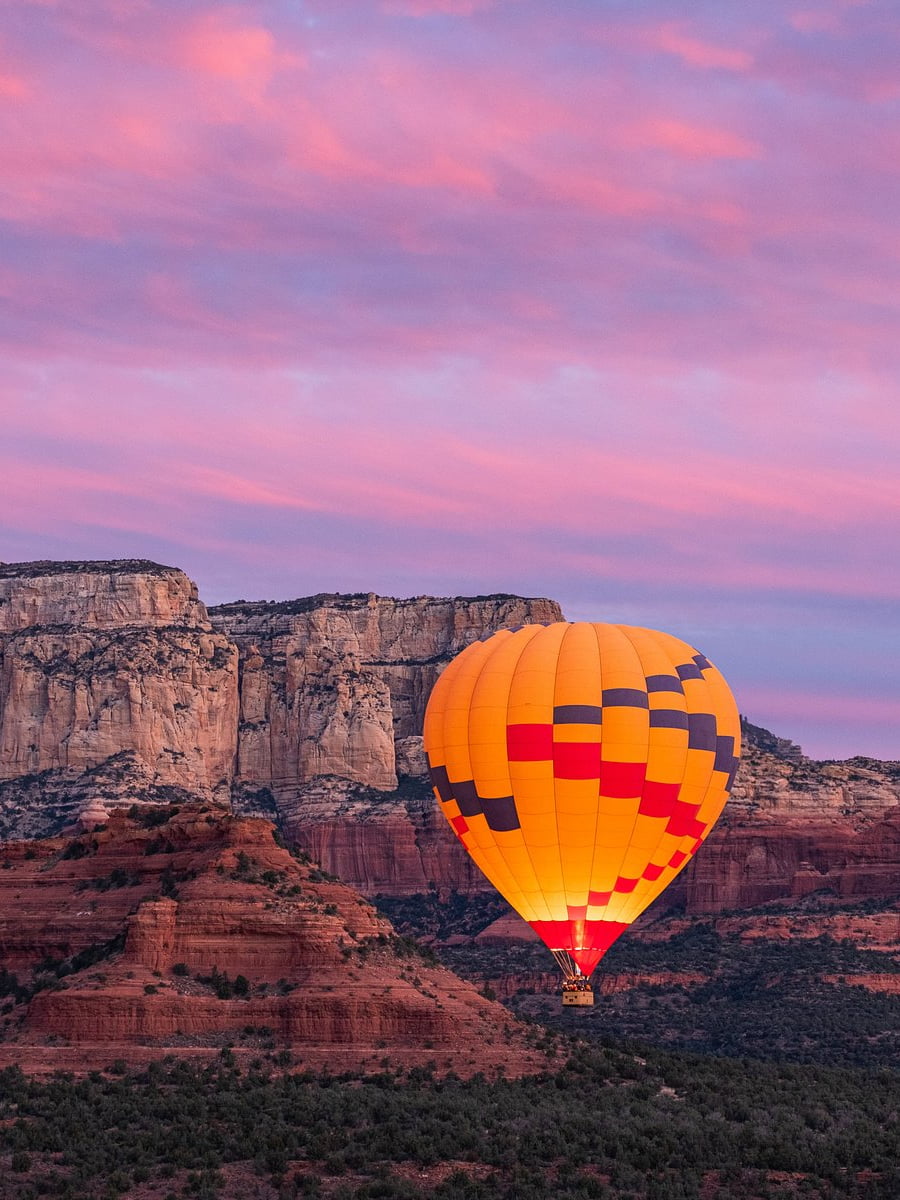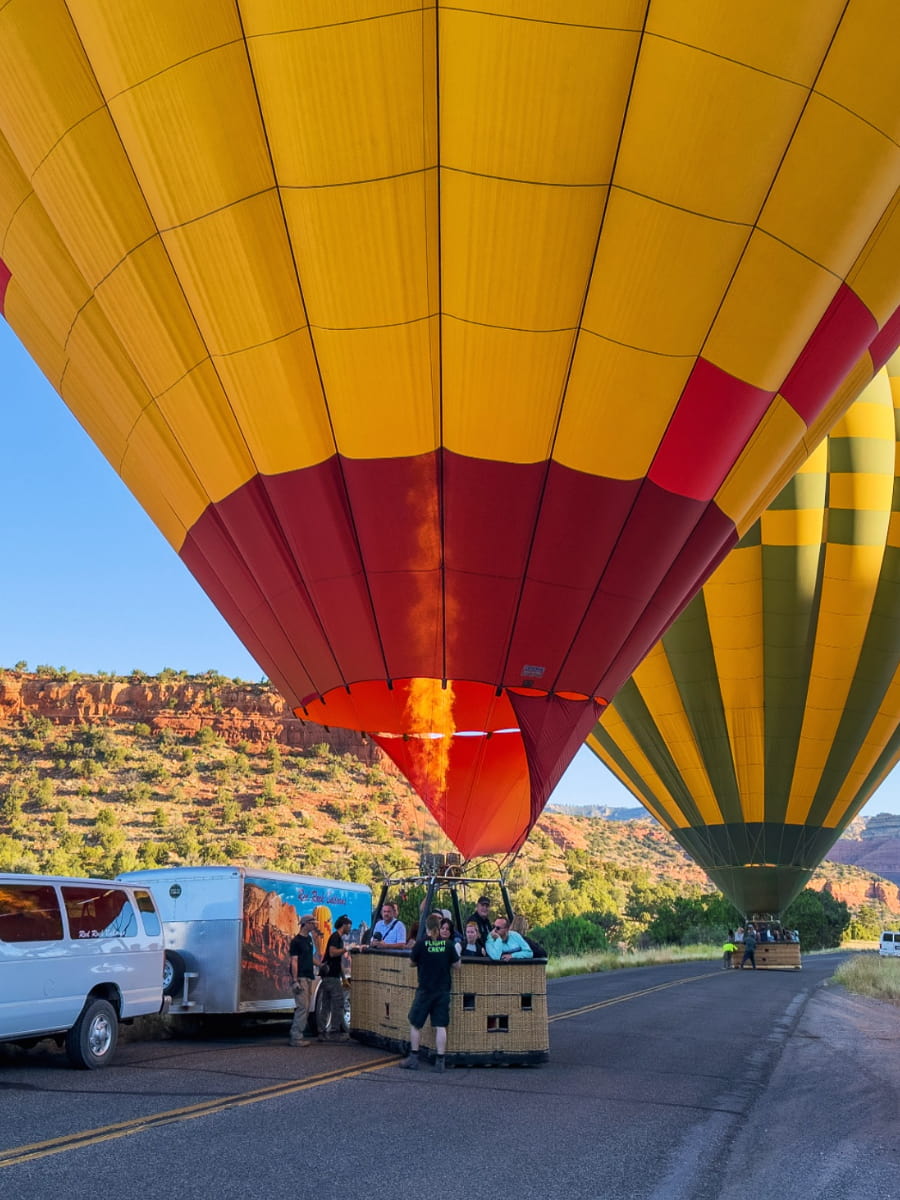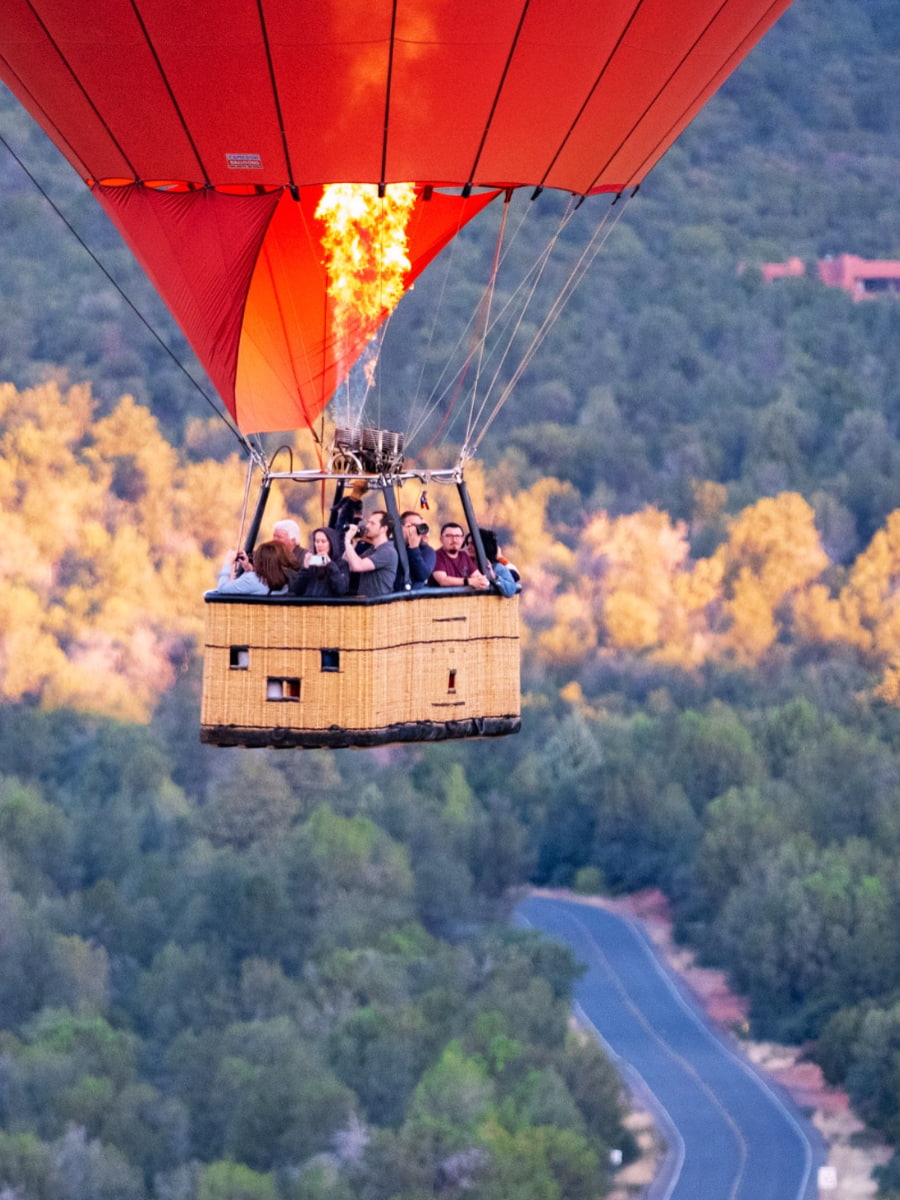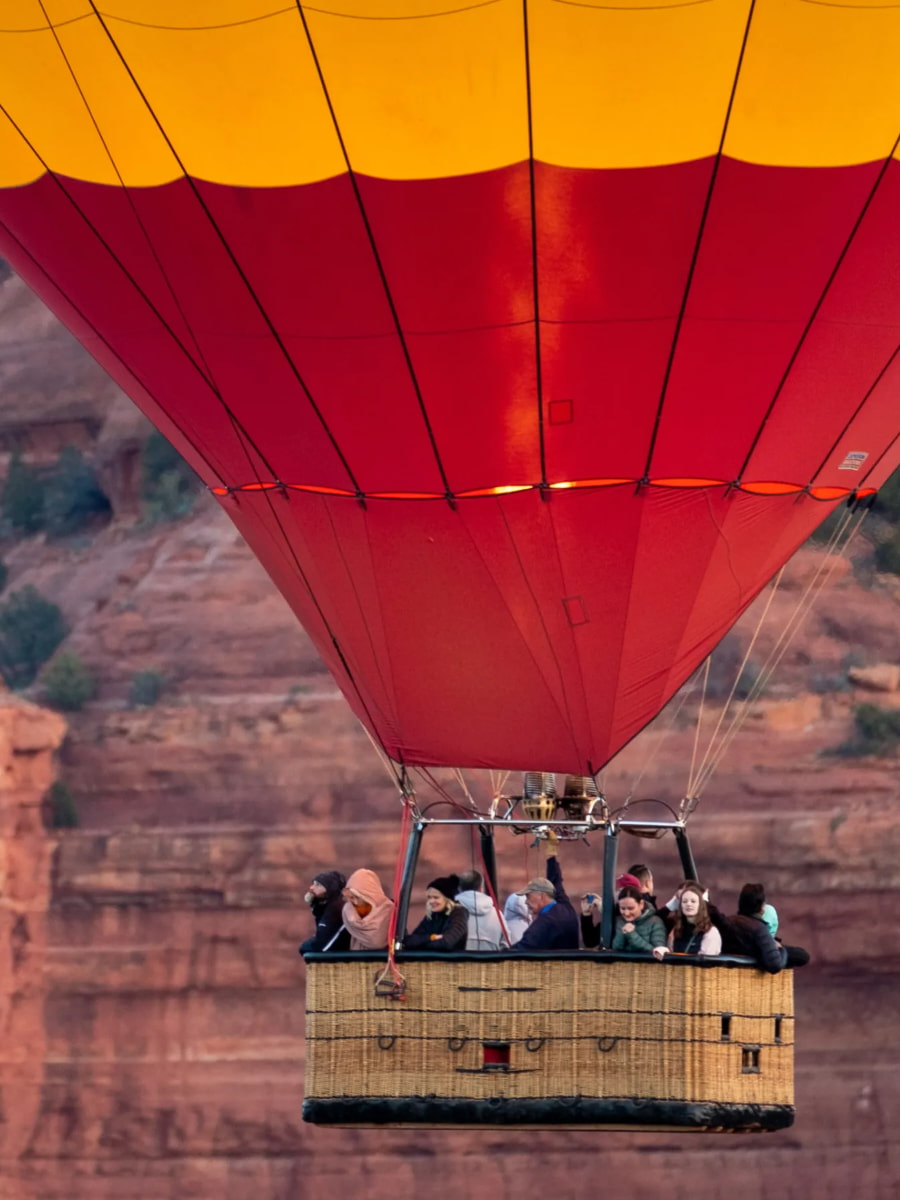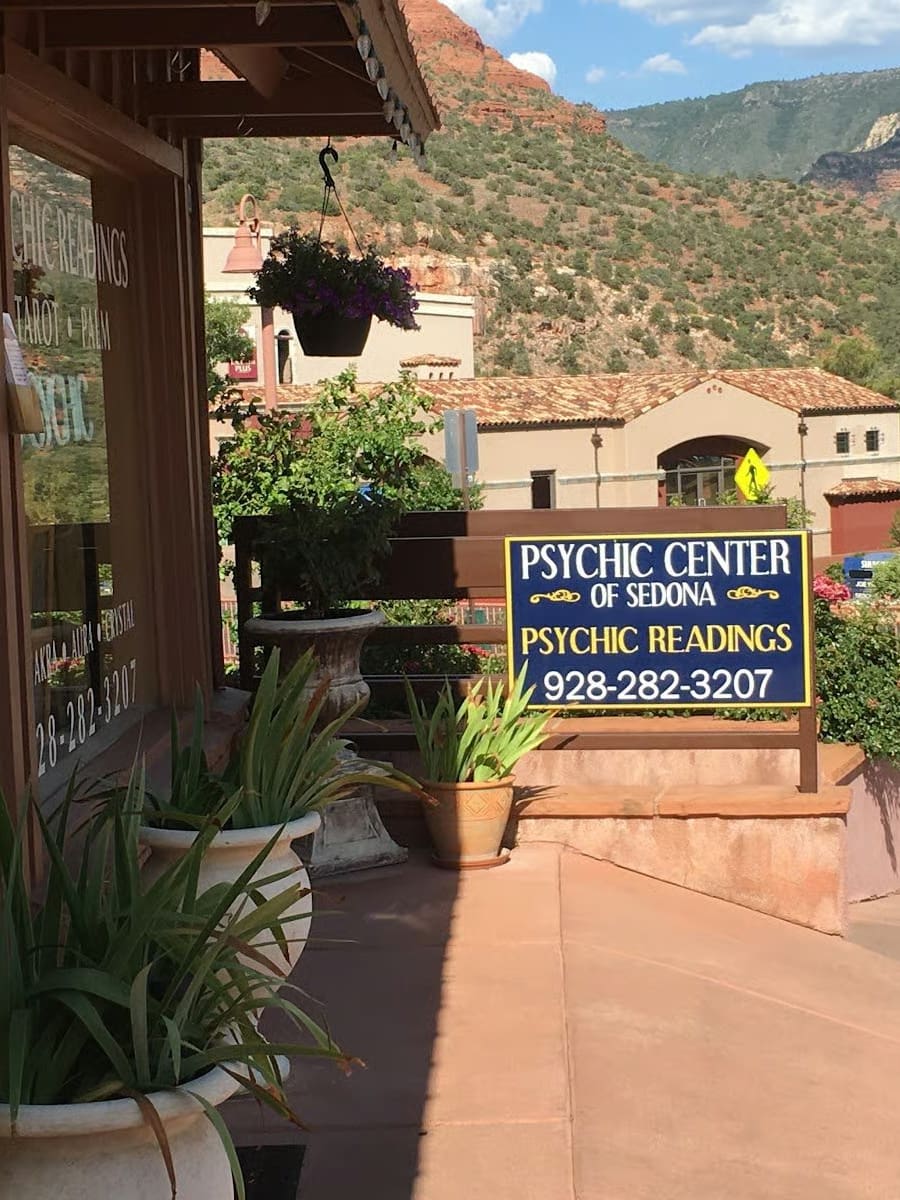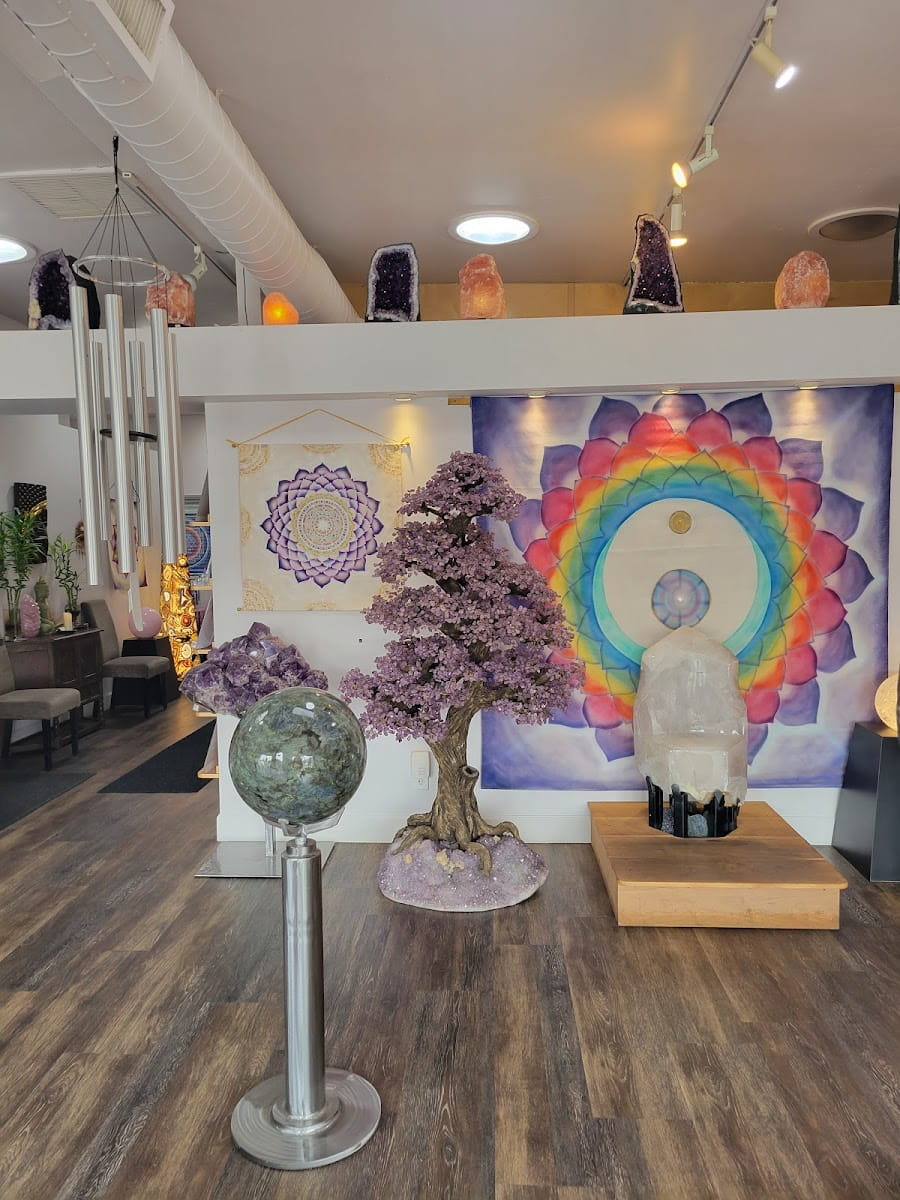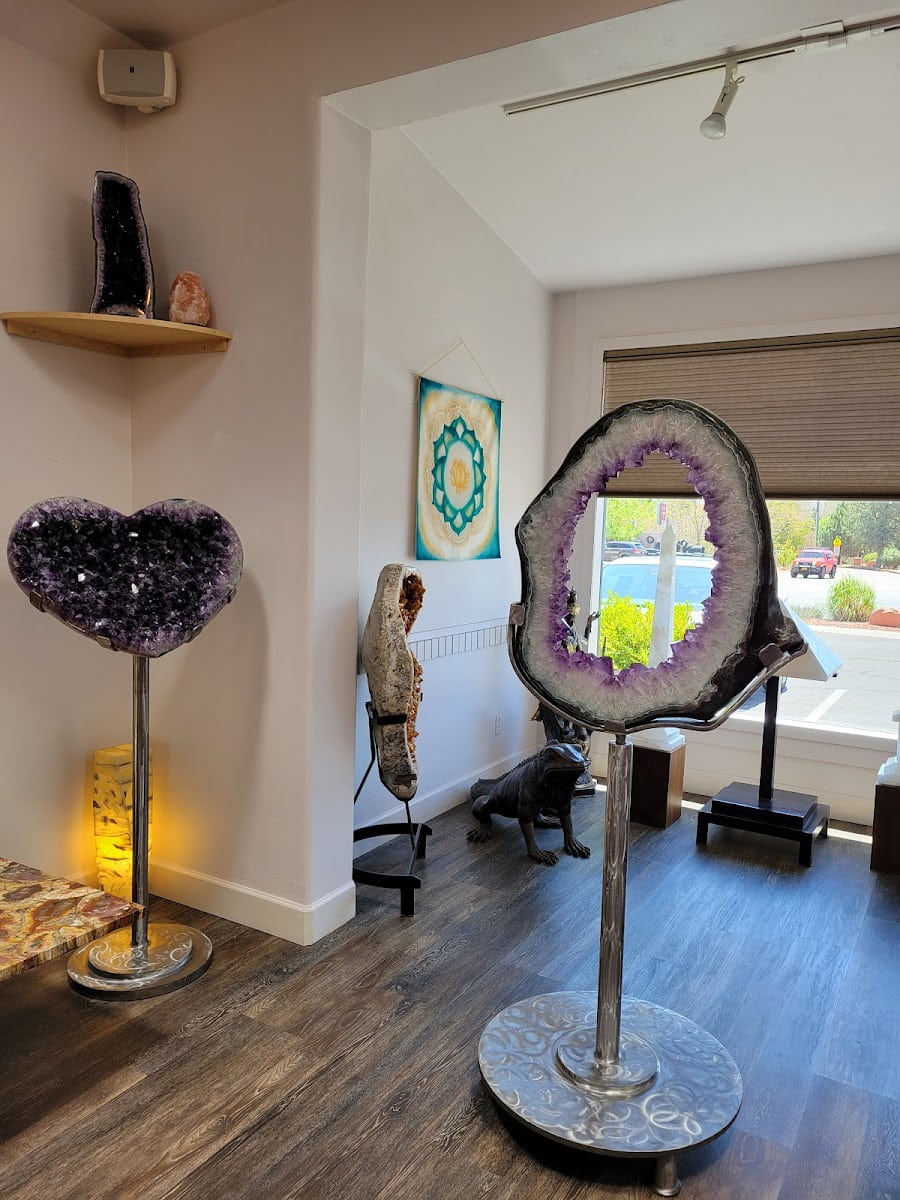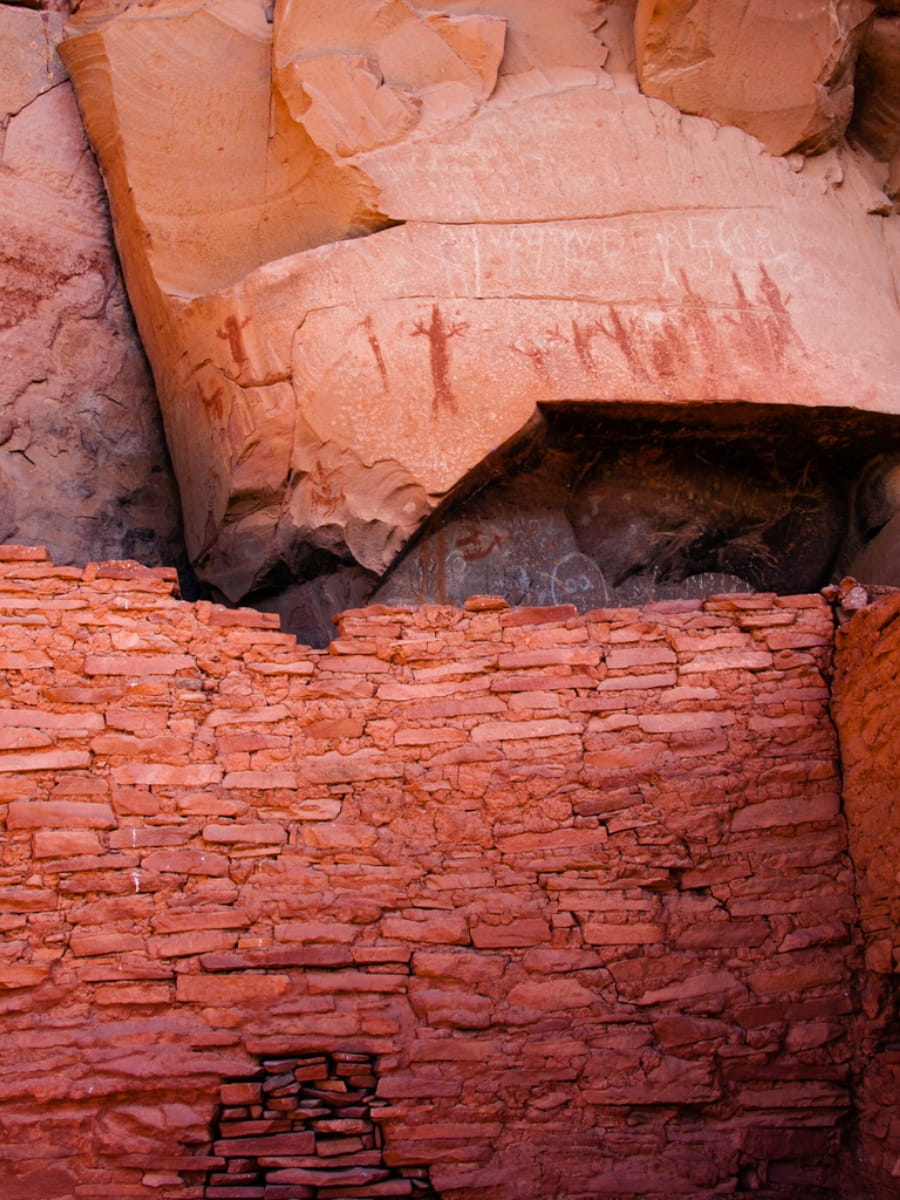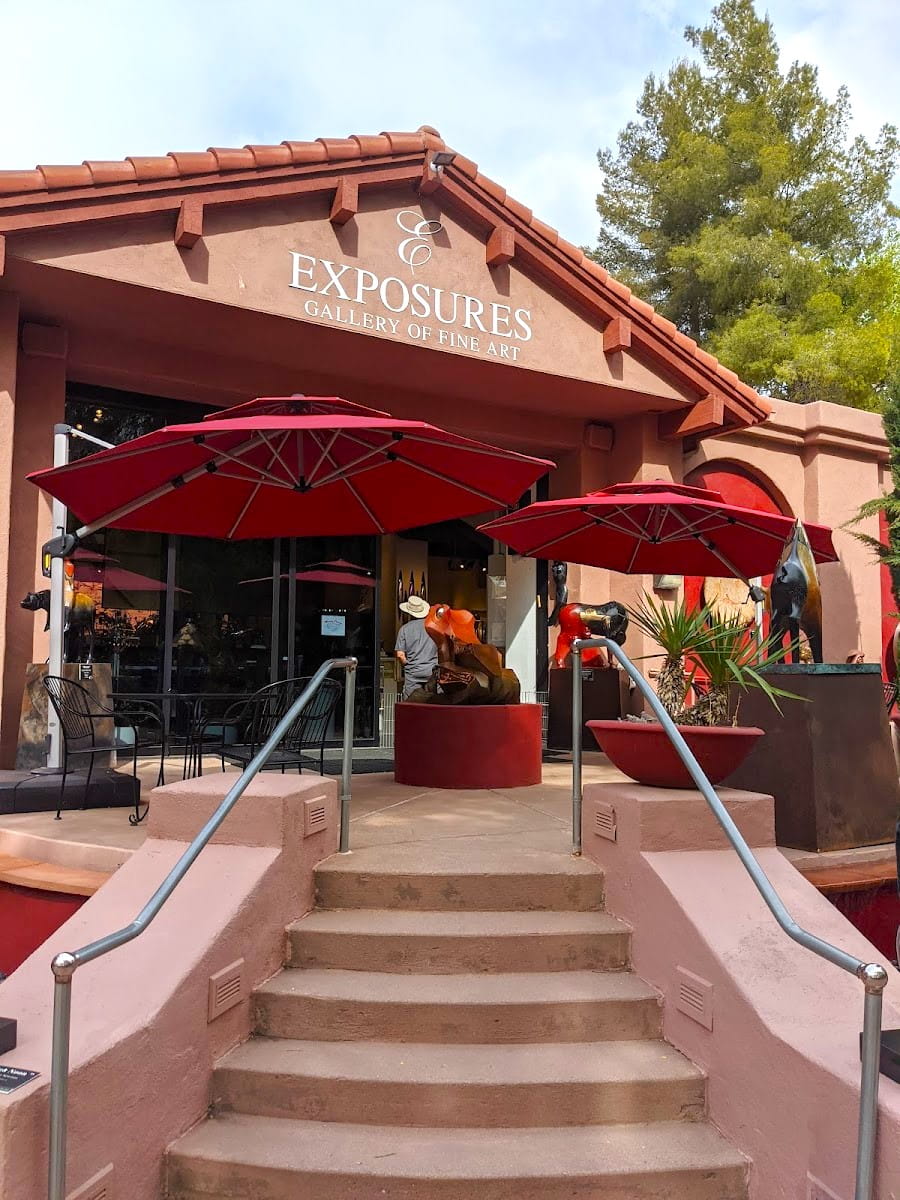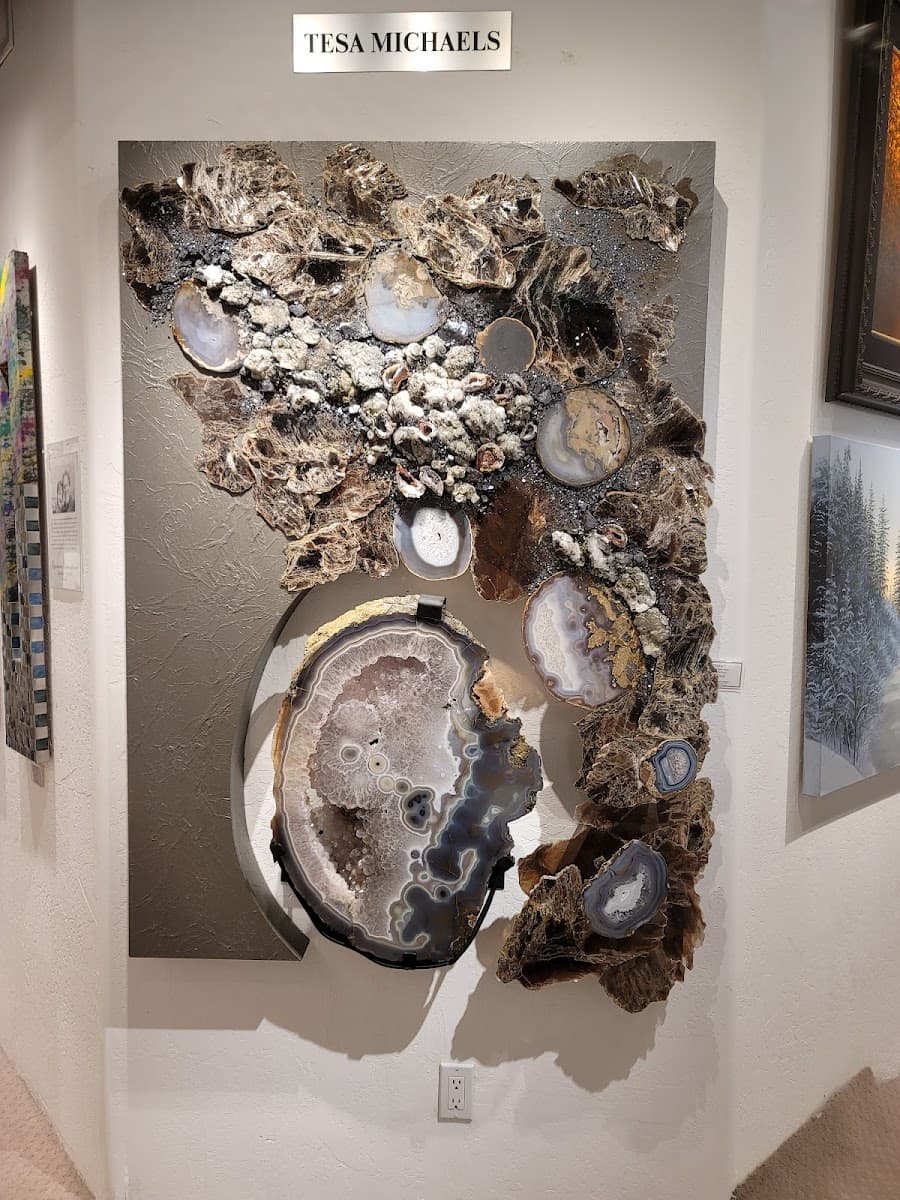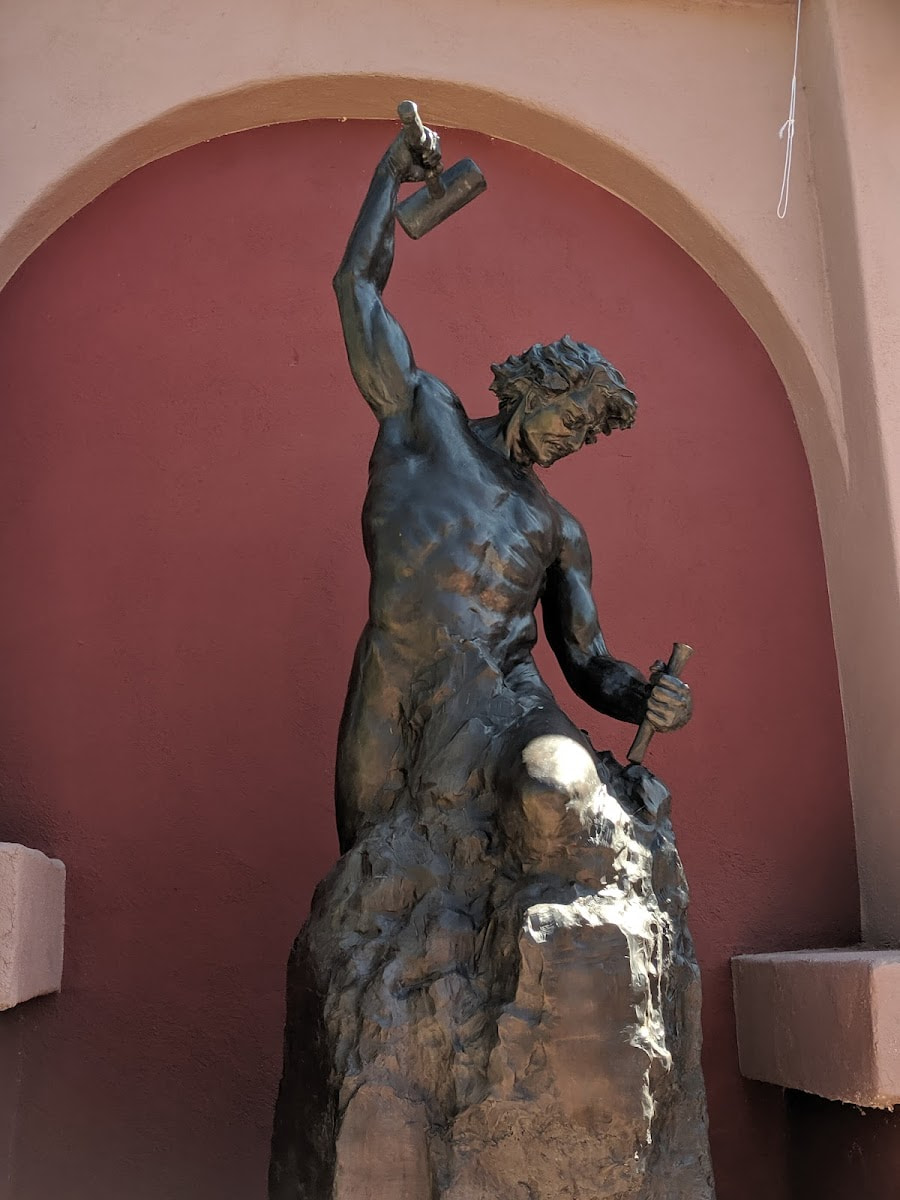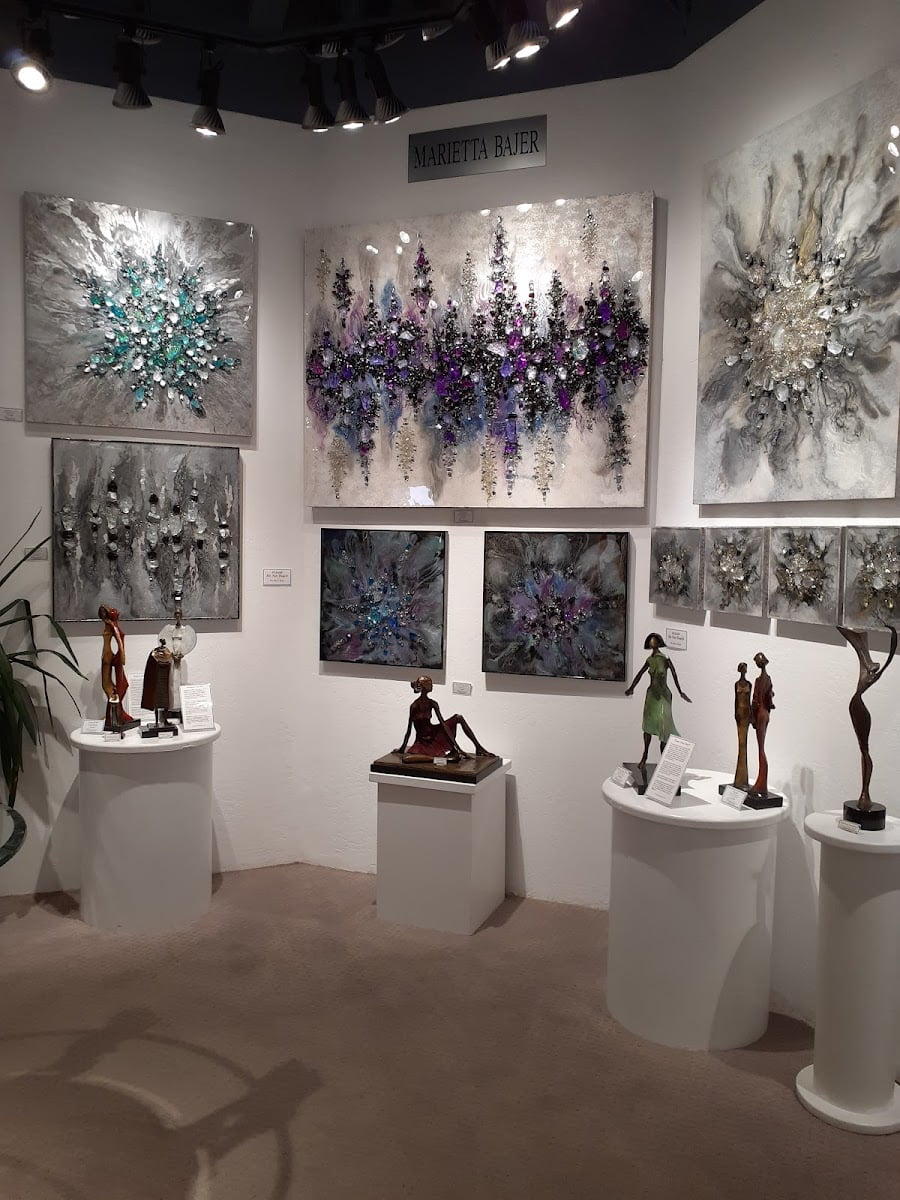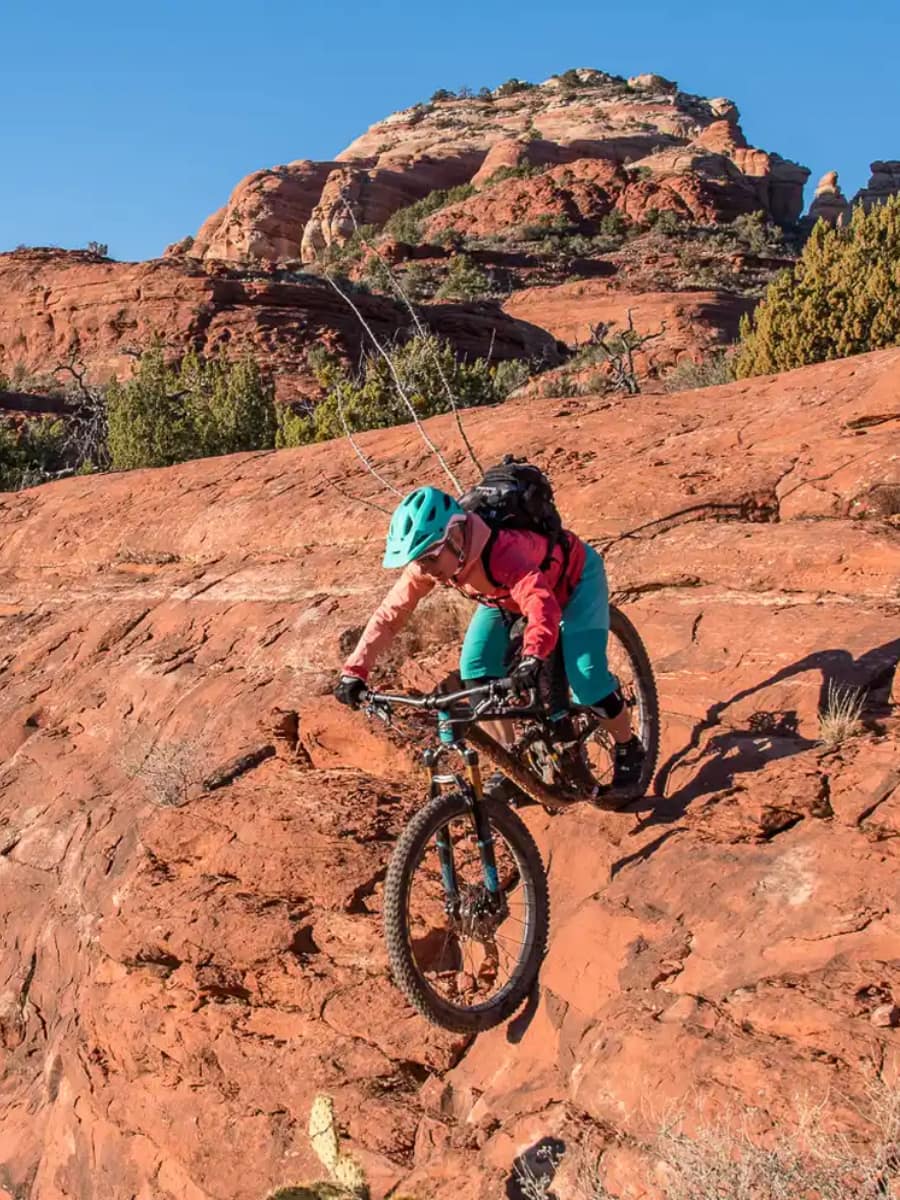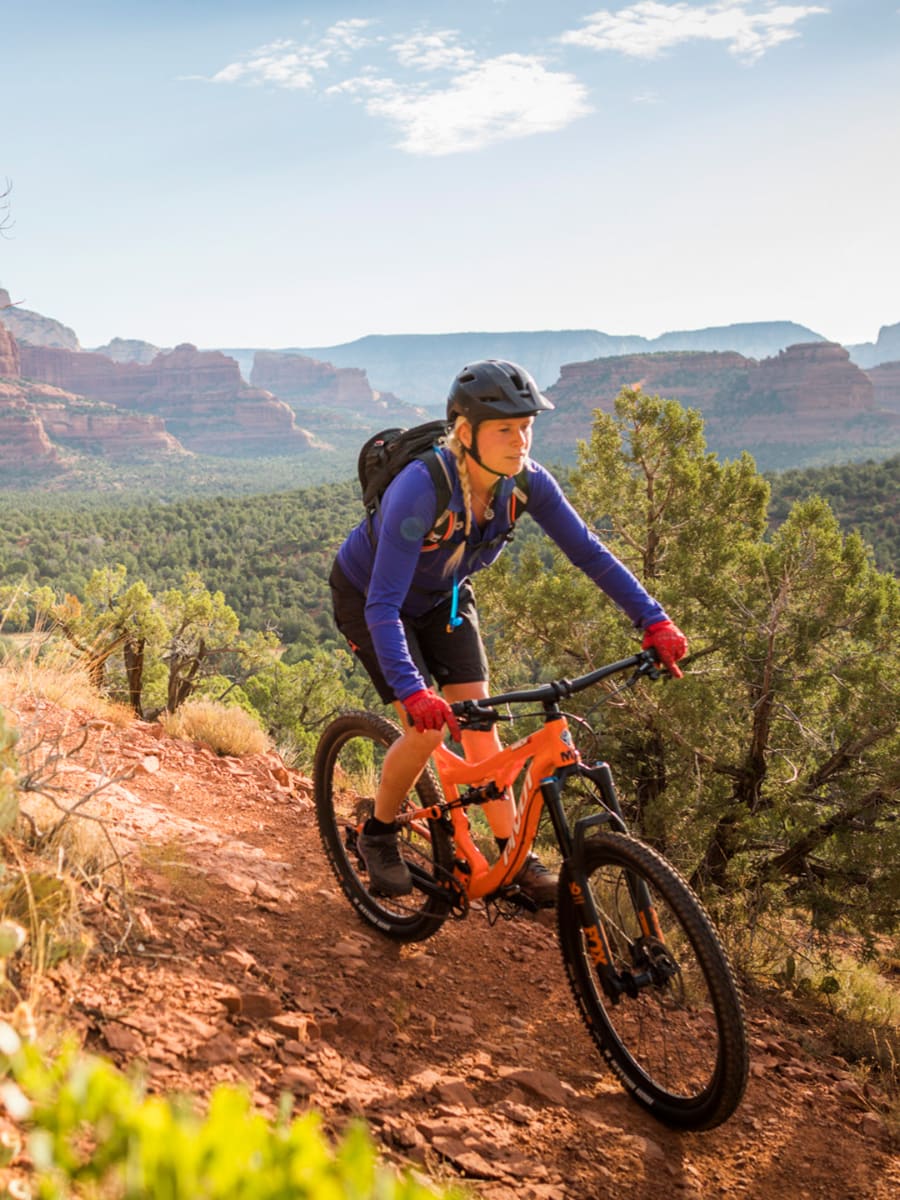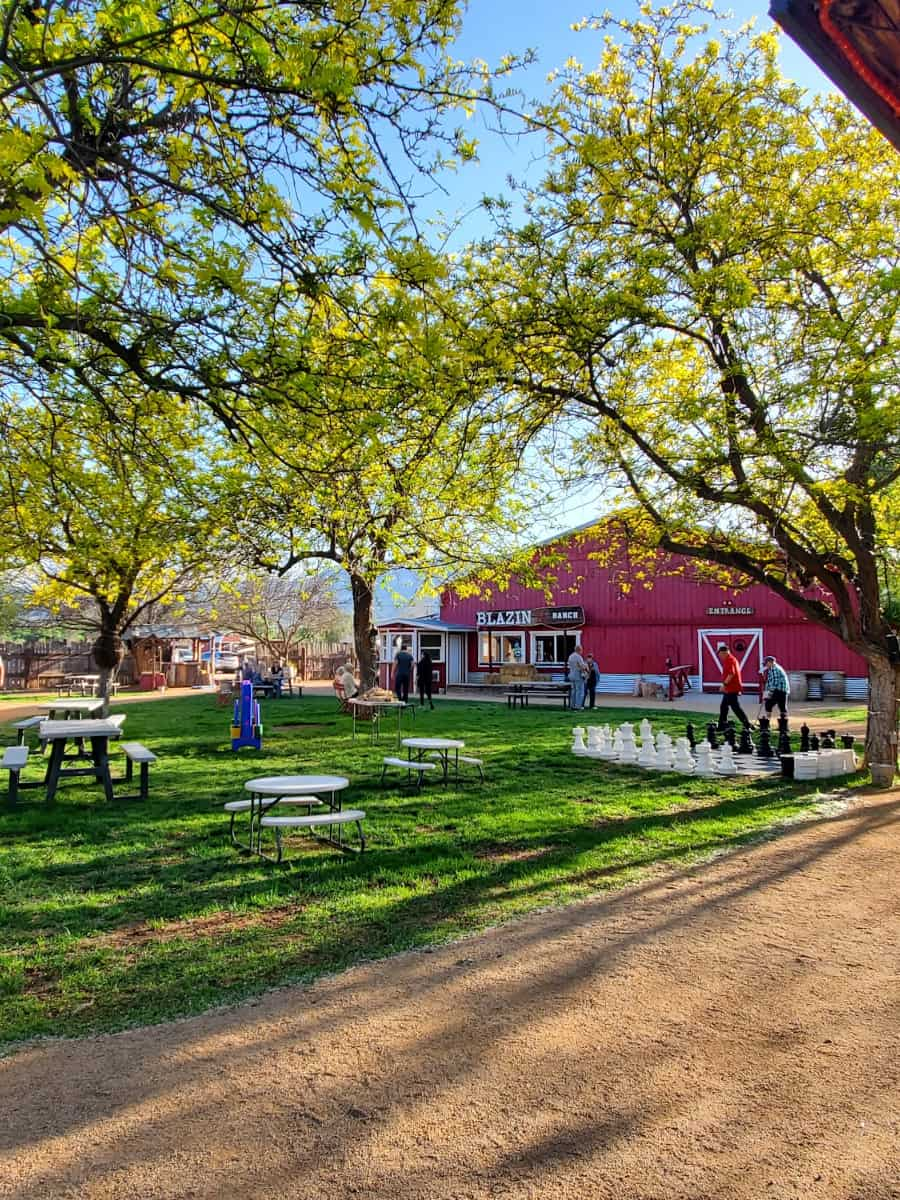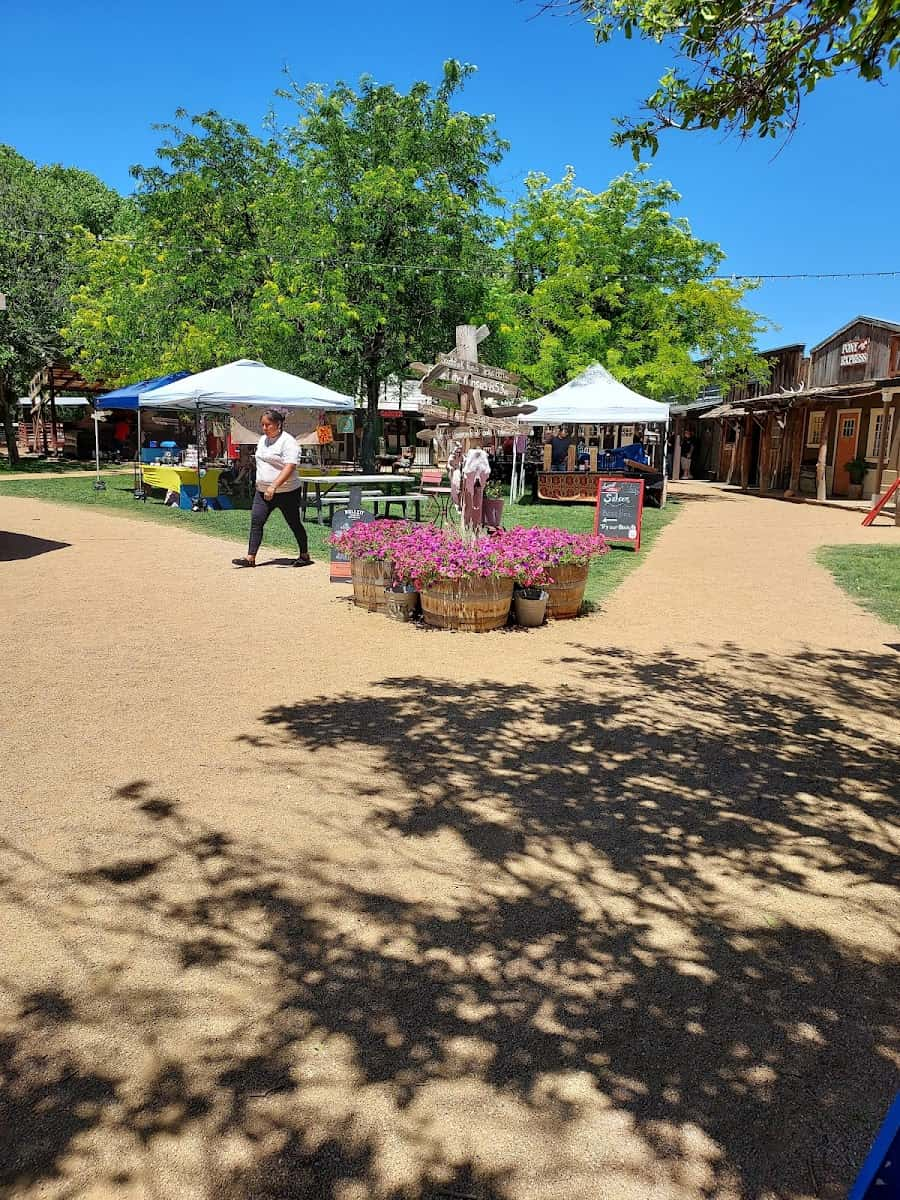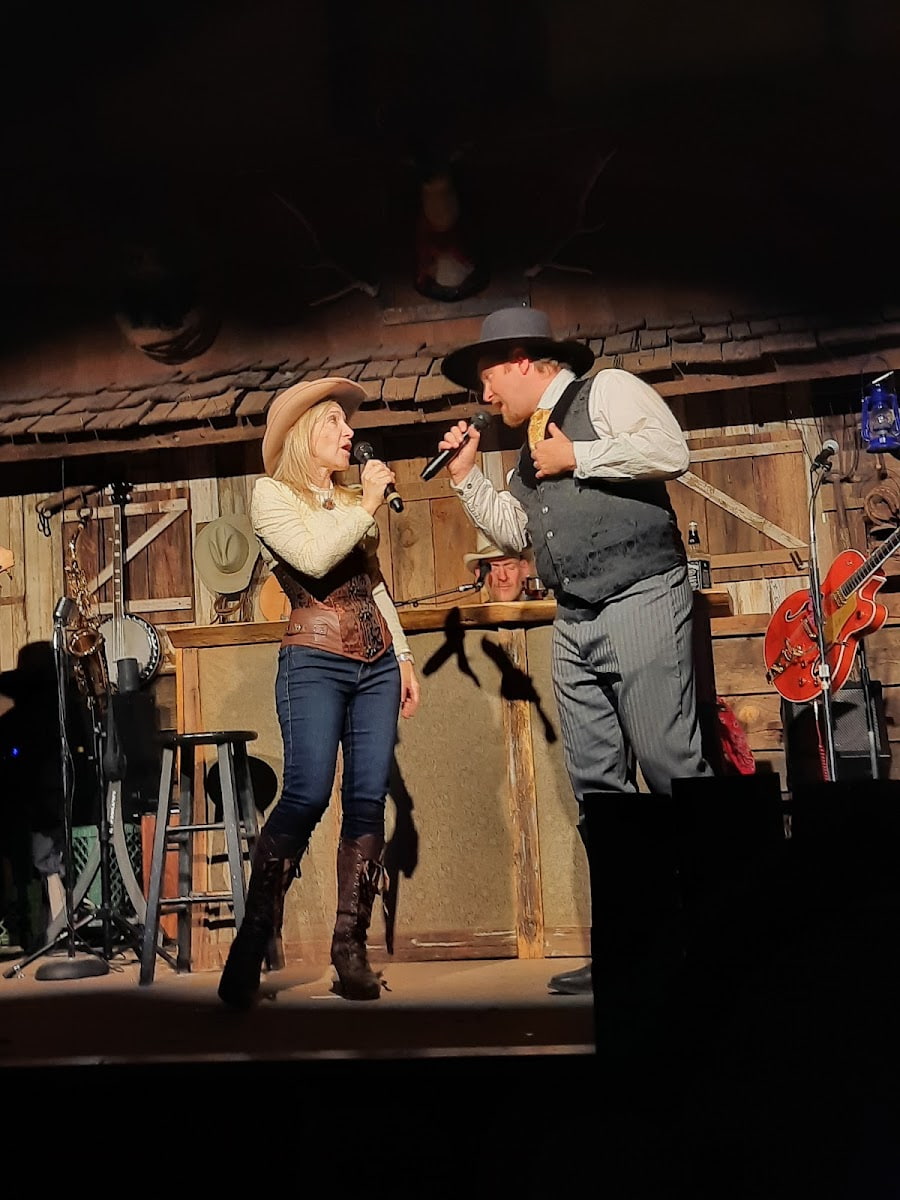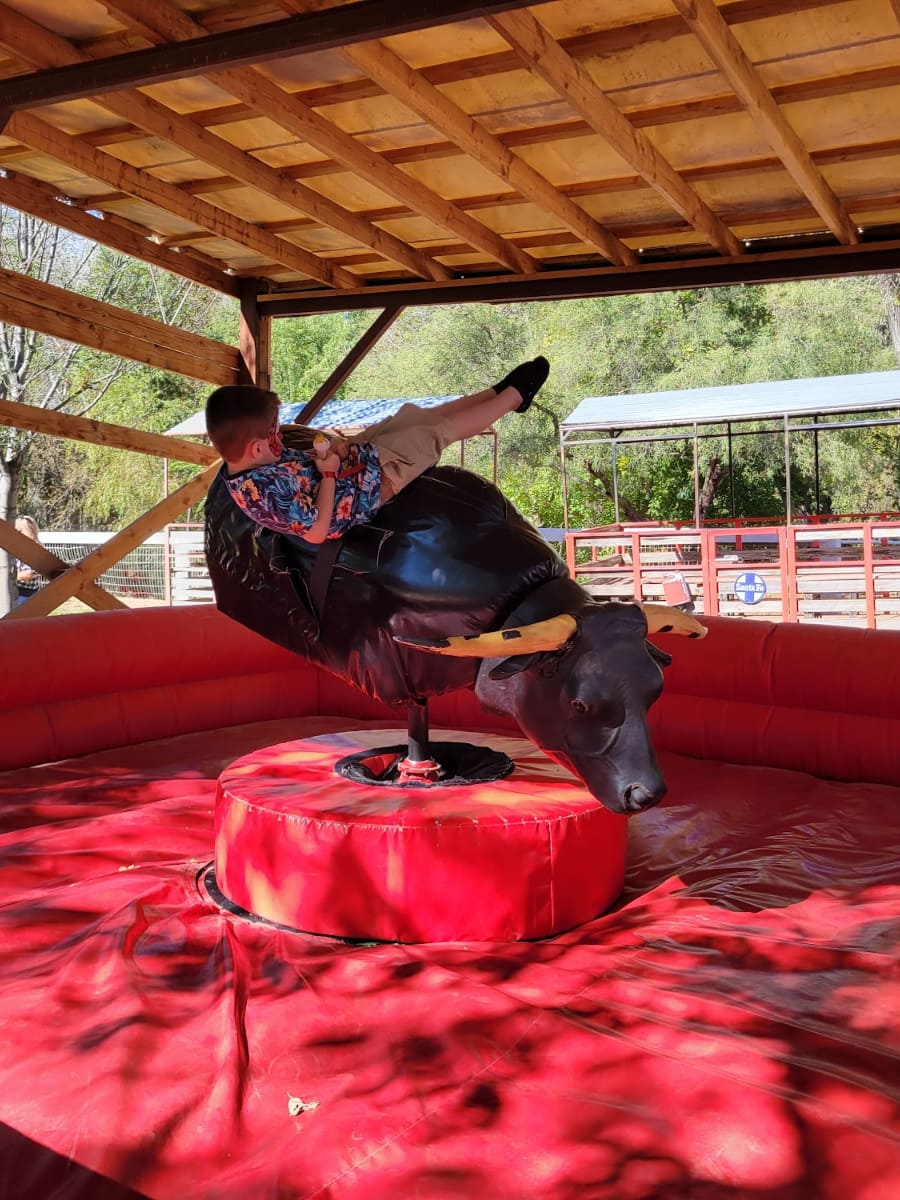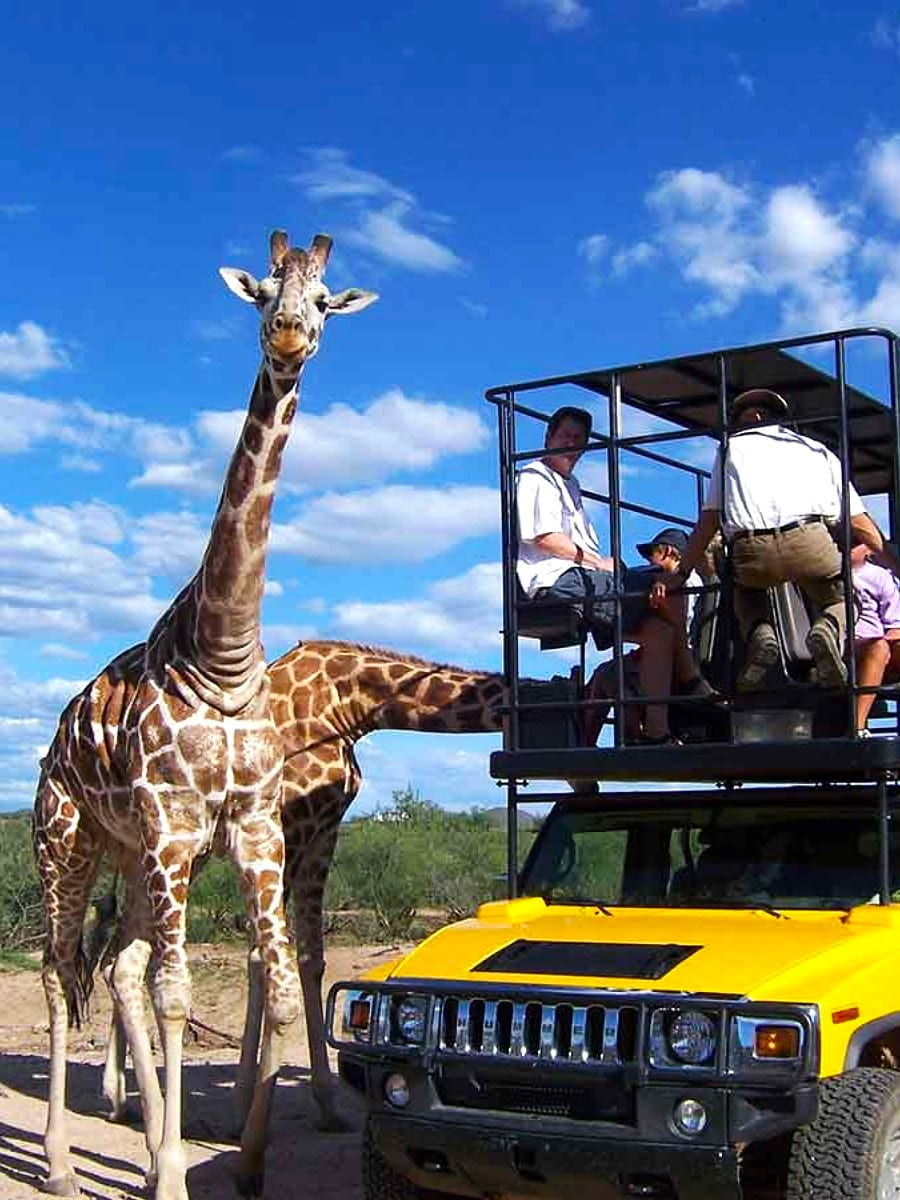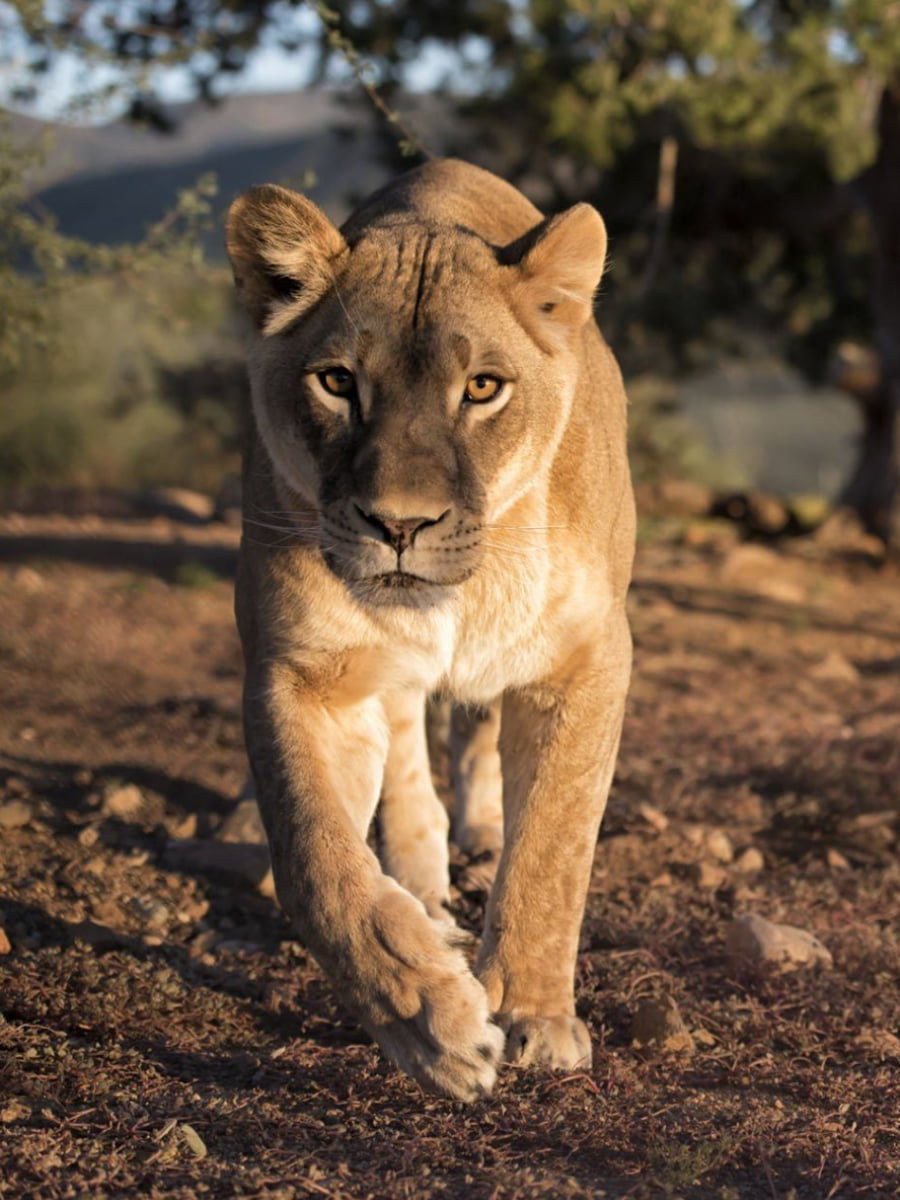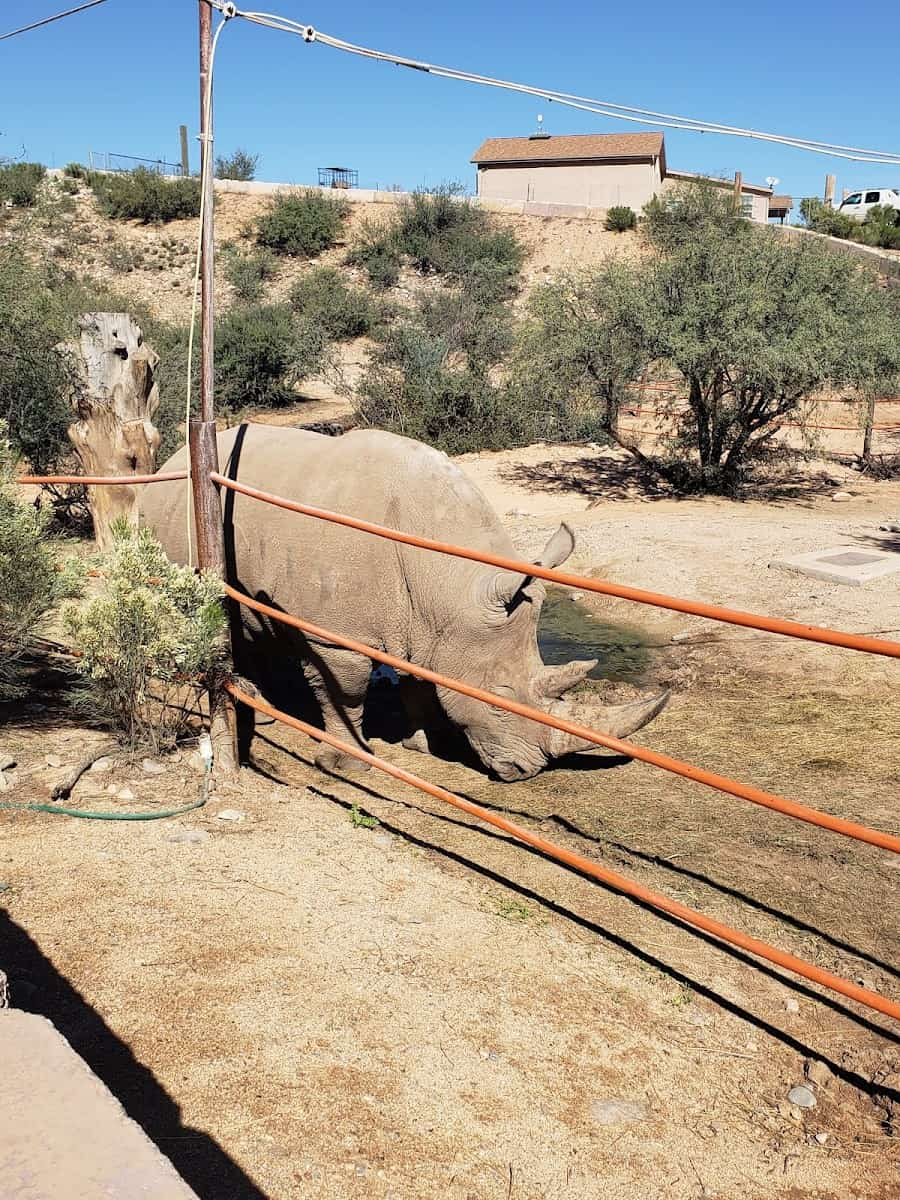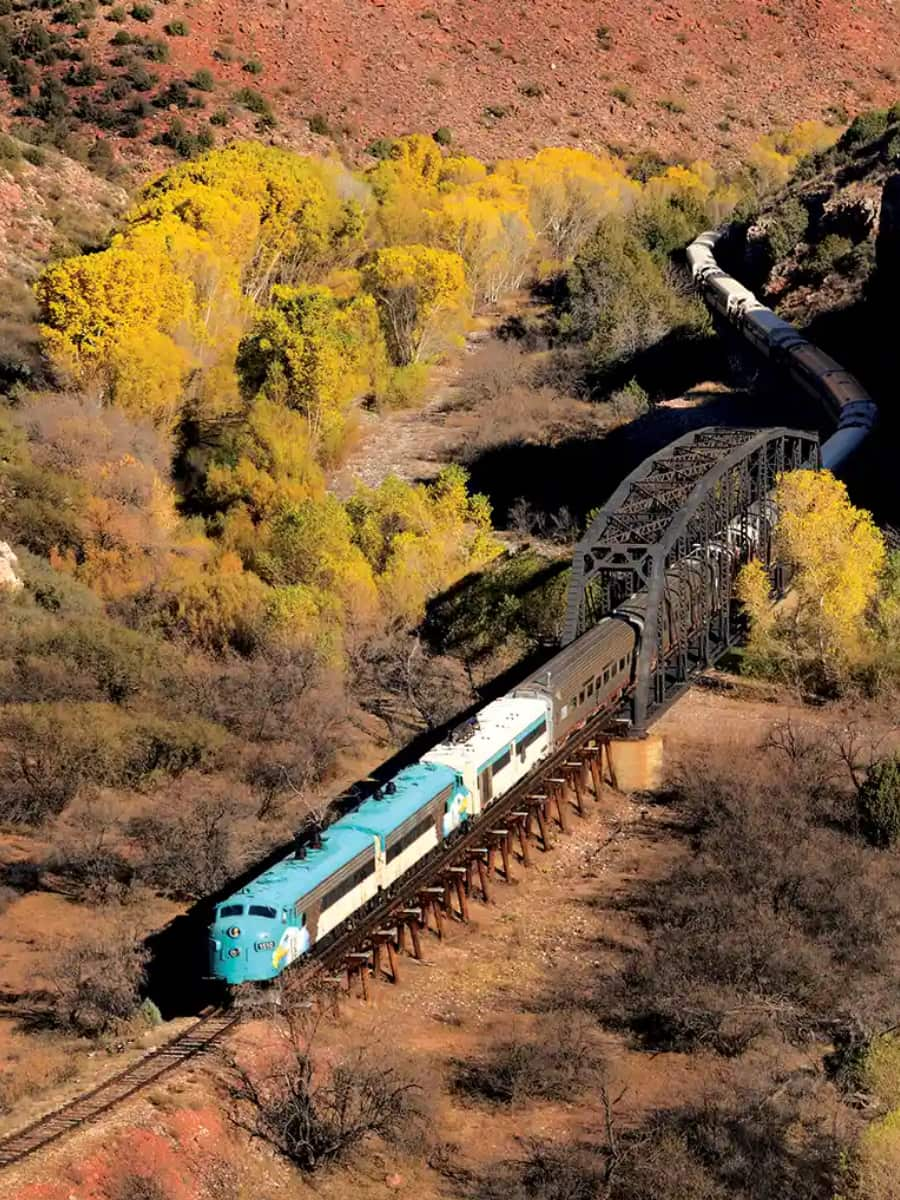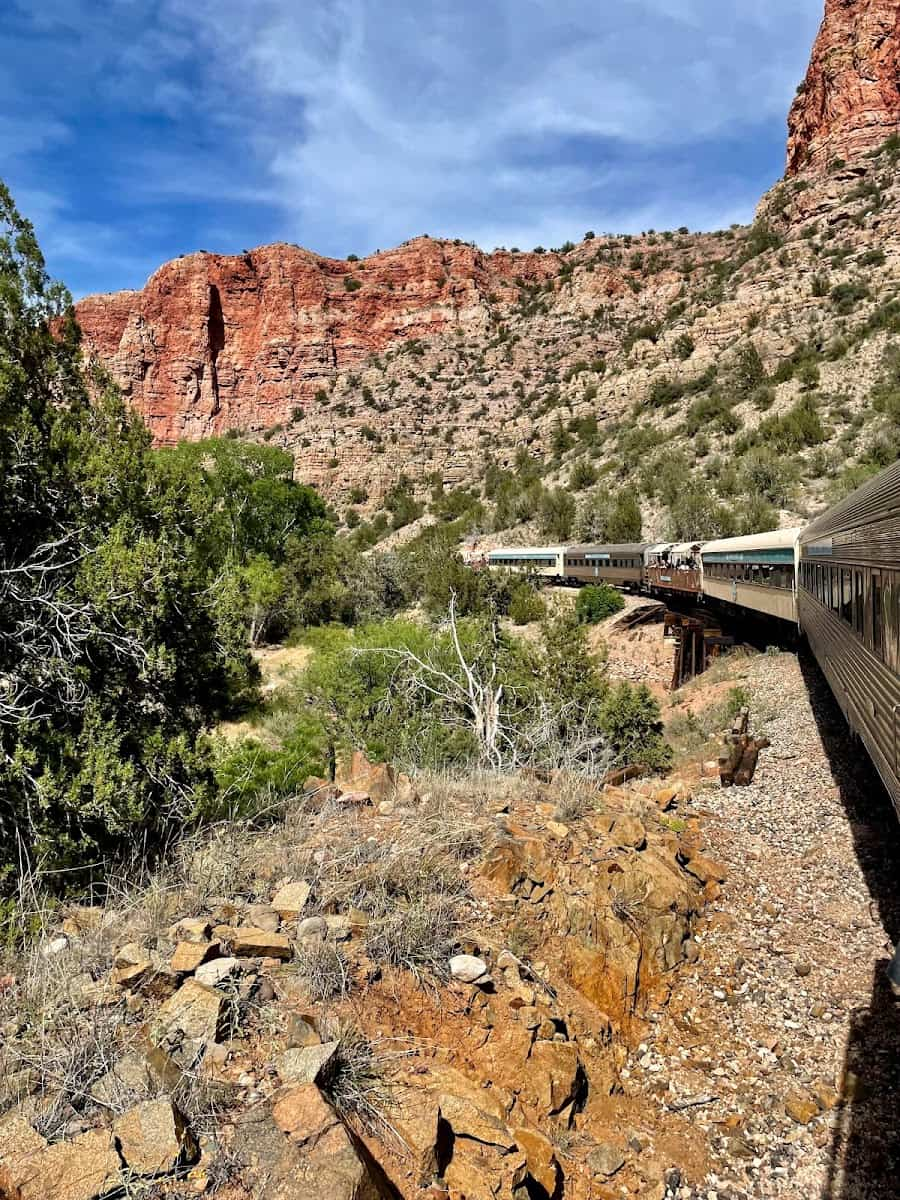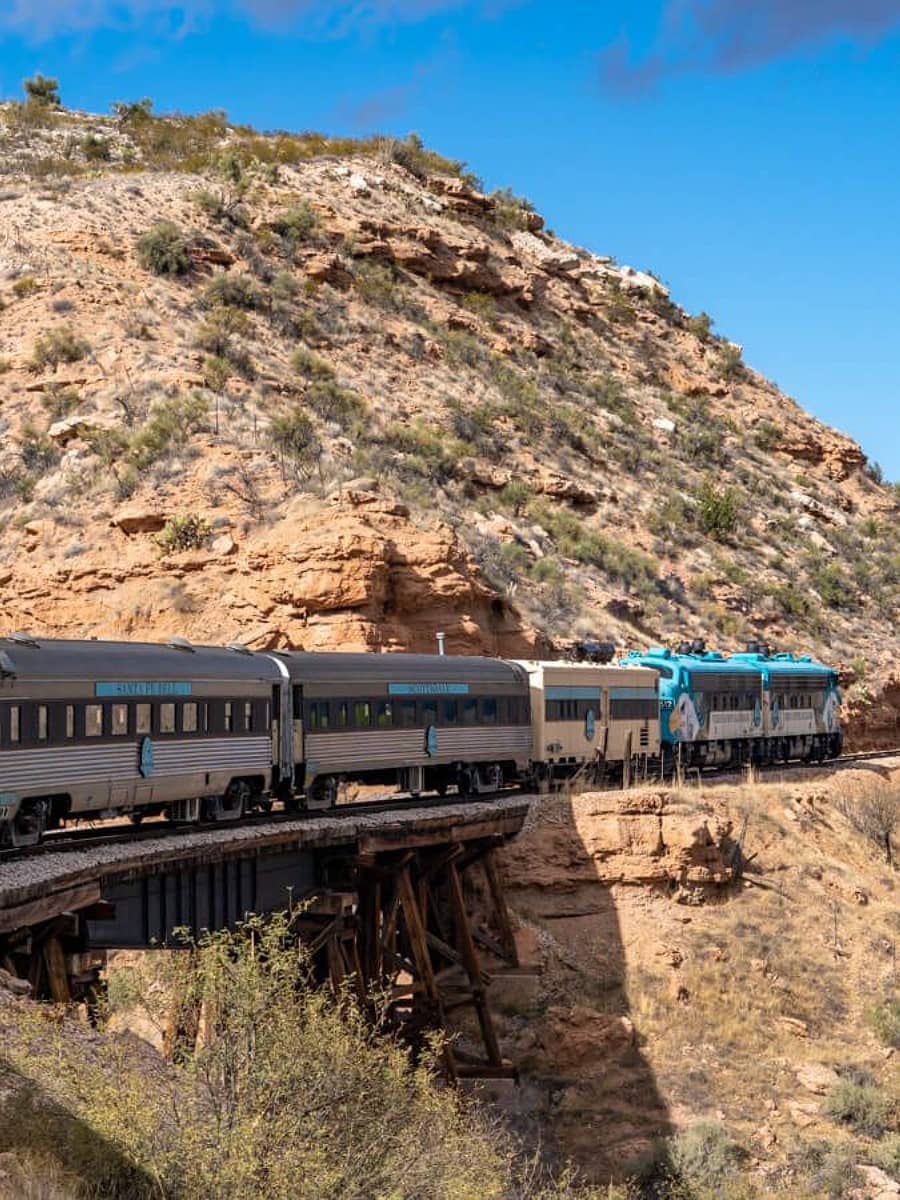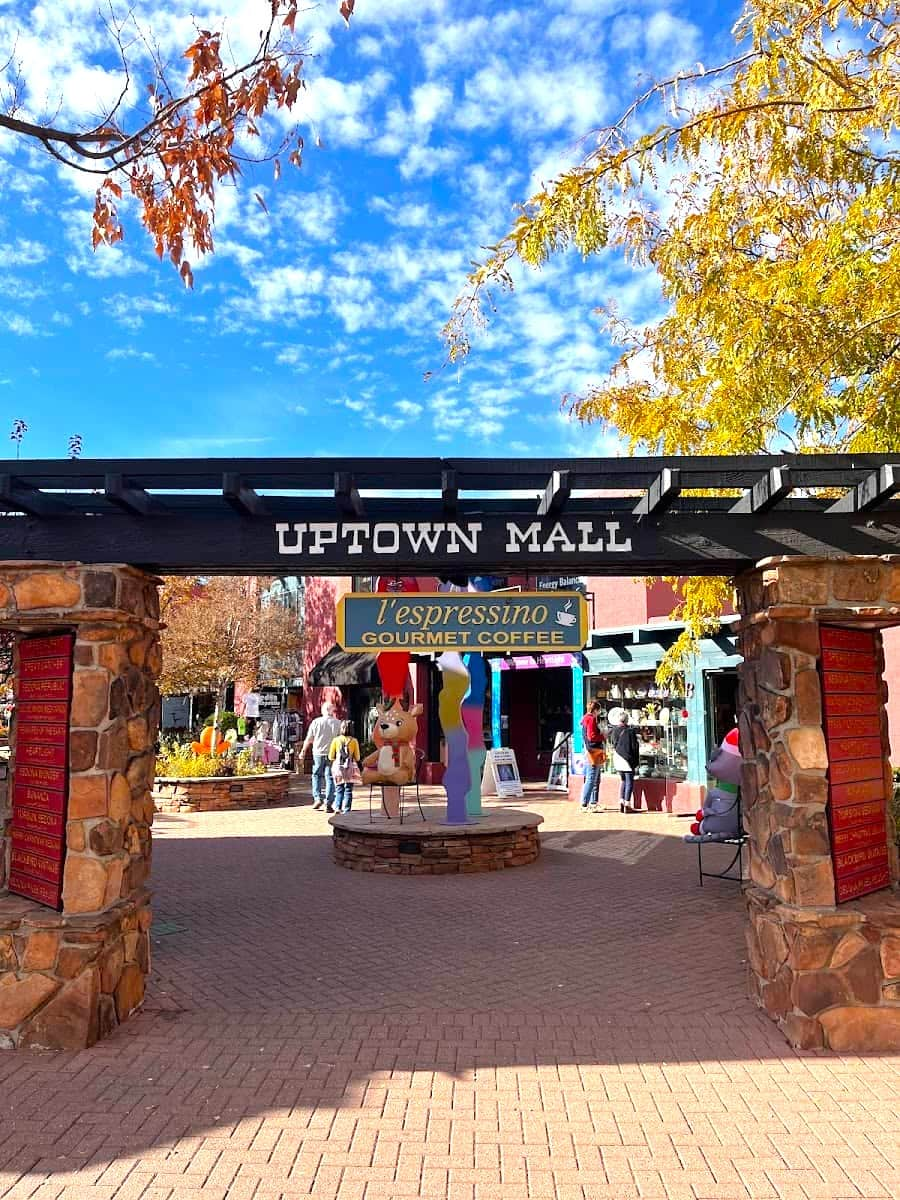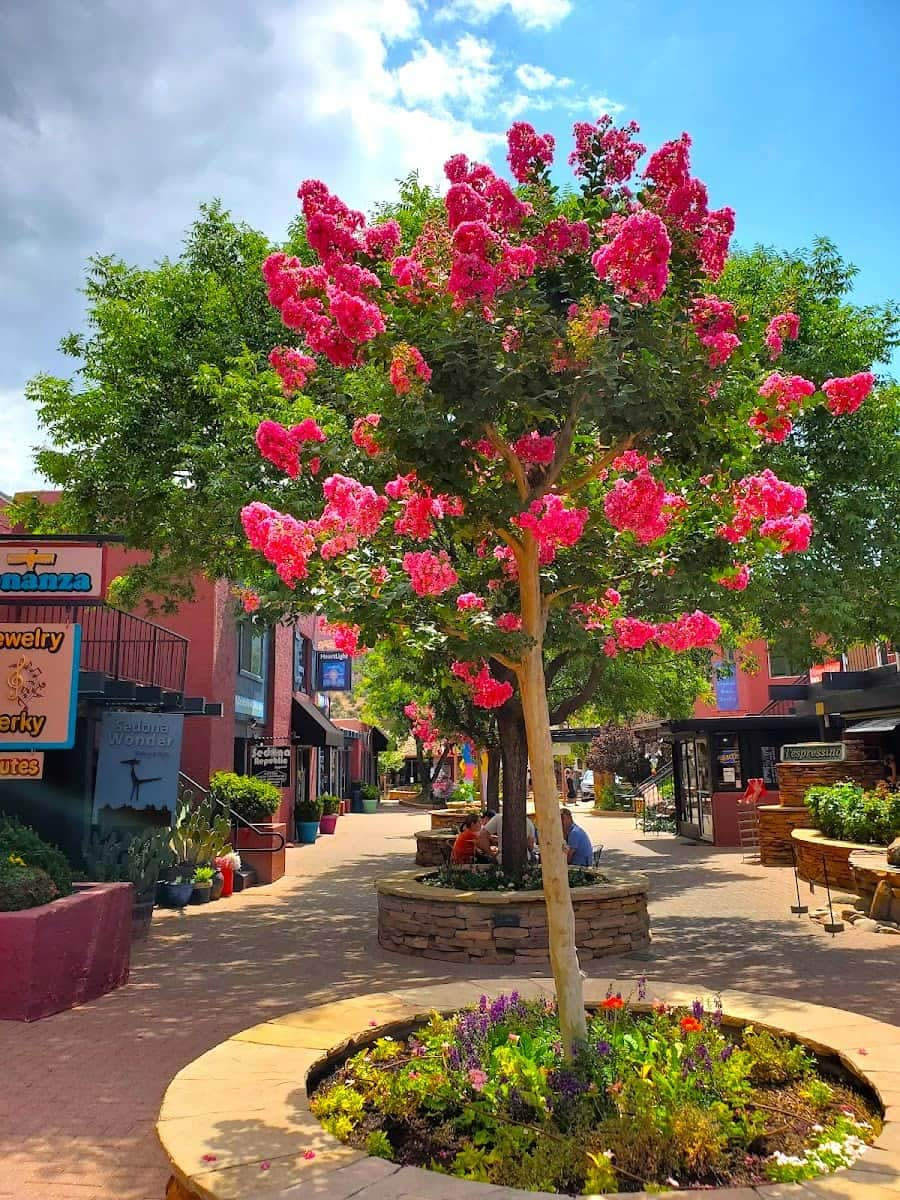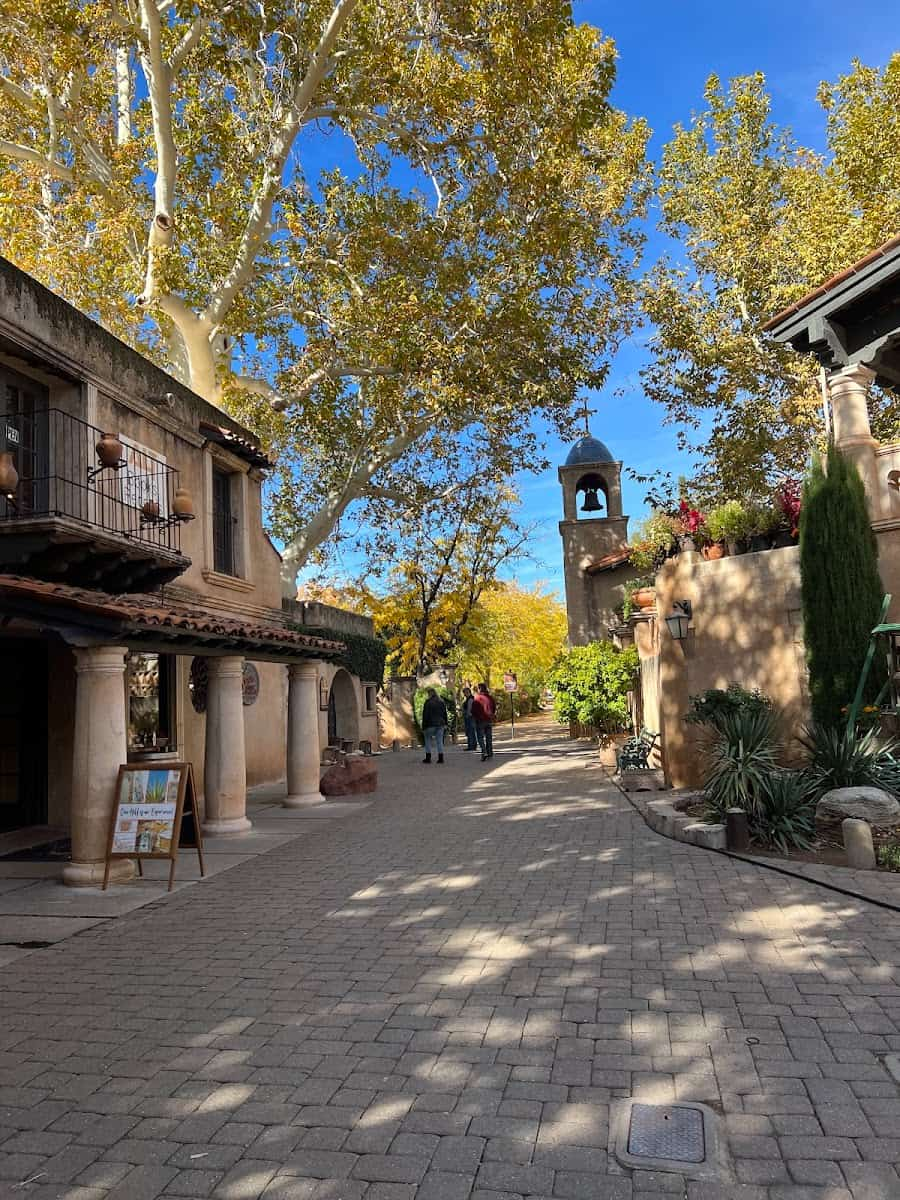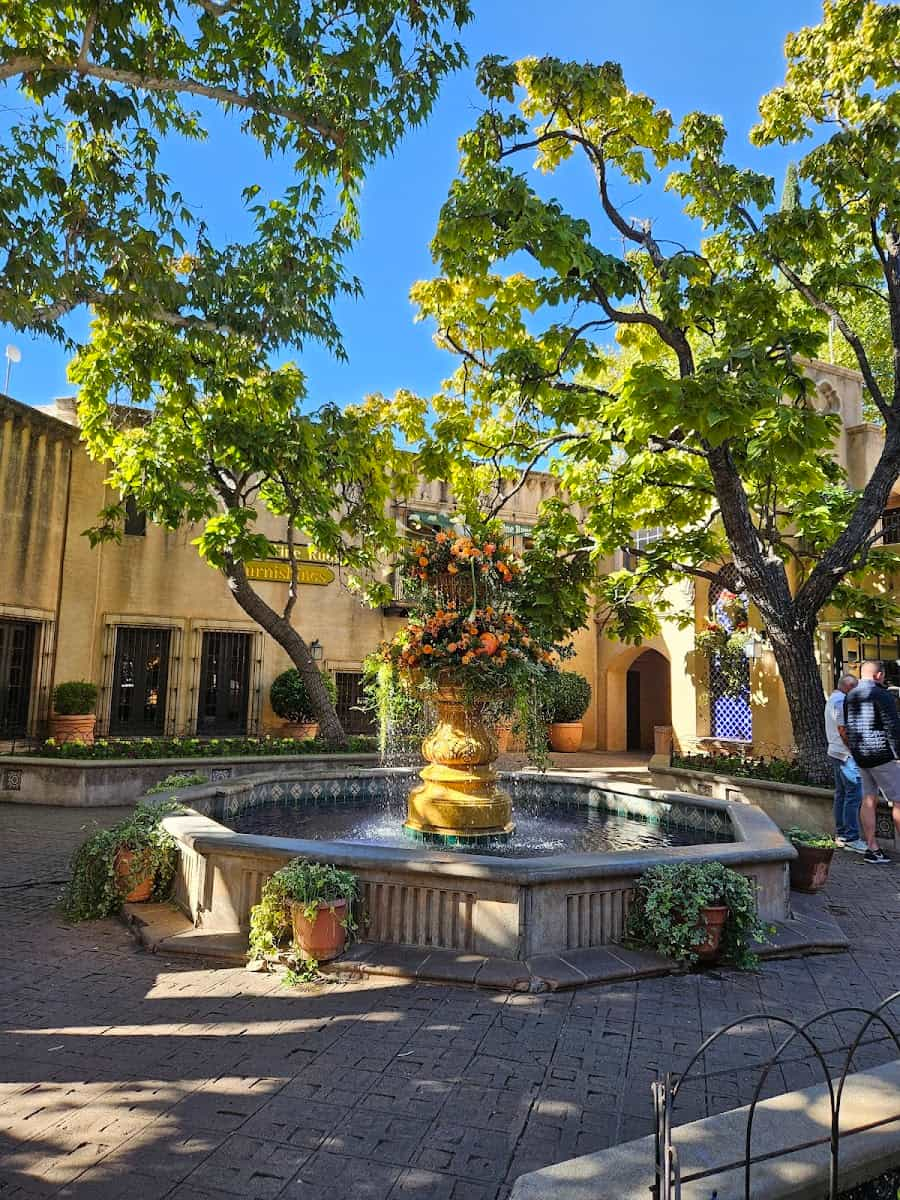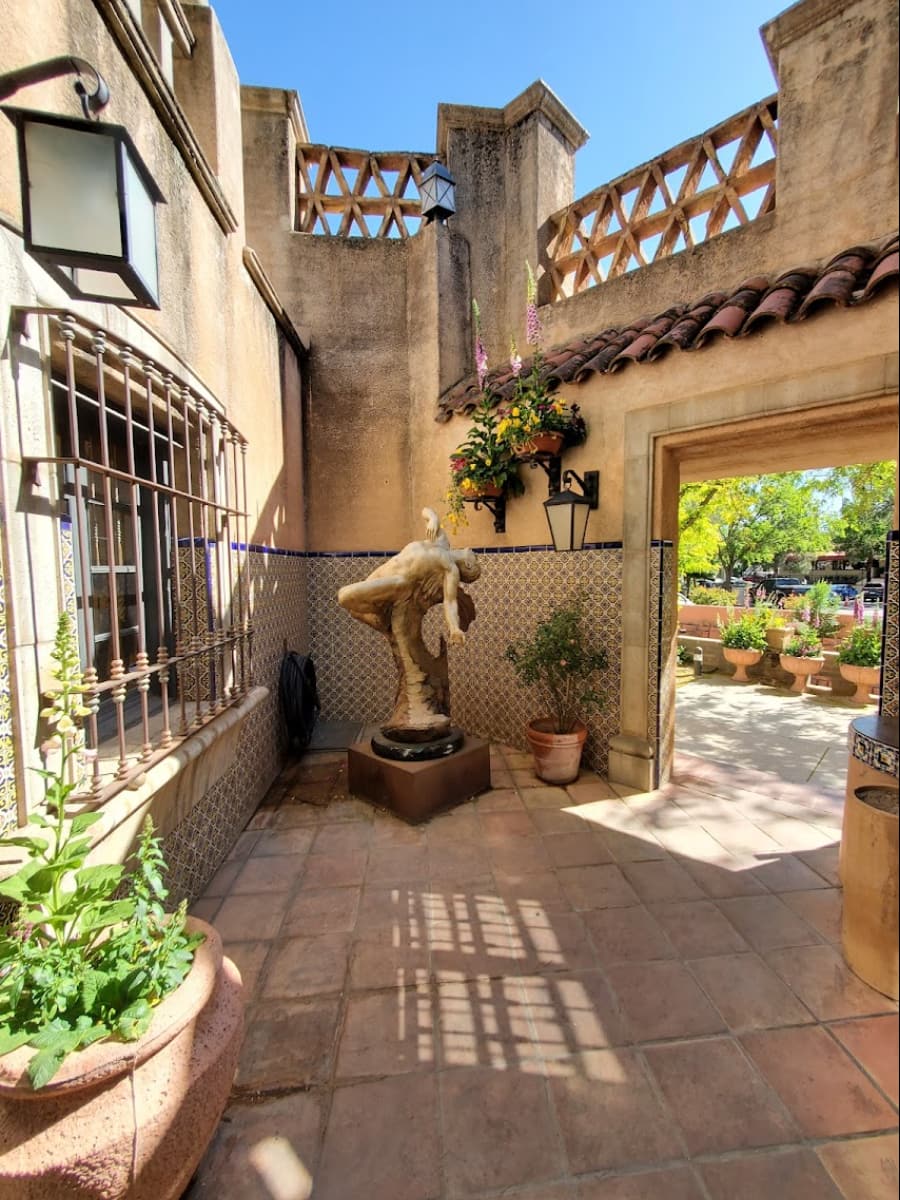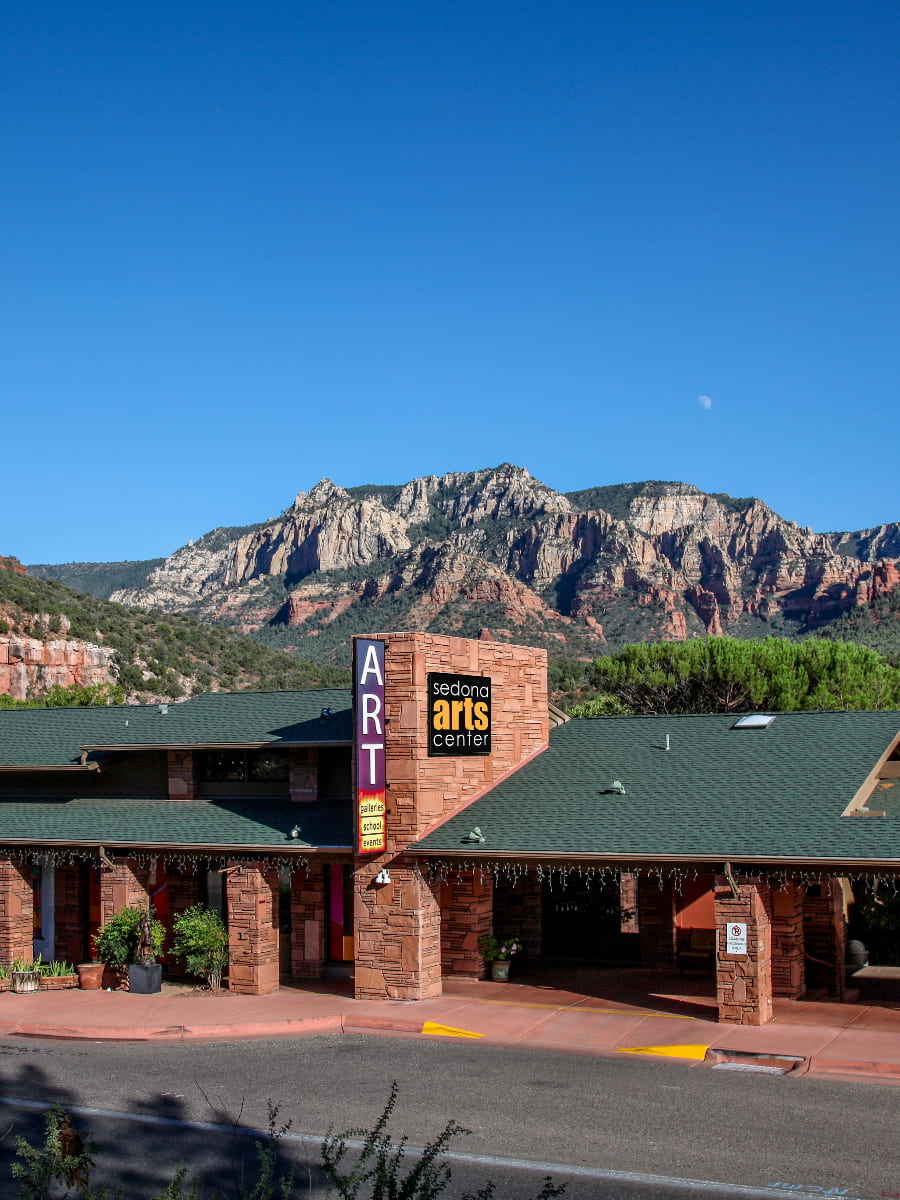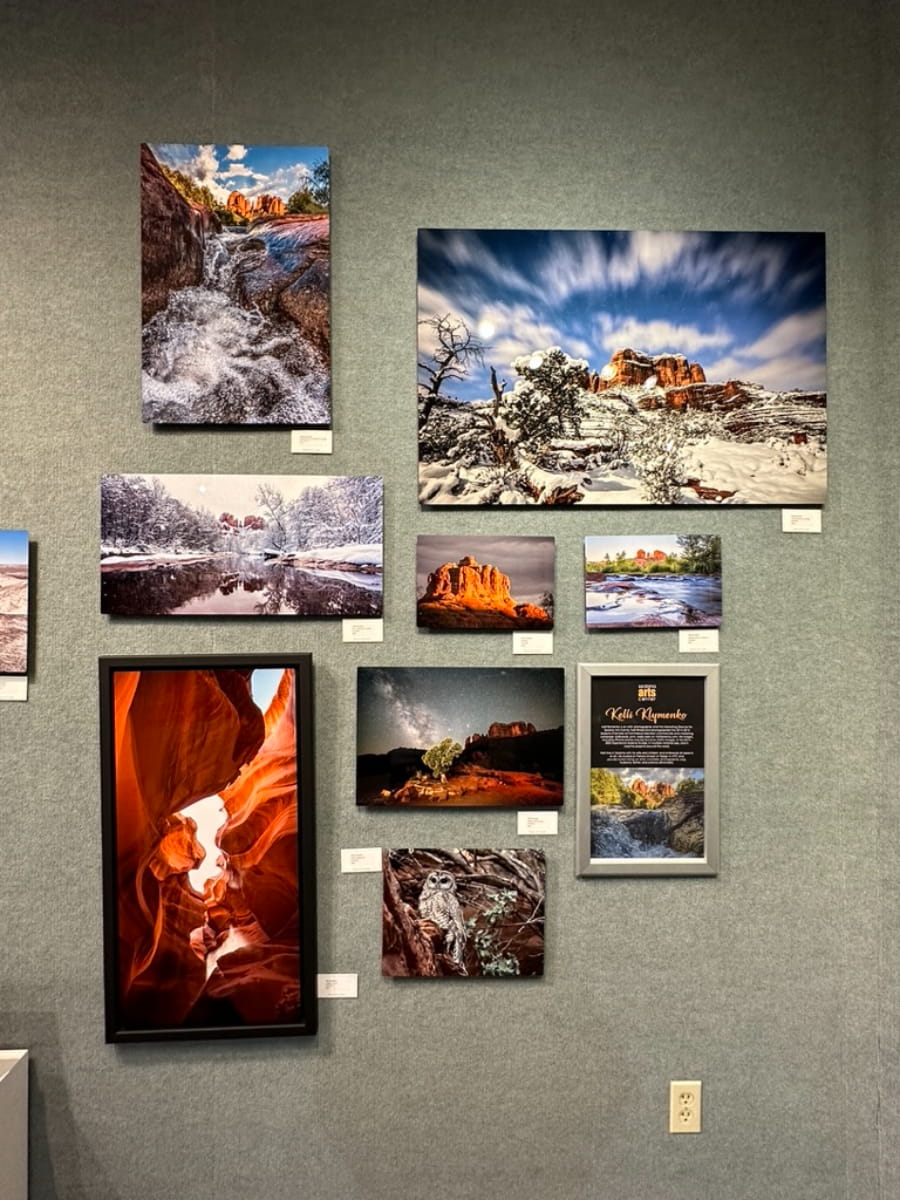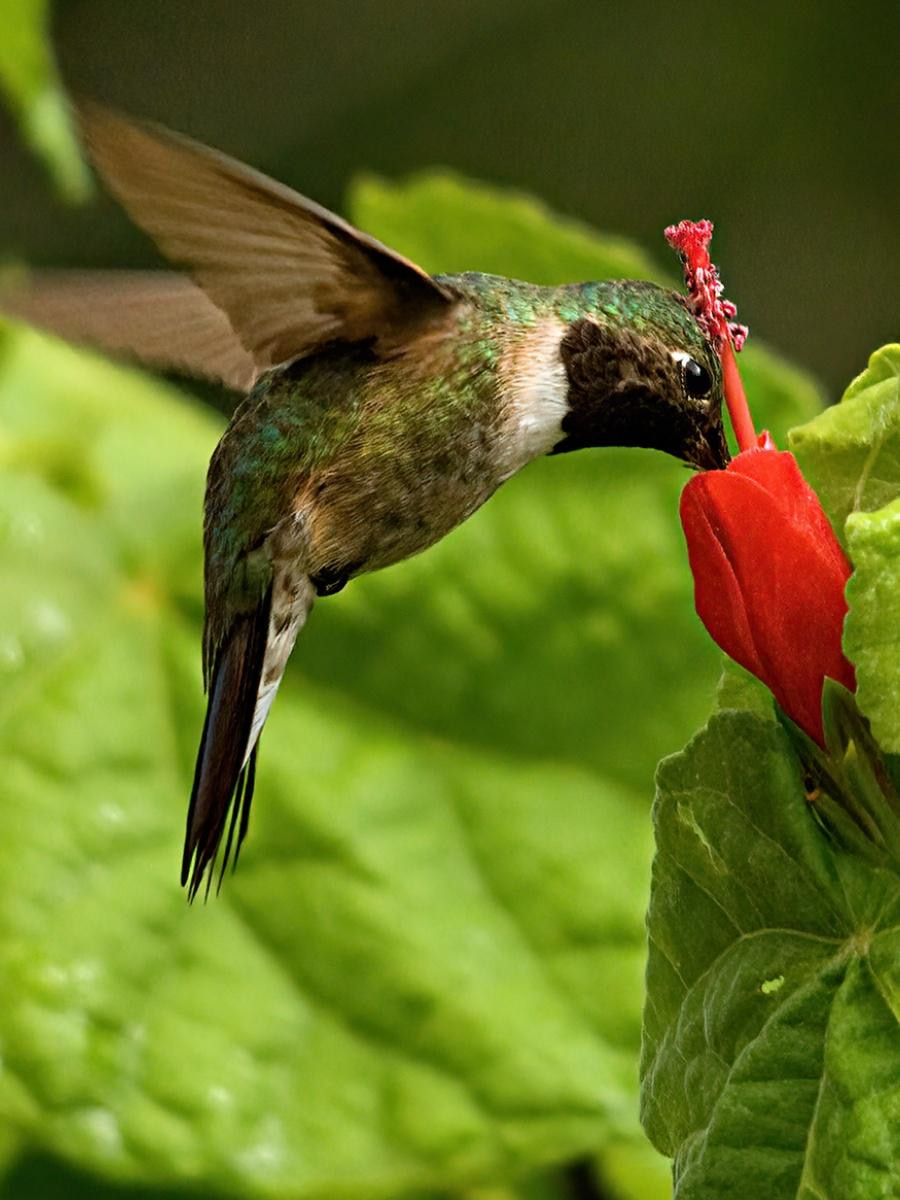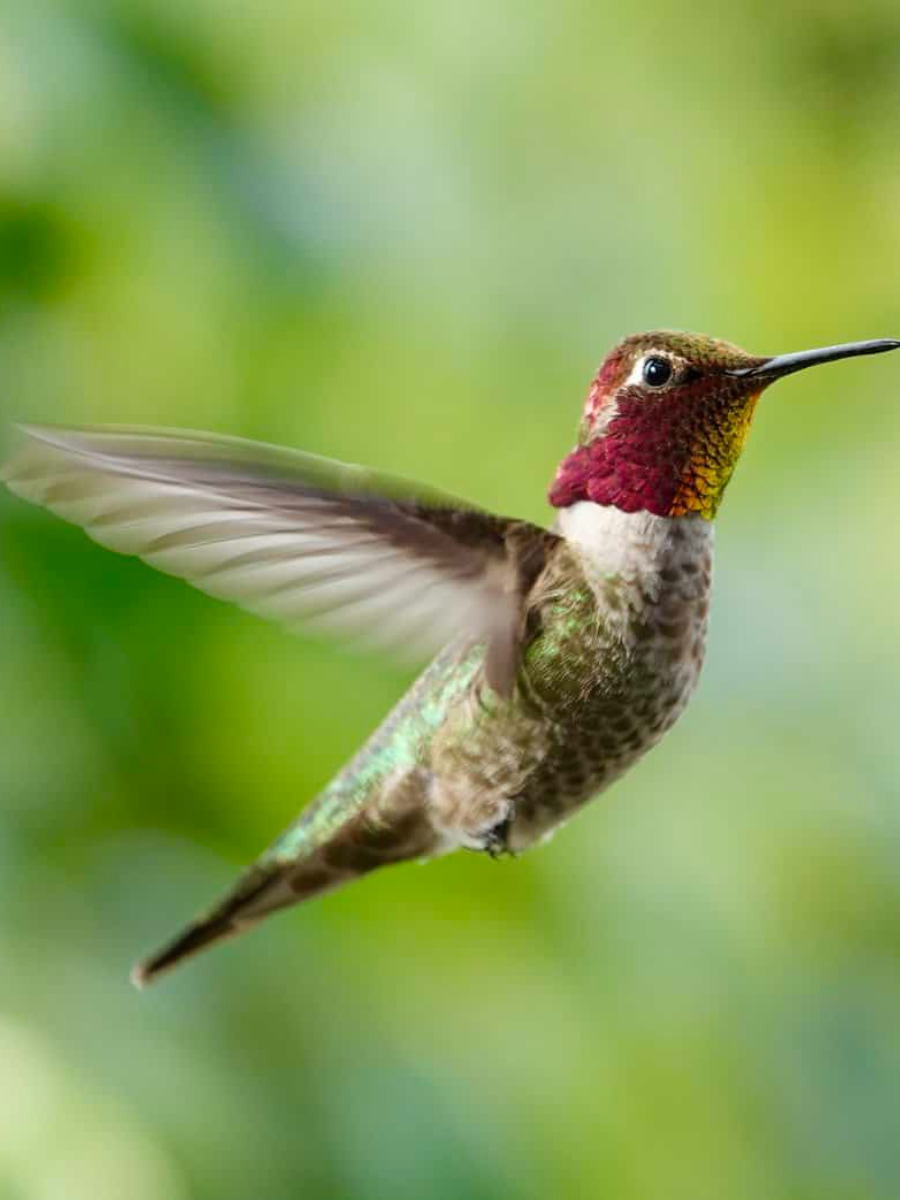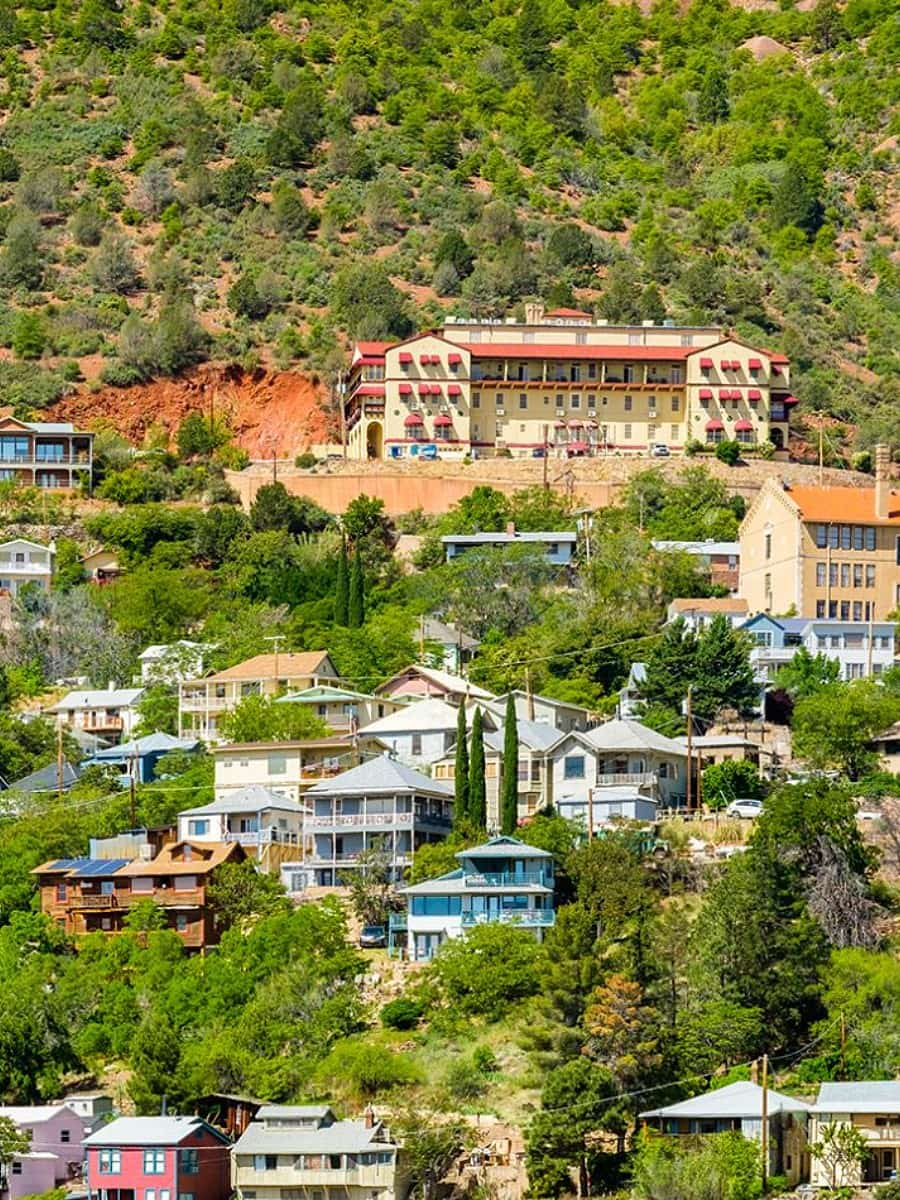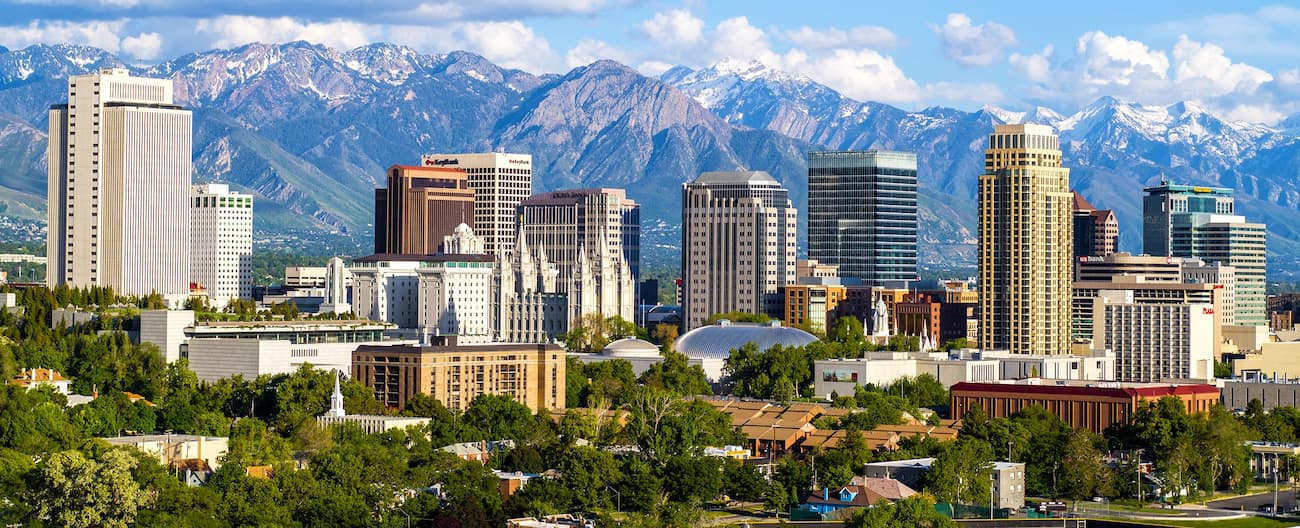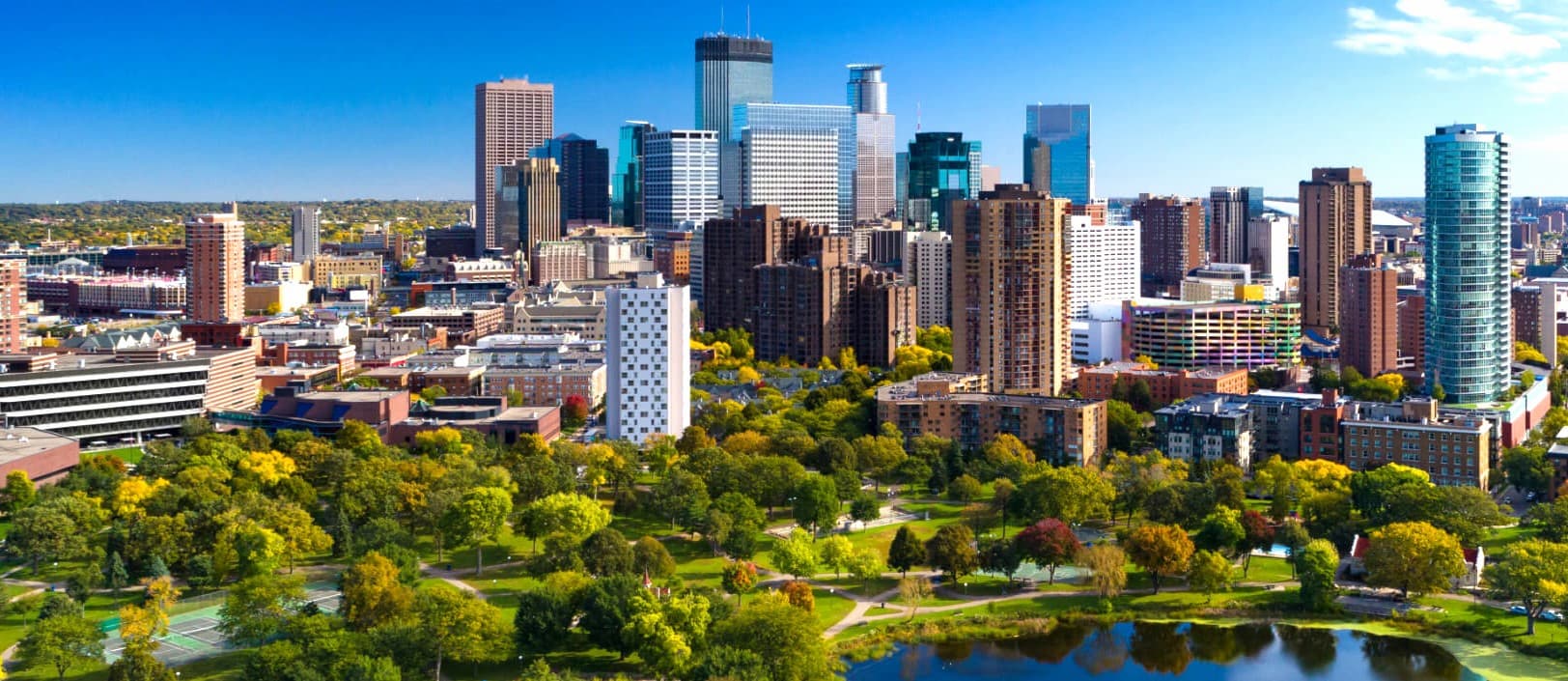Nestled among Arizona’s iconic red rock formations, Sedona is a magical destination that captivates visitors with its natural beauty and spiritual energy. The vibrant landscape offers endless opportunities for adventure, from hiking spectacular trails to exploring ancient Native American sites.
I’ve spent countless hours discovering the best experiences this desert paradise has to offer, and I’m excited to share my favorite spots with you. Whether you’re planning a family vacation, seeking budget-friendly activities, or looking for seasonal events, this guide will help you create unforgettable memories in Sedona.
🏠 Where to Stay in Sedona
- 💎 Luxury Hotel: A Sunset Chateau, Sedona
- ✨ 5-Star: Sedona Pines Resort, Sedona
- 🏨 4-Star: El Portal Sedona Hotel, Sedona
- 🛏️ 3-Star: GreenTree Inn Sedona, Sedona
- 💸 Cheap: Hilton Vacation Club Sedona Summit, Sedona
- 🏢 Apartment: Red Rock Luxury, Sedona
- 👨👩👧👦 For Families: Hyatt Vacation Club at Pinon Pointe, Sedona
- 🏩 For Couples: Cedars Resort, Sedona
💁 Best Guided Tours
- Verde Canyon Railroad Adventure from € 186 (⭐4.6/5)
- Antelope Canyon and Horseshoe Bend Tour from Sedona from € 312 (⭐4.9/5)
- Sedona Small-Group Half-Day Sightseeing Tour from € 126 (⭐4.8/5)
- Sedona Landscapes, Spirituality, and History Private Tour from € 199 (⭐4.9/5)
Best Things To Do in Sedona
1. Cathedral Rock
Hiking adventure. Cathedral Rock is a must-do hike in Sedona, offering a magical 1.2-mile out-and-back trail with breathtaking red rock views. I found the 741-foot elevation gain moderately challenging, with some fun hand-over-hand scrambling sections that made me feel like a real explorer among the iconic sandstone formations.
Trail details. The path starts with an easy stroll before quickly transforming into switchbacks and rocky terrain. I followed the wire mesh rock bins marking the route when the trail crossed bare sandstone sections. The final stretch involves a steep climb up a narrow saddle to reach the summit and the famous Cathedral Rock vortex, where I felt the area’s spiritual energy that Sedona is known for.
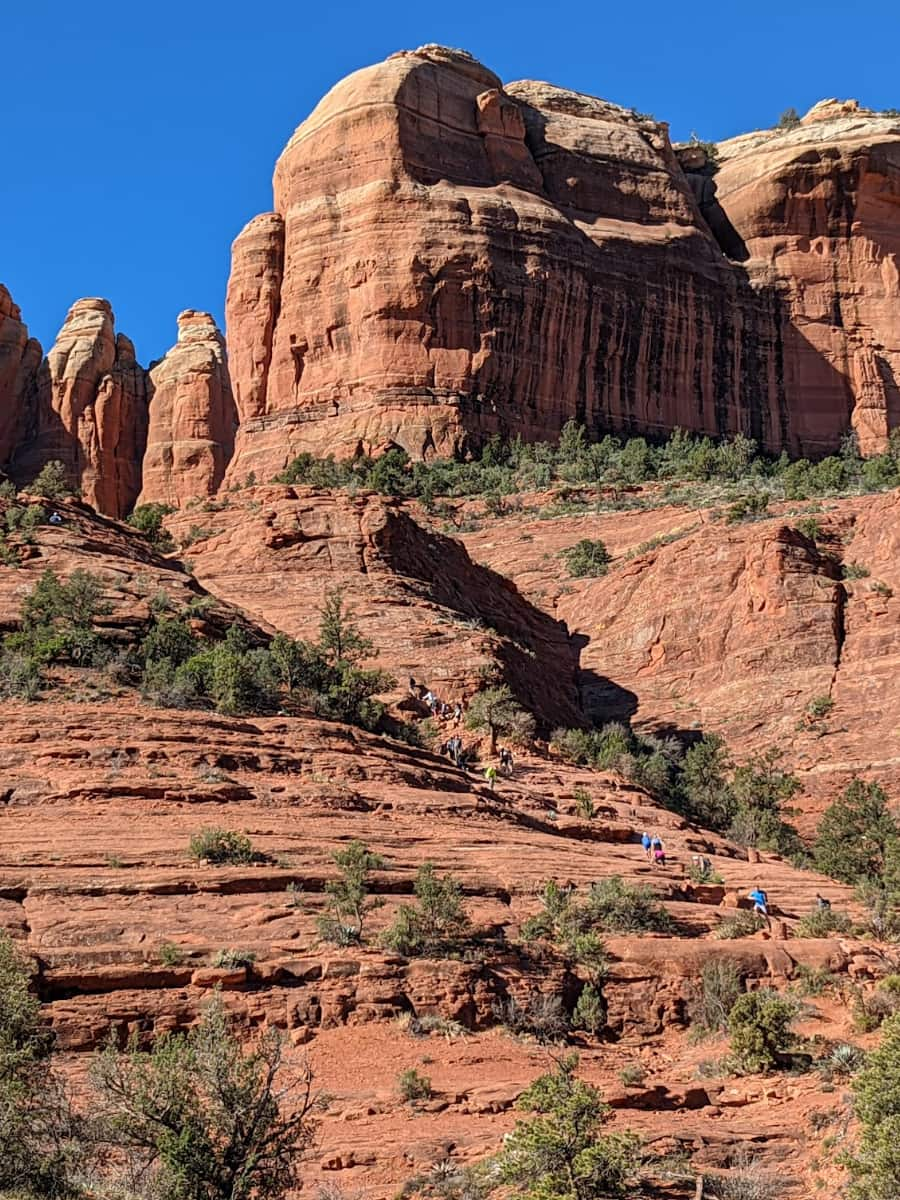
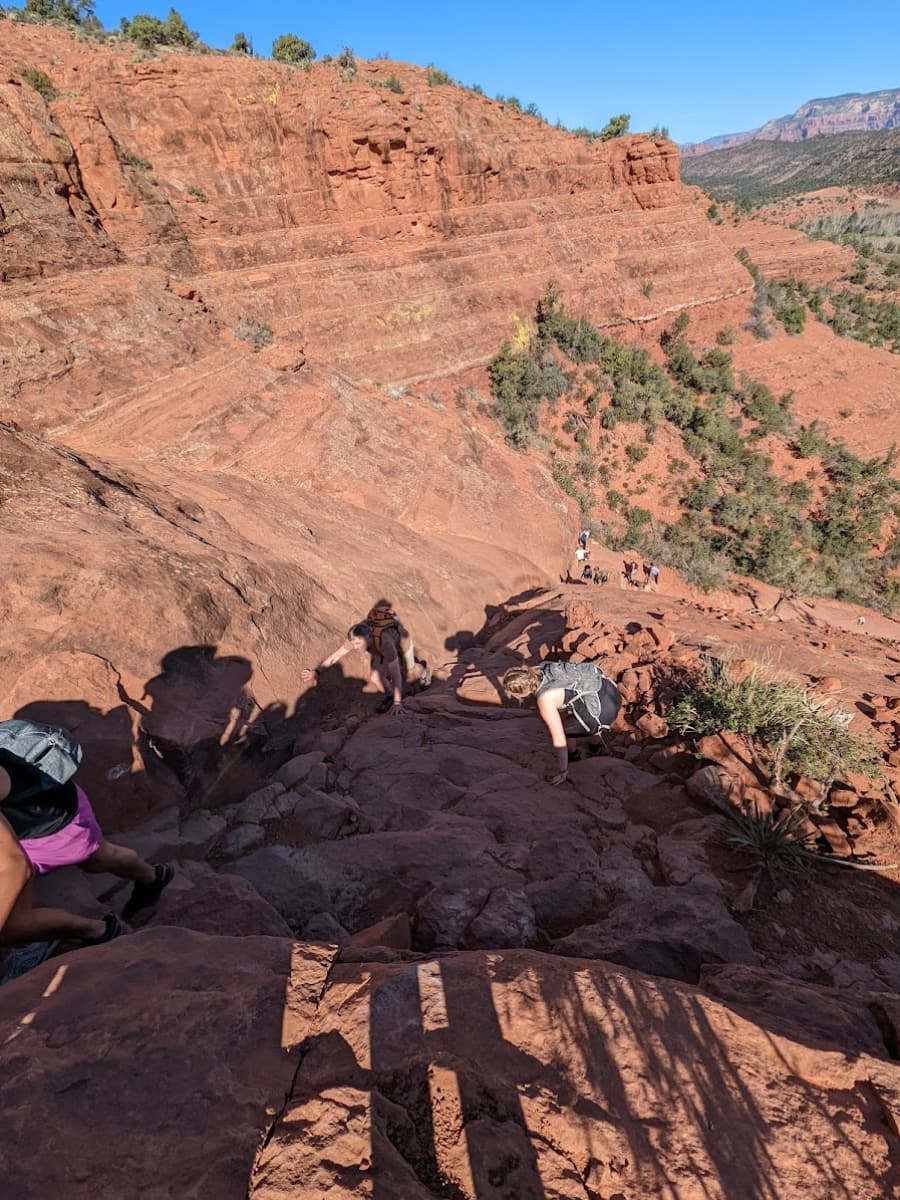

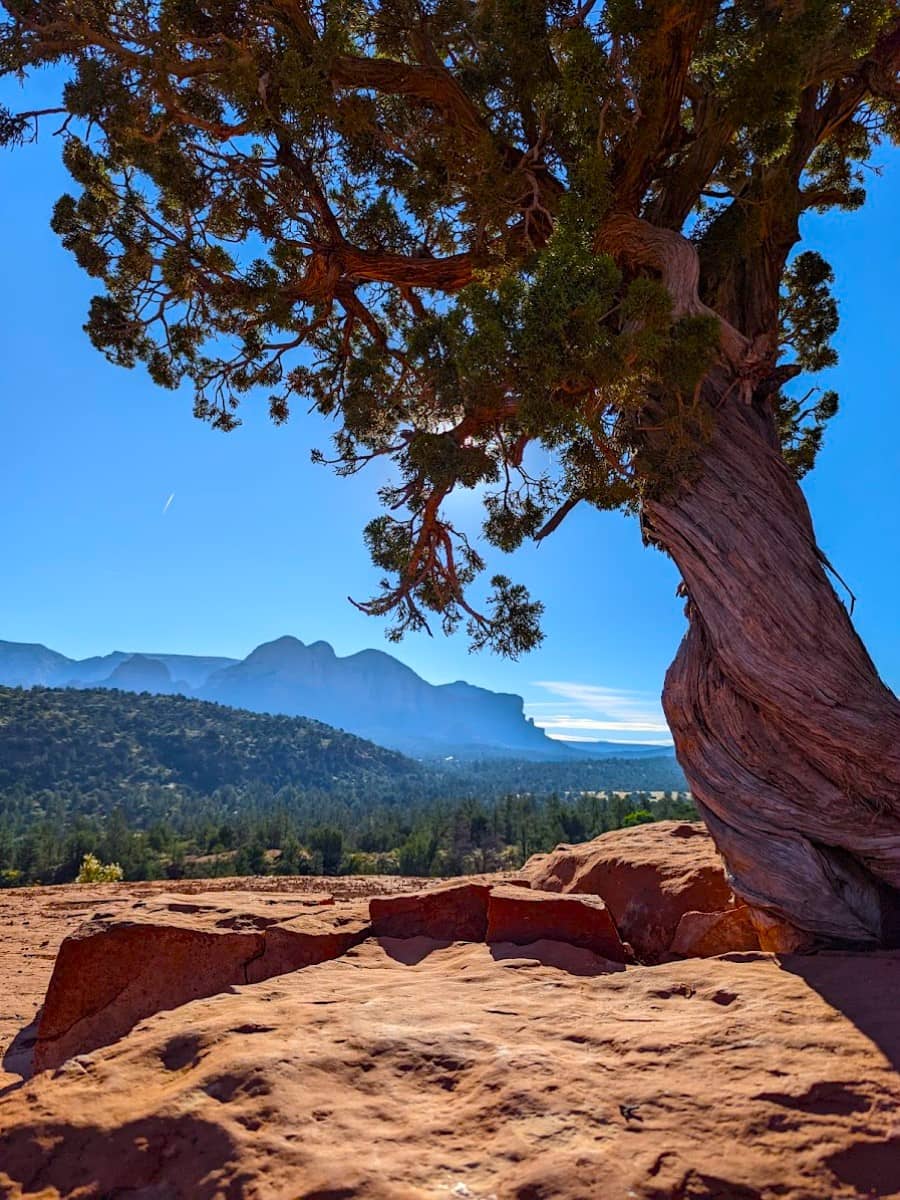
Practical info. Located at 500 Back O Beyond Road, just 4.3 miles from Uptown Sedona, this popular spot requires early arrival. I recommend getting there by 6 AM during peak season to secure parking. You’ll need a Red Rock Pass ($5 daily or $15 weekly) or an America the Beautiful Pass, which can be purchased at the trailhead machine.
Tips from experience. Wear proper hiking shoes with good traction for the slippery slickrock sections. The trail has minimal shade, so I always bring at least one liter of water, sunscreen, and a hat. For amazing photos, walk out along the 5-foot wide saddle between the rock spires – the panoramic views of Red Rock Country are absolutely worth it!
| Item | Cost |
|---|---|
| Red Rock Day Pass | $5 |
| Red Rock Weekly Pass | $15 |
| America the Beautiful Pass | Free entry with pass |
⭐ Best Activities
- Sedona Cathedral Rock E-Bike Adventure – Explore Sedona’s stunning Red Rock Loop Road on this 3-hour guided e-bike tour with a knowledgeable guide who shares insights about local history and wildlife while you enjoy breathtaking views of Cathedral Rock and other iconic formations.
2. Bell Rock
Iconic landmark. Bell Rock is one of Sedona’s most recognizable formations, shaped like a massive bell and visible from miles away. I spent a wonderful morning exploring the 3.6-mile Bell Rock Pathway loop, which offers stunning 360-degree views of the surrounding red rock landscape without requiring technical climbing skills.
The most popular Bell Rock trails include:
- Bell Rock Pathway (easy, 3.6 miles)
- Bell Rock Climb (moderate, 1 mile)
- Courthouse Butte Loop (moderate, 4.2 miles)
- Bell Rock Vista (easy, 0.75 miles)
Energy spot. This location is famous as one of Sedona’s four main vortex sites, where many visitors report feeling increased energy and spiritual awareness. I definitely felt something special while sitting on the northern face-a tingling sensation and unexpected clarity that made me understand why spiritual seekers flock to this natural wonder.
Access information. Located along Highway 179 at milepost 309.8, Bell Rock has two main parking areas: the Bell Rock Vista and the Courthouse Vista lots. A Red Rock Pass is required ($5 daily), and I suggest arriving before 8 AM to secure parking, especially during spring and fall peak seasons.
| Trail Name | Distance | Difficulty | Elevation Gain |
|---|---|---|---|
| Bell Rock Pathway | 3.6 miles | Easy | 400 ft |
| Courthouse Butte Loop | 4.2 miles | Moderate | 500 ft |
| Bell Rock Climb | 1 mile | Moderate | 400 ft |
⭐ Best Activities
- Half-day Sedona Sightseeing Tour – Discover Sedona’s highlights on this comprehensive 5.5-hour tour in an open-air vehicle.
3. Devil’s Bridge
Spectacular arch. Devil’s Bridge is Sedona’s largest natural sandstone arch, standing about 54 feet high and offering one of the most photographed spots in all of Arizona. The main trail is a 4.2-mile round trip from the Dry Creek Road parking area, though you can shorten it to 2 miles if you have a high-clearance 4WD vehicle to reach the closer trailhead.

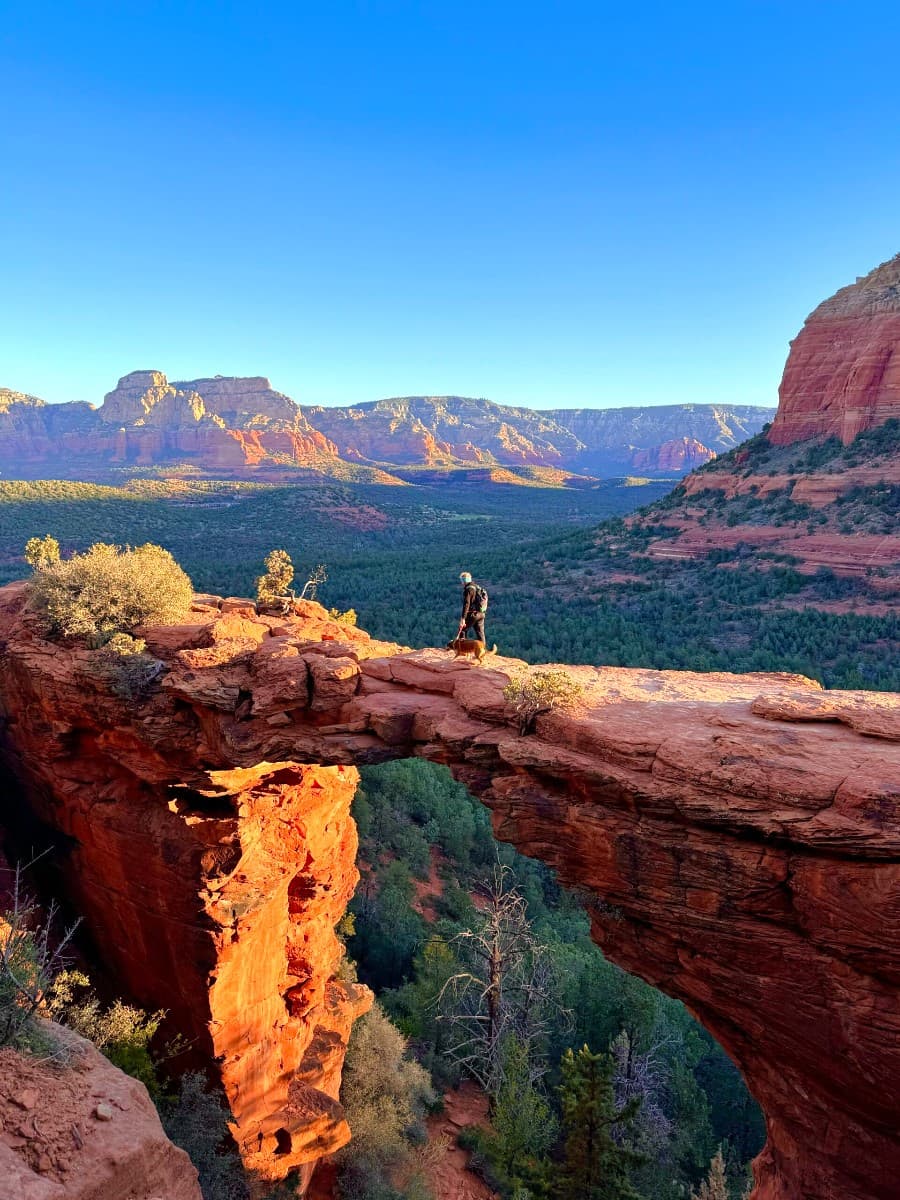
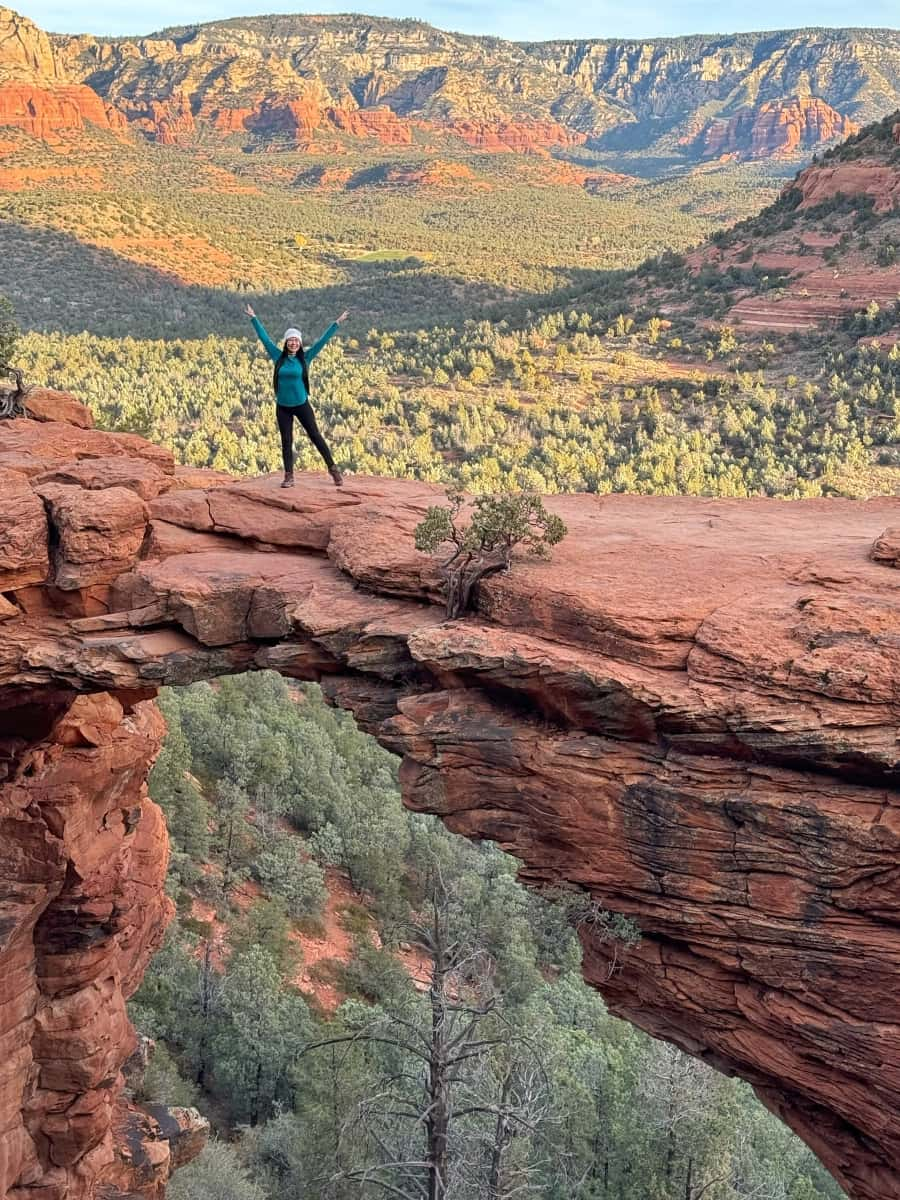
Hiking experience. The first mile follows a wide, dusty jeep road before transitioning to a proper hiking trail. I found the final quarter-mile ascent moderately challenging with some steep sections, but the payoff is absolutely worth it! The natural bridge is much more impressive in person than in photos, with its massive span creating a perfect frame for the red rock wilderness beyond.
What to bring on your Devil’s Bridge hike:
- Water (at least 2 liters per person)
- Sun protection (hat, sunscreen, sunglasses)
- Sturdy hiking shoes with good traction
- Camera for that iconic bridge photo
- Light snacks for energy
Photo opportunities. The classic Devil’s Bridge photo spot often has a line of 15-30 people waiting their turn during peak hours. I went at 7 AM on a Tuesday and only waited about 10 minutes. The morning light casts a beautiful glow on the red rocks, making it ideal for photography despite what the crowds might suggest.
Visitor tips. The parking lot at Dry Creek Road fills up quickly by 8 AM. If it’s full, you’ll need to park at the Mescal Trailhead and add an extra mile each way. The trail has virtually no shade, so I recommend hiking early morning or late afternoon, especially during summer when temperatures can exceed 100°F.
⭐ Best Activities
- Mogollon Rim Supreme Jeep Tour – Experience the thrill of a 2.5-hour guided jeep tour to the spectacular Mogollon Rim, a 200-mile geological feature that extends across Arizona, offering breathtaking panoramic views from 2,000 feet above the valley floor.
4. Chapel of the Holy Cross
Architectural marvel. Built directly into the red rocks in 1956, the Chapel of the Holy Cross is a stunning example of modern religious architecture. I was immediately struck by how the 90-foot cross seems to grow organically from the sandstone buttes, creating a harmonious blend of human design and natural beauty that attracts visitors of all faiths.
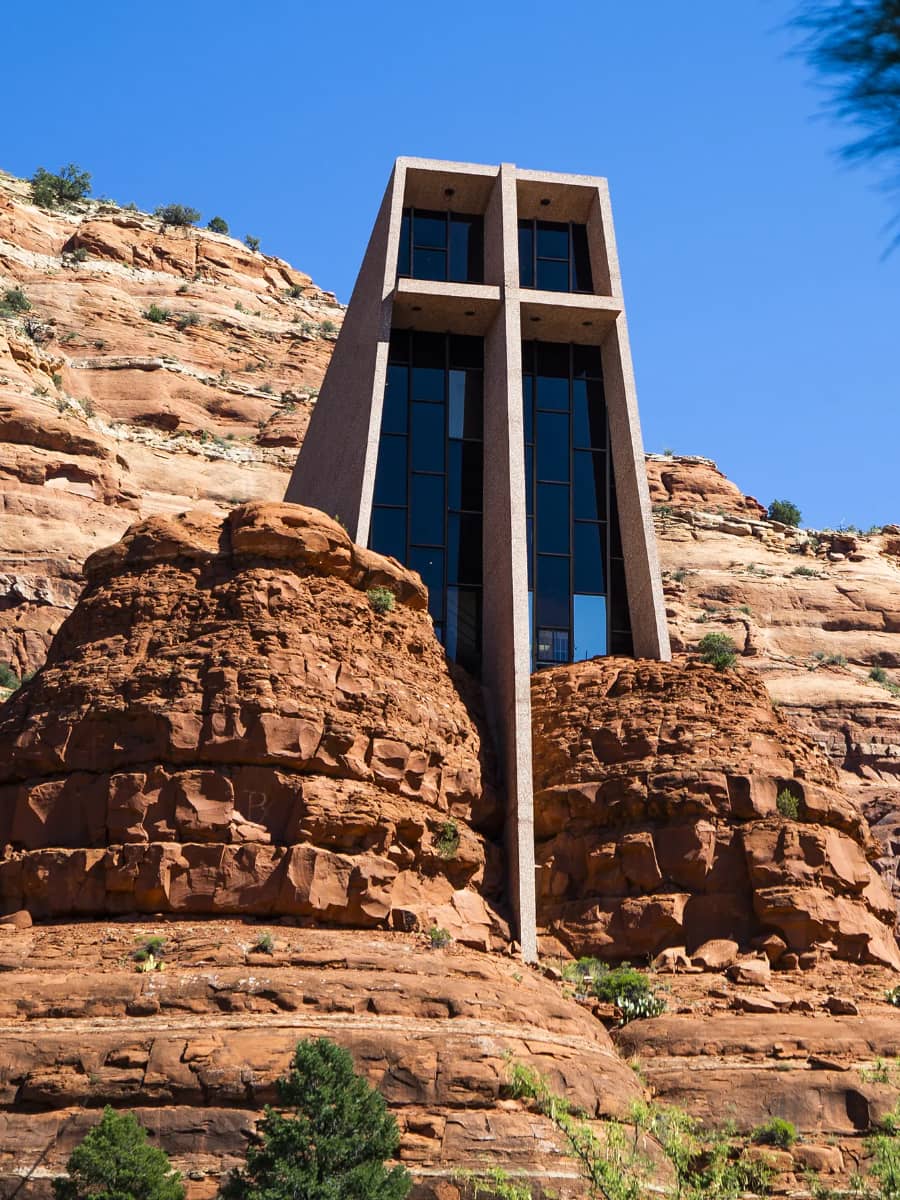


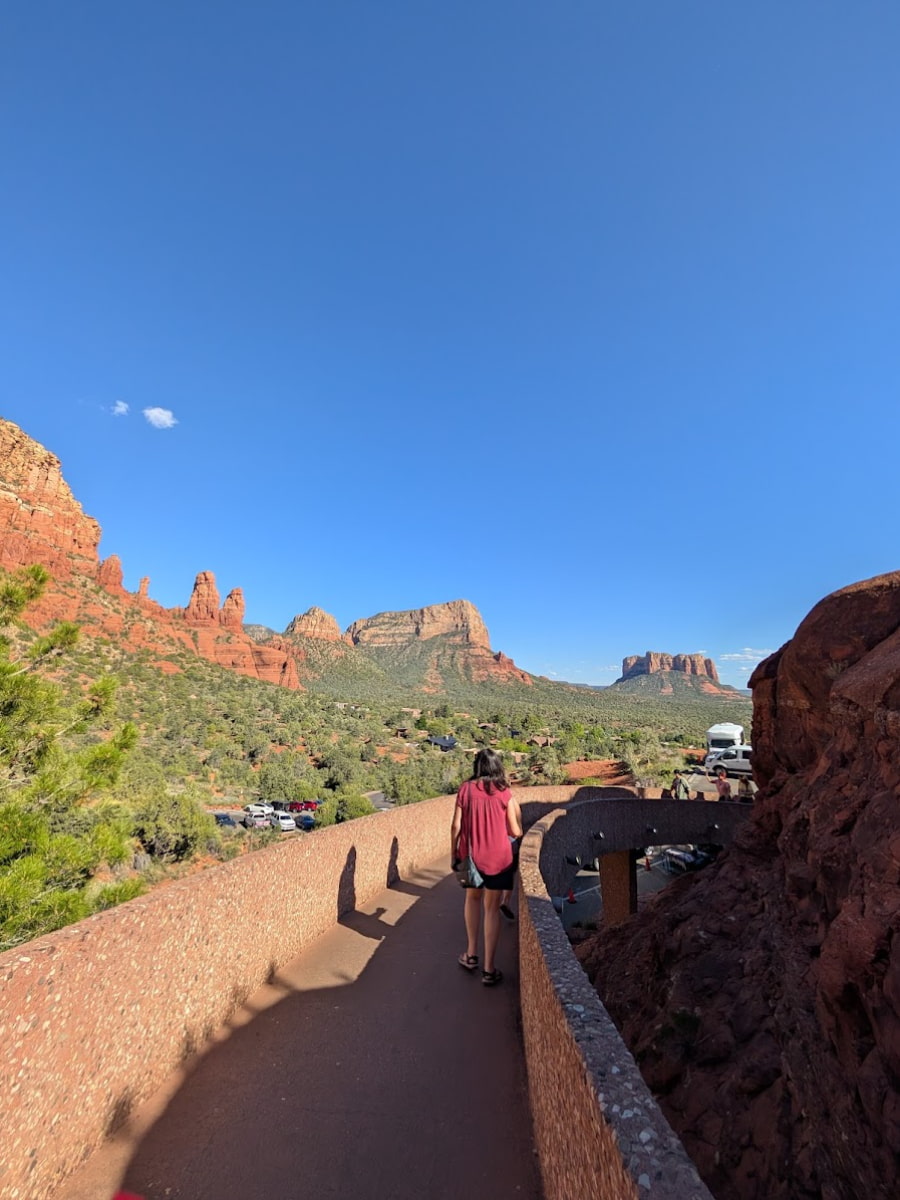
Spiritual experience. Inside, the chapel is surprisingly intimate with just a few rows of pews facing a simple altar and a floor-to-ceiling window framing spectacular views of the valley. Despite the steady stream of visitors, I found a peaceful moment to sit in quiet contemplation, watching the changing light play across the red rock landscape below.
Chapel visiting hours and information:
- Open daily: 9 AM – 5 PM
- Sunday Mass: Not regularly held here
- Address: 780 Chapel Road, Sedona
- Admission: Free (donations appreciated)
Practical details. The chapel has limited parking (about 30 spaces) that fills quickly. I recommend visiting before 10 AM or after 3 PM to avoid the crowds. A free shuttle runs from the main parking area at the bottom of the hill for those who can’t make the short but steep walk up.
Photography tips. The chapel is stunning from both inside and out, but my favorite shots came from the viewing platform below the parking area, where you can capture the entire structure against the backdrop of Courthouse Butte. The late afternoon light bathes the chapel in a warm glow that perfectly complements the red rocks.
⭐ Best Activities
- The Ultimate Sedona Experience – Enjoy a comprehensive 5.5-hour tour of Sedona’s most spectacular sites with knowledgeable guides who share fascinating insights about the area’s geology, history, and culture while visiting multiple scenic viewpoints and landmarks.
5. Tlaquepaque Arts & Crafts Village
Shopping paradise. Tlaquepaque (pronounced Tla-keh-pah-keh) is a charming arts and crafts village designed to resemble a traditional Mexican town. I spent hours wandering through its cobblestone walkways, admiring the Spanish-colonial architecture with ivy-covered walls, bubbling fountains, and hidden courtyards that house over 50 specialty shops and galleries.
Top shops at Tlaquepaque include:
- Esteban’s – Handcrafted southwestern pottery
- Renee Taylor Gallery – Fine art and sculptures
- Kuivato Glass Gallery – Stunning blown glass pieces
- Ninibah Jewelry – Native American silver and turquoise
- Cocopah – Unique home decor and gifts
Artistic atmosphere. What makes Tlaquepaque special isn’t just the shopping-it’s the immersive artistic experience. I watched glassblowers creating delicate ornaments, jewelers setting turquoise stones, and painters capturing Sedona’s famous red rocks on canvas. The village regularly hosts art shows, live music performances, and cultural events that showcase local talent.
Dining options. After shopping, I enjoyed a delicious lunch at Oak Creek Brewery & Grill, where the patio seating offers views of the surrounding red rocks. Other excellent options include El Rincon for authentic Mexican cuisine and René at Tlaquepaque for upscale dining. Most restaurants range from $15-30 per entrée.
| Restaurant | Cuisine | Price Range | Notable Dish |
|---|---|---|---|
| Oak Creek Brewery | American/Pub | $15-25 | Craft beer flight & burgers |
| El Rincon | Mexican | $12-24 | Tableside guacamole |
| René | Fine Dining | $28-45 | Rack of lamb |
| Secret Garden Café | Breakfast/Lunch | $10-18 | Quiche & pastries |
6. Sedona Jeep Tours
Off-road adventure. Taking a Pink Jeep Tour was one of my most thrilling Sedona experiences. These iconic bright pink vehicles tackle rugged terrain that regular cars simply can’t access. I chose the Broken Arrow tour, which features heart-pounding descents down the “Road of No Return” and incredible panoramic views from Chicken Point lookout.
Tour options. Most tours last 2-3 hours and are led by knowledgeable local guides who share fascinating information about Sedona’s geology, wildlife, and Native American history. I learned that the red color comes from iron oxide in the sandstone, and that many Hollywood westerns were filmed among these dramatic formations.

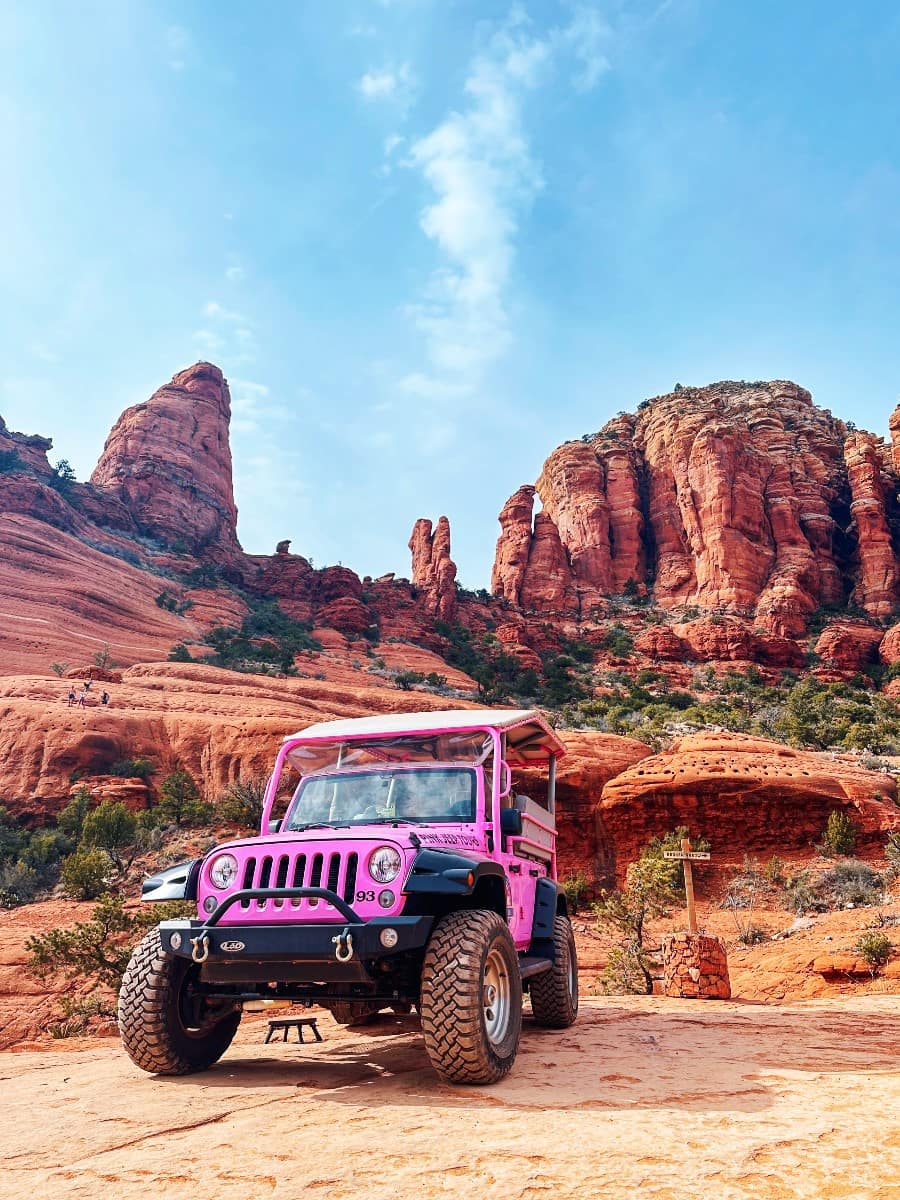

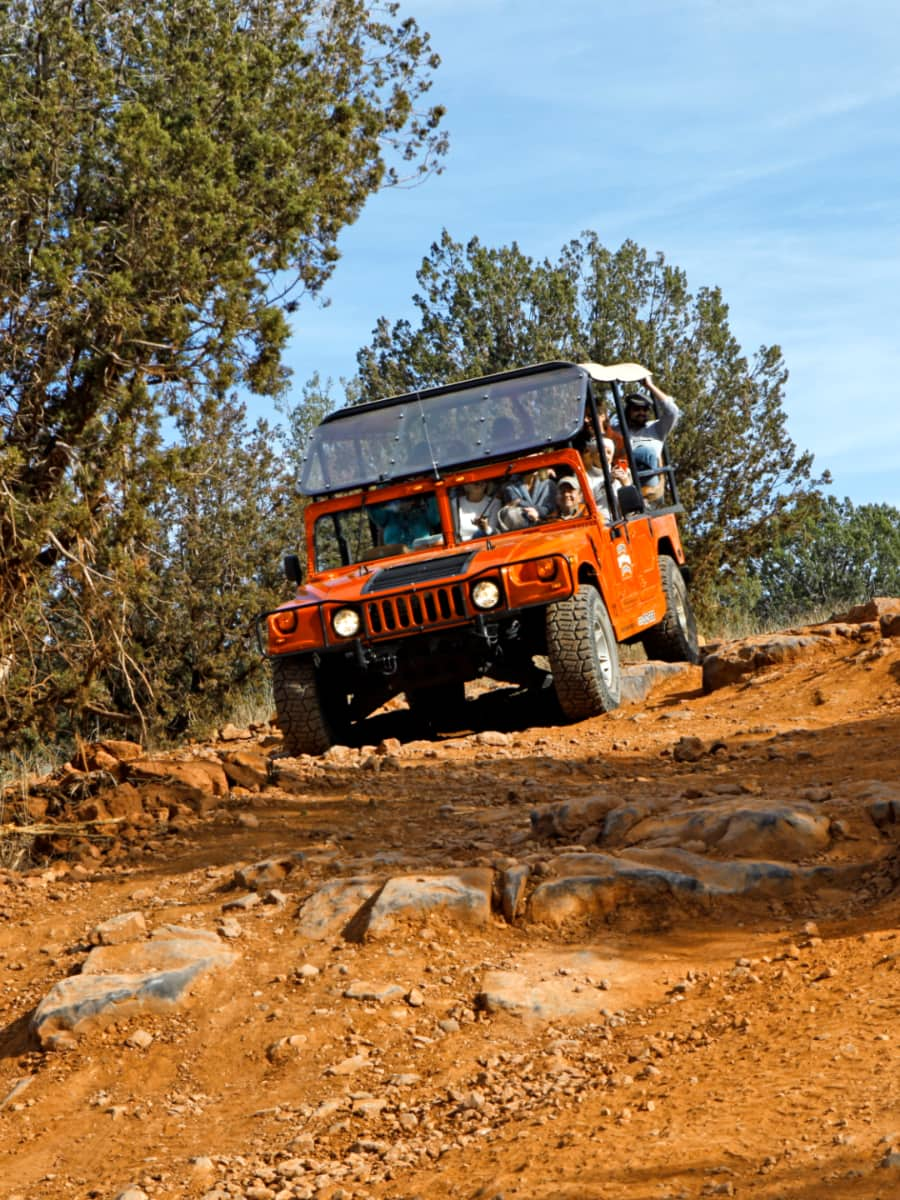
Popular Sedona tours and their features:
- Broken Arrow – Most thrilling off-road experience
- Ancient Ruins – Archaeological sites and history
- Diamondback Gulch – Rugged backcountry adventure
- Scenic Rim – Panoramic views with less extreme terrain
- Vortex Tour – Focuses on Sedona’s spiritual energy sites
What to expect. Wear comfortable clothes and bring sunscreen, water, and a camera. The cars are open-air but have canopies for shade. While the rides can be bumpy and dusty, the drivers are skilled at making you feel safe while still delivering excitement. Even my mom, who’s usually terrified of heights, ended up loving the experience!
⭐ Best Activities
- Private Red Rock Panoramic Jeep Tour – Embark on a private 2-hour jeep adventure through Sedona’s magnificent red rock landscape with exclusive access to scenic viewpoints and personalized commentary from your knowledgeable guide about the area’s unique geology and history.
7. Hot Air Balloon Ride
Sunrise magic. Floating silently above Sedona’s red rock landscape in a hot air balloon is an experience I’ll never forget. We took off just before sunrise, when the air is calmest, and watched the first golden rays illuminate the sandstone formations. The changing colors-from deep purple to fiery orange-created a natural light show that no photograph can truly capture.
Flight experience. Our pilot expertly navigated the balloon to different altitudes, sometimes flying high enough to see the entire valley and as far as the San Francisco Peaks near Flagstaff, then dropping down to almost touch the treetops. The silence was broken only by the occasional blast of the burner and our own gasps of amazement at the views below.
What to know before booking a hot air balloon ride:
- Flights typically last 60-90 minutes
- Early morning departure (usually 5-6 AM)
- Includes post-flight champagne toast
- Not recommended for pregnant women or those with mobility issues
- Weather-dependent (winds must be under 8 mph)
Details. Balloon rides cost between $225-295 per person, depending on the season and company. I flew with Red Rock Balloon Adventures, but Northern Light Balloon Expeditions and Sedona Air Tours also have excellent reputations. Most companies include hotel pickup, a light breakfast, and a champagne toast after landing.
Preparation tips. Dress in layers as mornings can be chilly but the burner gives off heat. Wear flat, closed-toe shoes for the landing. Bring your camera but consider using a wrist strap-you’ll want both hands free during takeoff and landing. The experience is surprisingly gentle, with minimal sensation of movement or height, making it accessible even for those with mild fear of heights.
8. Sedona Vortex Sites
Energy centers. Sedona’s vortexes are specific locations where the earth’s energy is said to be especially concentrated and swirling. I was skeptical at first, but after visiting the Airport Mesa vortex, I experienced an unexpected tingling in my hands and a sense of mental clarity that made me a believer. These special sites attract spiritual seekers, meditation enthusiasts, and curious travelers alike.
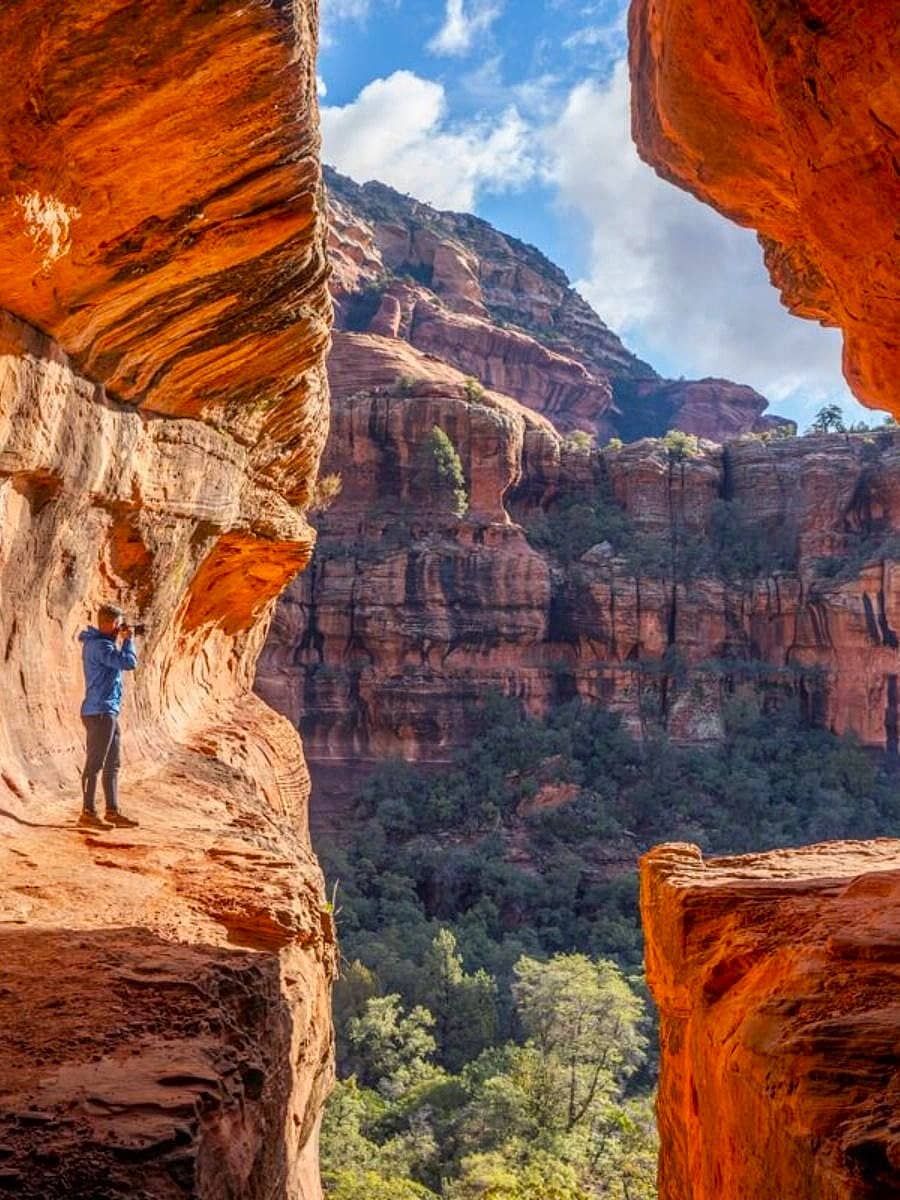

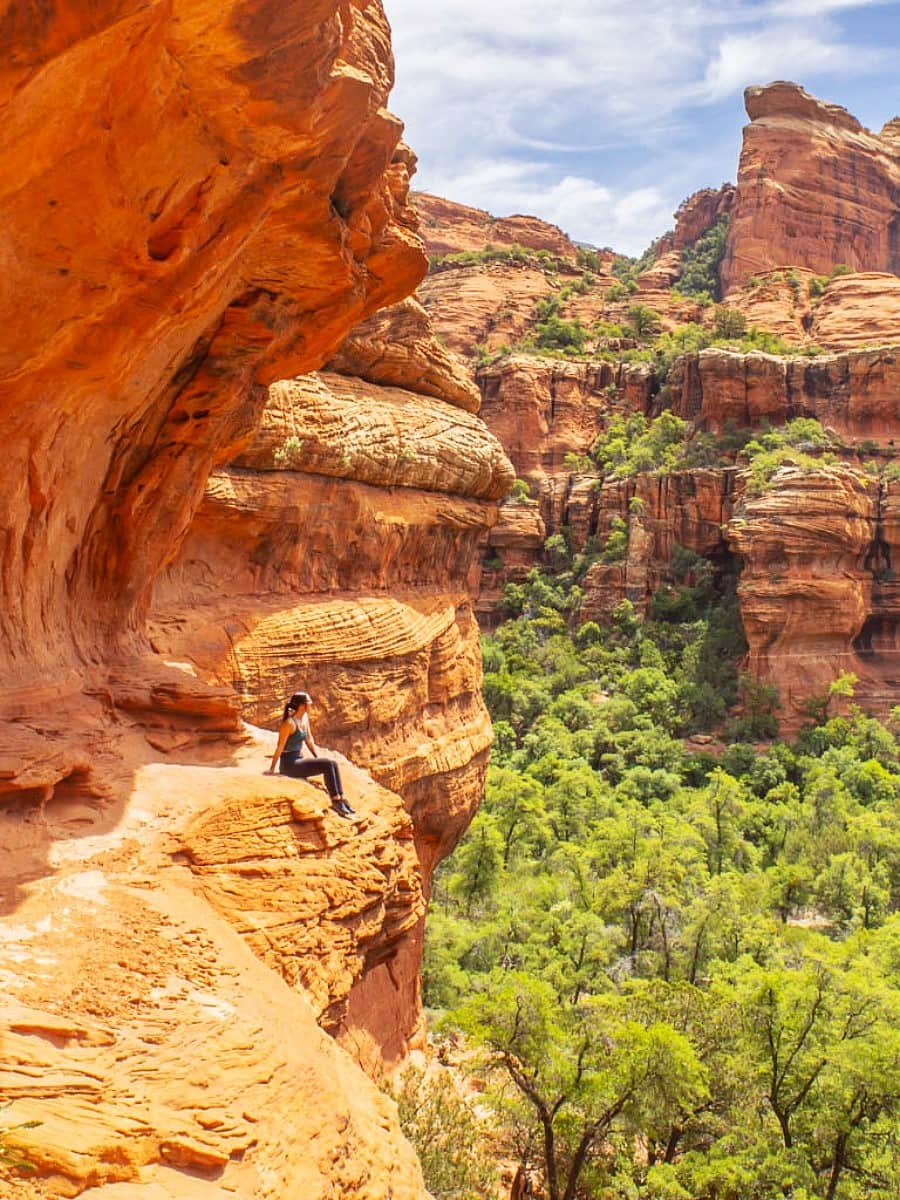
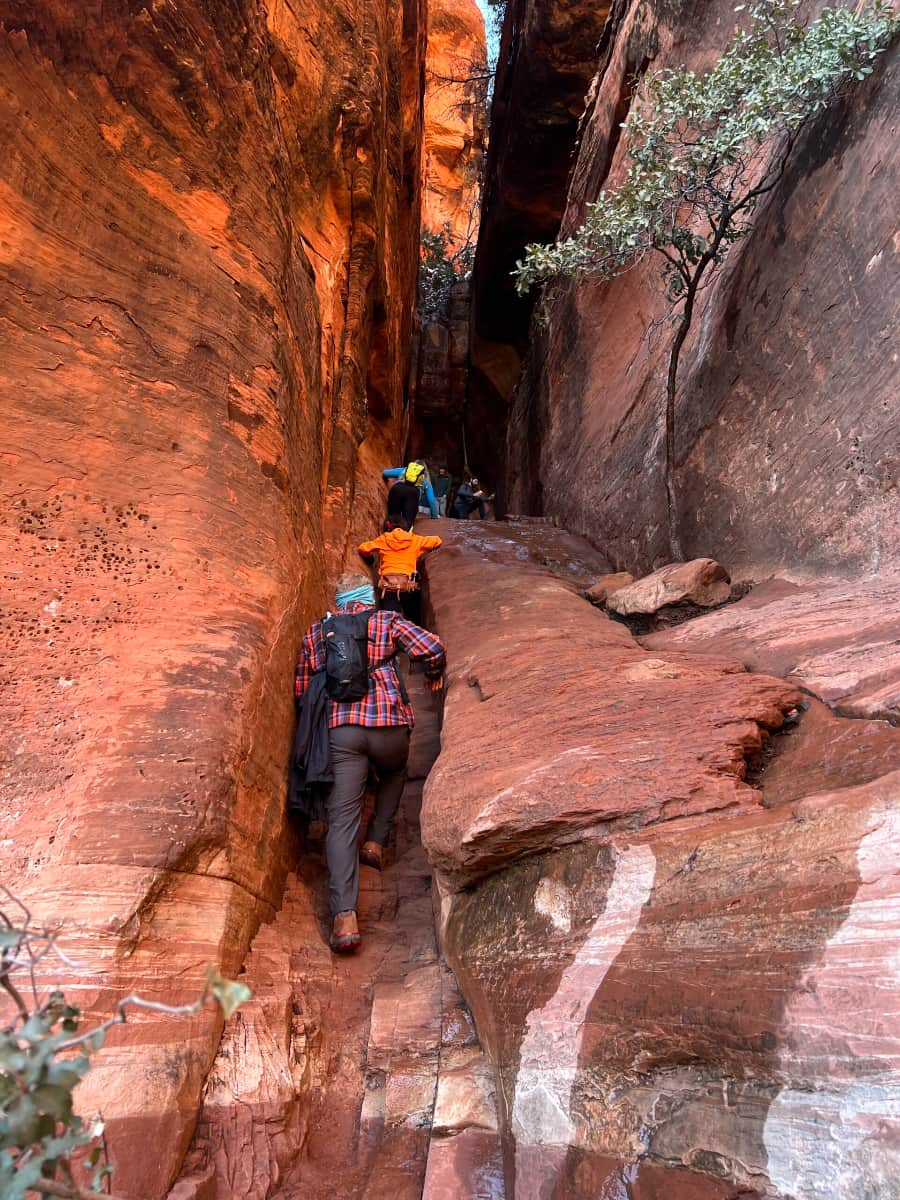
The four main Sedona vortex sites and their energy types:
- Airport Mesa – Upflow/masculine energy (strength, confidence)
- Cathedral Rock – Upflow/feminine energy (nurturing, compassion)
- Bell Rock – Balanced energy (harmony, equilibrium)
- Boynton Canyon – Balanced energy (introspection, inner peace)
Personal experience. At Boynton Canyon, I joined a small guided meditation session led by a local spiritual guide. We sat in silence for 20 minutes, and I felt an unusual warmth spreading through my body despite the cool morning air. Whether it was the power of suggestion or actual energy, the experience was genuinely calming and rejuvenating.
Visiting tips. You don’t need a guide to visit the vortexes-they’re all accessible via public trails-but many visitors appreciate the insights from local experts. Vortex tours range from $90-175 per person, with companies like Sedona Spirit, Earth Wisdom, and Mystical Bazaar offering different approaches from scientific to deeply spiritual.
| Vortex Site | Energy Type | Hiking Difficulty | Best Time to Visit |
|---|---|---|---|
| Airport Mesa | Masculine/Upflow | Easy (0.6 miles) | Sunset |
| Cathedral Rock | Feminine/Upflow | Moderate (1.5 miles) | Midday |
| Bell Rock | Balanced | Easy to Moderate | Morning |
| Boynton Canyon | Balanced | Moderate (6 miles) | Early morning |
⭐ Best Activities
- Sacred Sites and Vortexes Tour – Discover Sedona’s powerful energy vortexes on this spiritual tour that visits sites like Airport Mesa and Peace Park, where your guide shares insights about these unique energy centers and how to connect with them for personal transformation.
9. Sedona Spas
Relaxation havens. After days of hiking Sedona’s trails, I treated myself to a spa day that perfectly complemented the area’s natural healing energy. The Mii Amo Spa at Enchantment Resort offers treatments inspired by Native American traditions, including the “Circle of Life” massage that incorporates sage smudging and indigenous healing techniques.
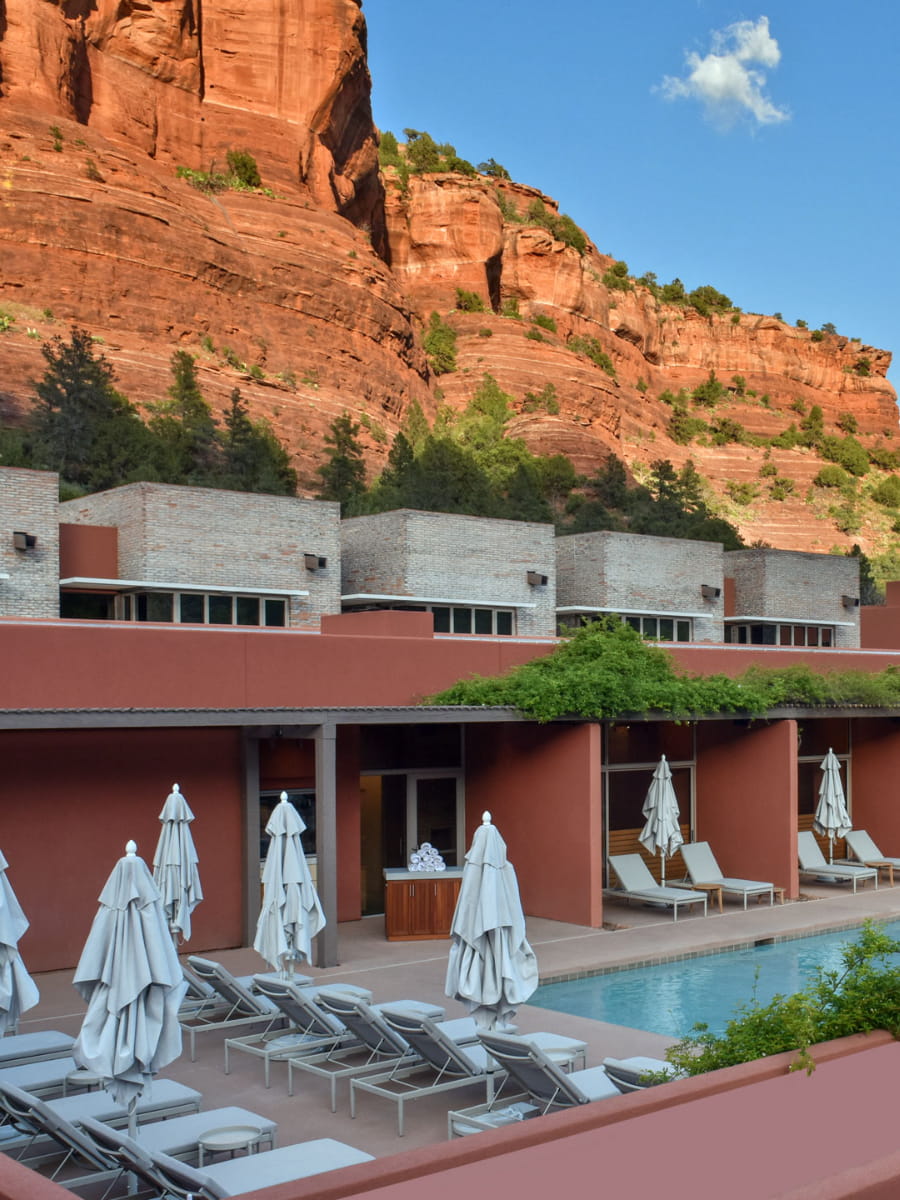
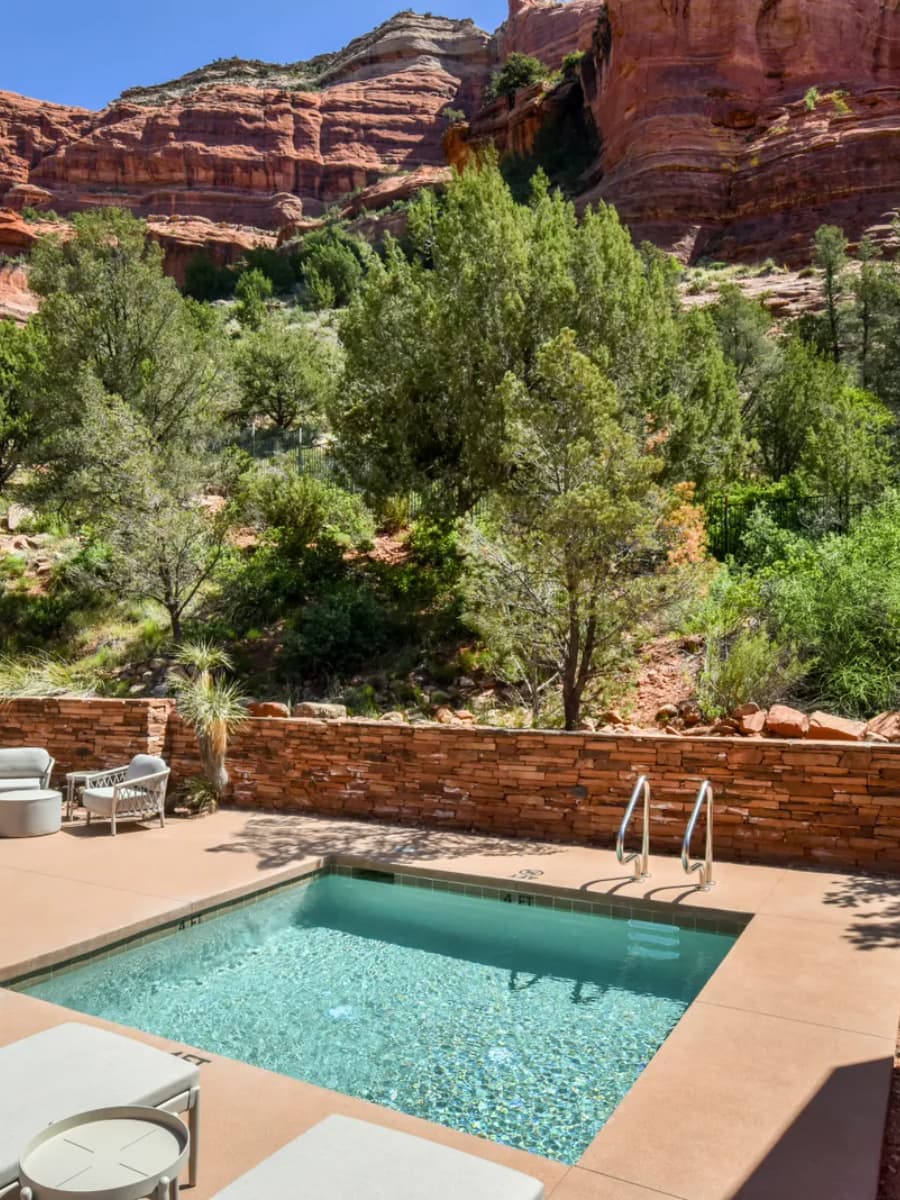
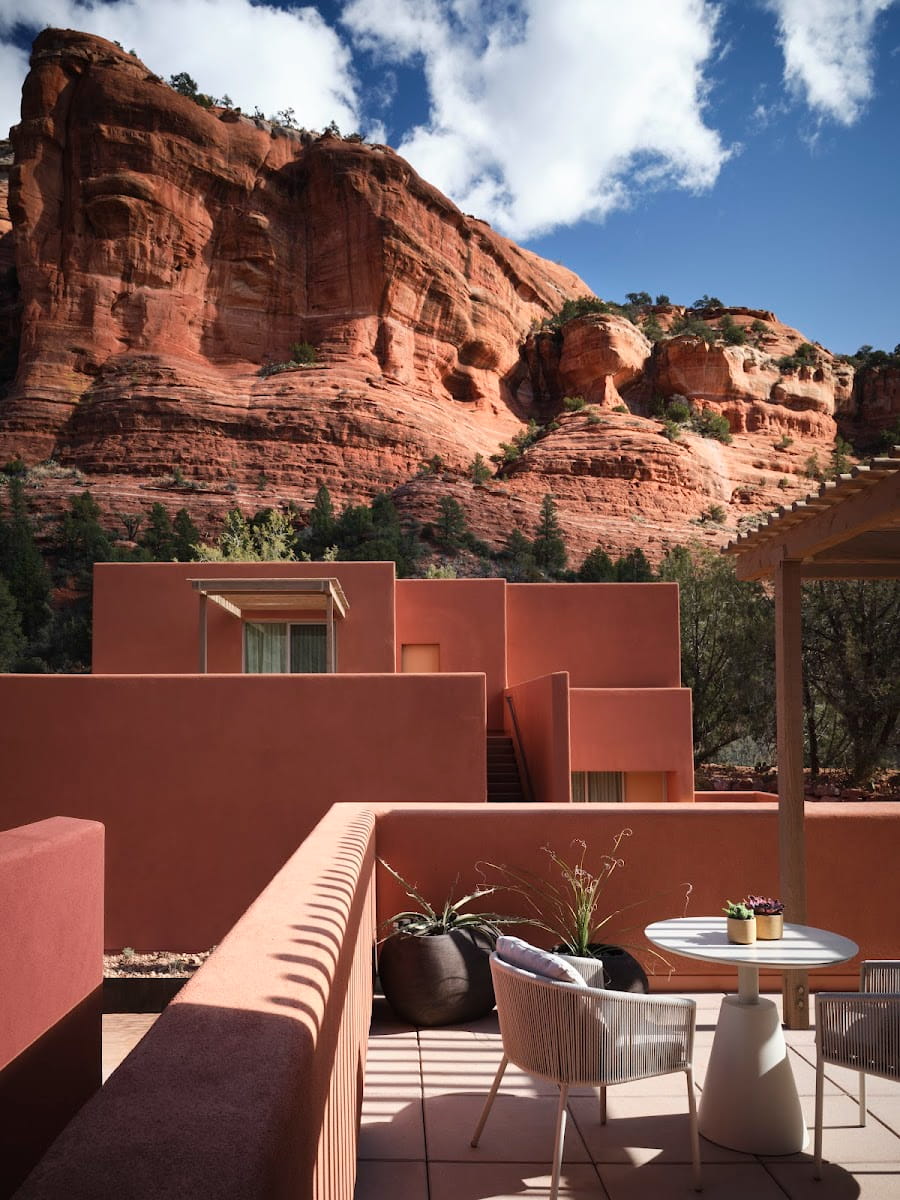
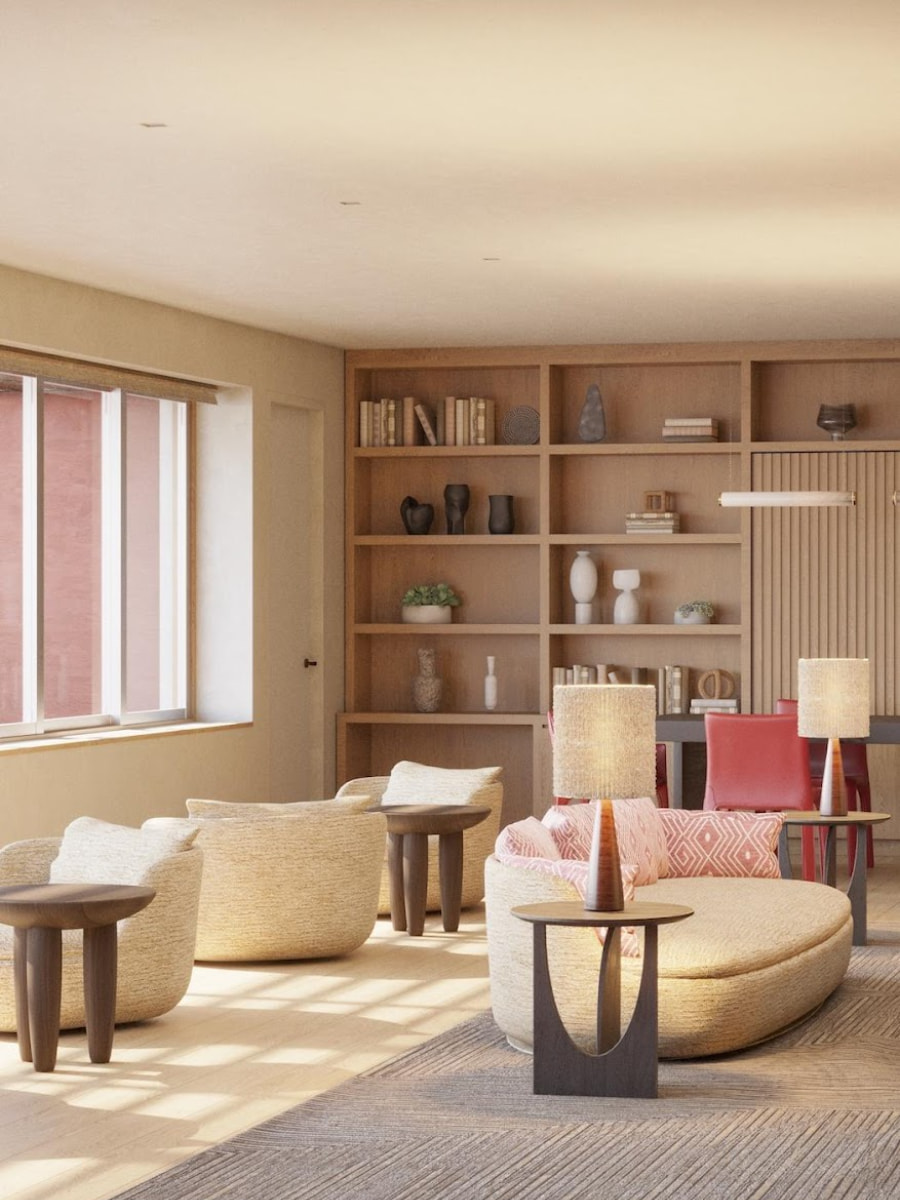
Unique treatments. What makes Sedona spas special is their incorporation of local elements. My “Red Rock Clay Wrap” at Sedona’s New Day Spa used clay harvested from the surrounding landscape, rich in minerals that detoxified my skin while I enjoyed a scalp massage. Other spas offer vortex-inspired energy work, sound healing with crystal bowls, and chakra balancing sessions.
- Red Rock Clay Body Wrap – Detoxifying and mineralizing
- Juniper Berry Scrub – Invigorating and purifying
- Prickly Pear Facial – Hydrating and antioxidant-rich
- Sedona Stone Massage – Deep muscle relaxation
- Aura Cleansing – Energy balancing and stress relief
Top destinations. The most luxurious experience is at Mii Amo or the Spa at Boynton Canyon (treatments from $175-350), but more affordable options include A Spa for You ($95-175) and Sedona’s New Day Spa ($85-195). Many hotels also offer excellent spa services, including Amara Resort and L’Auberge de Sedona, where treatments incorporate the sounds of nearby Oak Creek.
| Spa | Signature Treatment | Price Range | Unique Feature |
|---|---|---|---|
| Mii Amo | Spirit of the New Moon | $225-275 | Native American rituals |
| Spa at Boynton Canyon | Sedona Dreams Massage | $195-245 | Vortex energy work |
| A Spa for You | Red Rock Renewal | $125-175 | Mobile services available |
| Sedona’s New Day Spa | Desert Bloom Facial | $95-145 | Local botanical ingredients |
10. Sedona Psychic Reading
Spiritual encounters. Sedona’s reputation as a spiritual center has attracted many intuitive readers, psychics, and mediums to the area. Curious but skeptical, I booked a session with Claudia Coronado at the Center for the New Age, where her tarot reading provided surprisingly specific insights about my career path that left me wondering about the source of her knowledge.
Reading styles. The variety of metaphysical services available is impressive, from traditional tarot and palm readings to more unusual offerings like past life regression, channeling, and aura photography. Sessions typically last 30-60 minutes and range from $75-200 depending on the reader’s experience and reputation.
Types of readings available in Sedona:
- Tarot card readings
- Psychic intuitive readings
- Mediumship (connecting with departed loved ones)
- Aura and chakra analysis
- Past life regression
- Astrology chart interpretation
- Crystal ball scrying
Finding a reader. The Center for the New Age and Mystical Bazaar are good starting points, as they have multiple readers with different specialties. I recommend reading online reviews or asking for recommendations from your hotel concierge. Many respected readers book up weeks in advance, so scheduling ahead is wise during busy seasons.
Experience tips. Come with an open mind but healthy skepticism. The best readings focus on empowerment rather than predictions of doom. Consider preparing specific questions beforehand, but avoid giving too much information upfront-a skilled reader should provide insights without prompting. Whether you’re a true believer or just curious about this aspect of Sedona culture, a reading can be an interesting addition to your spiritual exploration of the area.
11. Stargazing Tours
Celestial wonders. Sedona’s dark sky designation makes it one of the best places in America for stargazing. I joined a tour and was blown away by the clarity of the night sky. Through high-powered telescopes, I saw Saturn’s rings, Jupiter’s moons, and distant galaxies that appeared as fuzzy patches to the naked eye but revealed incredible detail through the lens.


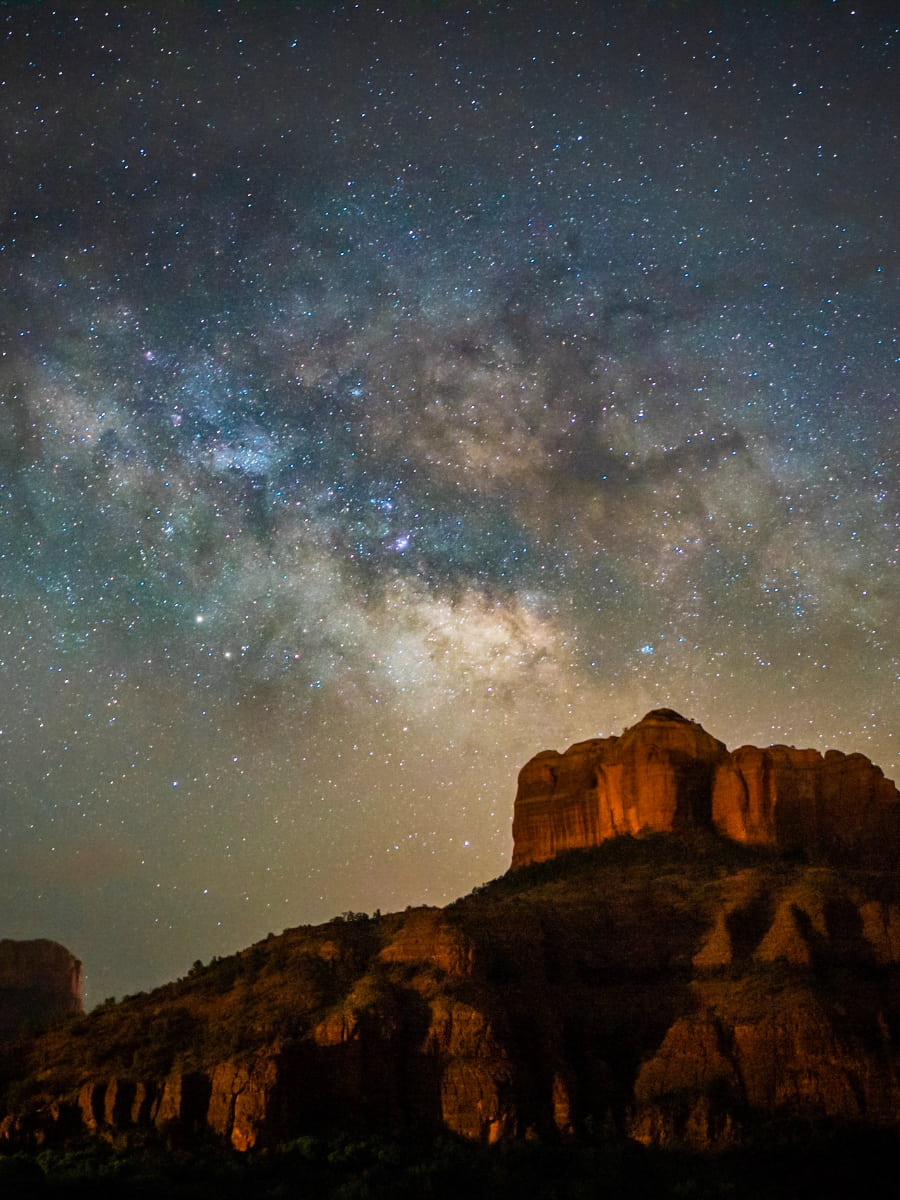
Tour experience. Our astronomer guide was passionate and knowledgeable, pointing out constellations with a laser pointer and sharing fascinating stories about ancient cultures’ interpretations of the night sky. The small group size (maximum 12 people) ensured everyone had plenty of time at each telescope, and the guide patiently answered all our questions.
What you’ll see on a Sedona stargazing tour:
- Planets (Mars, Jupiter, Saturn depending on season)
- Star clusters (Pleiades, Beehive Cluster)
- Nebulae (Orion Nebula, Ring Nebula)
- Galaxies (Andromeda, Whirlpool)
- Seasonal constellations and mythology
Preparation tips. Dress warmly as desert temperatures drop significantly at night, even in summer. Bring a red flashlight if you have one (to preserve night vision), and avoid wearing perfume or cologne as it can attract insects. Most tours provide folding chairs, blankets, and hot beverages. For photography enthusiasts, bring a tripod-though capturing the night sky requires specialized equipment, you’ll still want to document the experience.
⭐ Best Activities
- Sedona: Private Stargazing Tour with a Local Guide – Experience the magic of Sedona’s sky on this private stargazing tour where expert guides use powerful telescopes to reveal planets, star clusters, and distant galaxies against the backdrop of Sedona’s famous red rocks.
12. Palatki Heritage Site
Ancient dwellings. Palatki (meaning “red house” in Hopi) is one of the most significant archaeological sites near Sedona, featuring well-preserved cliff dwellings built by the Sinagua people around 1150-1300 CE. I was amazed by the ingenuity of these ancient architects who constructed multi-room structures tucked perfectly into the natural alcoves of the red rock cliffs.
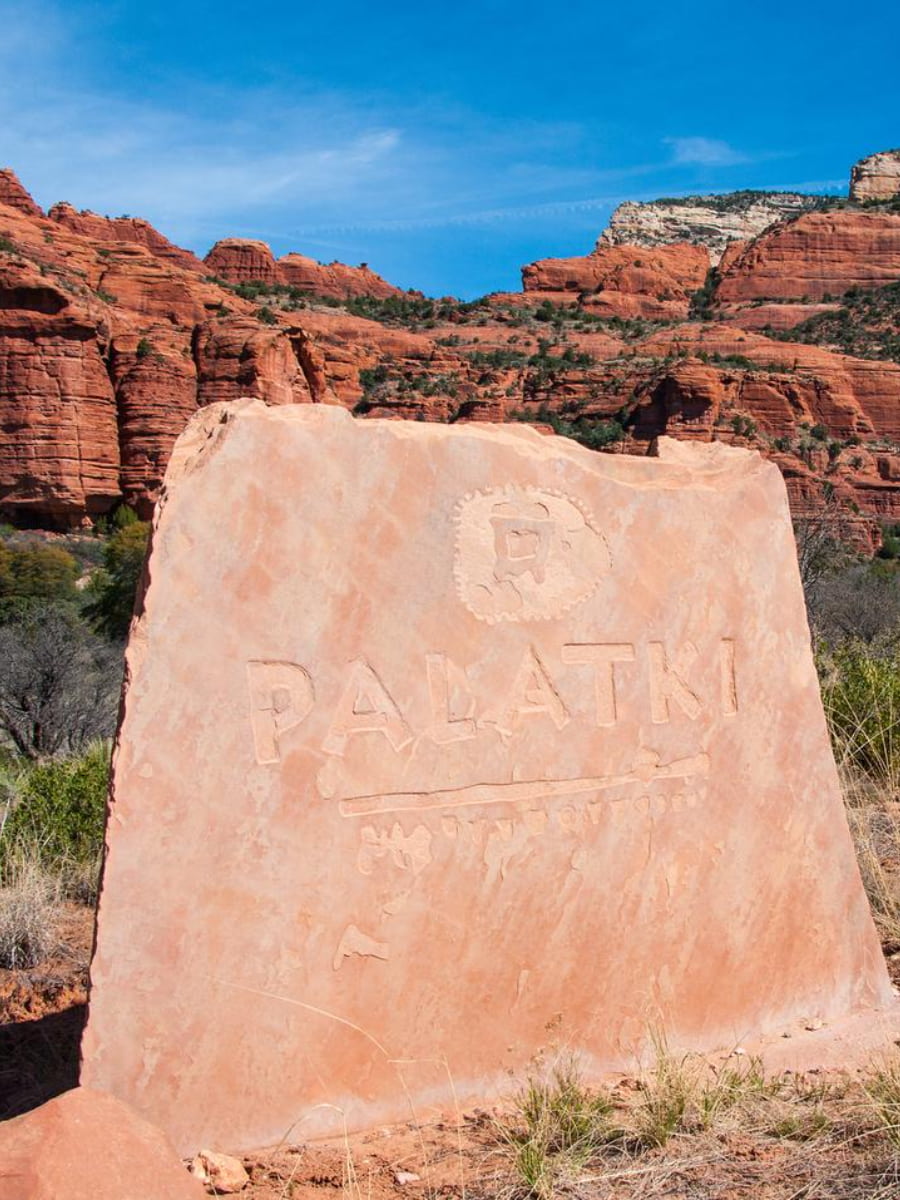
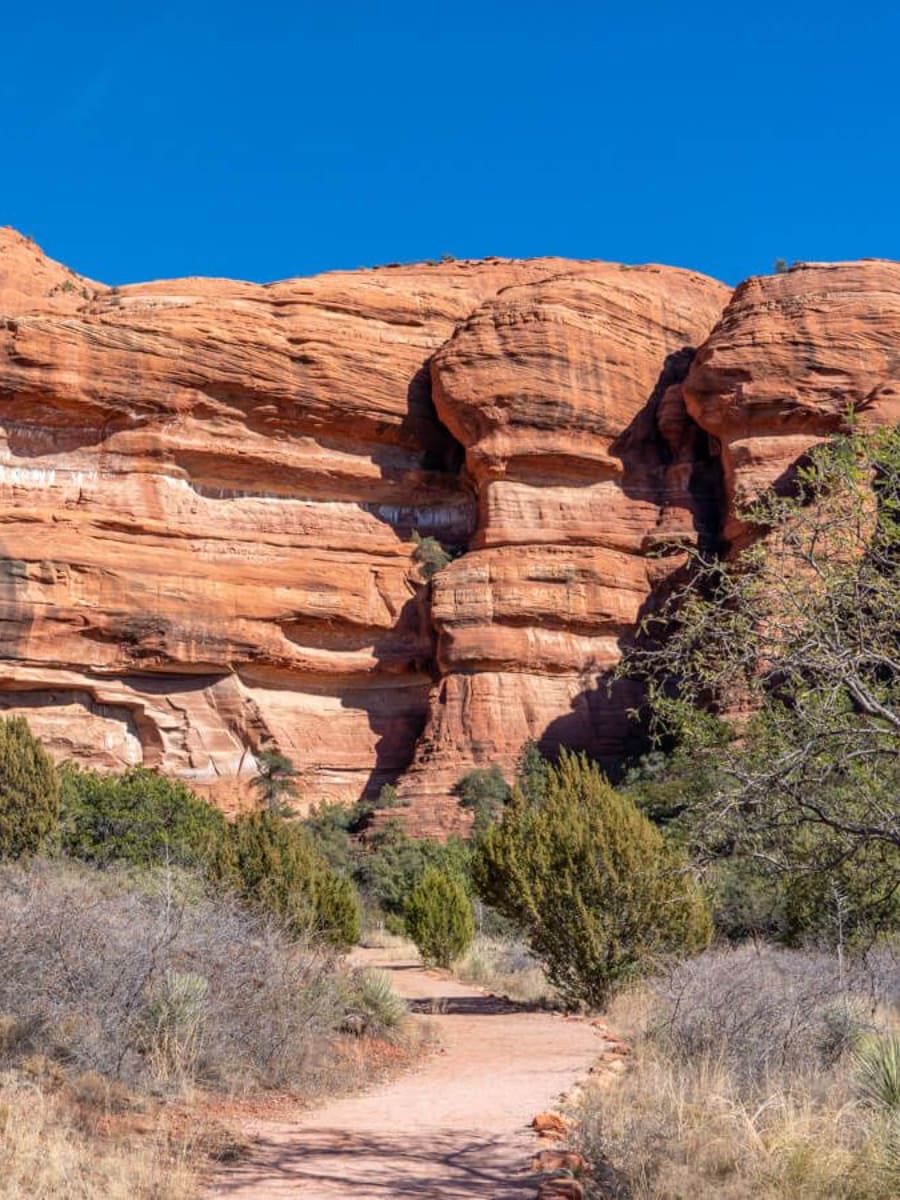
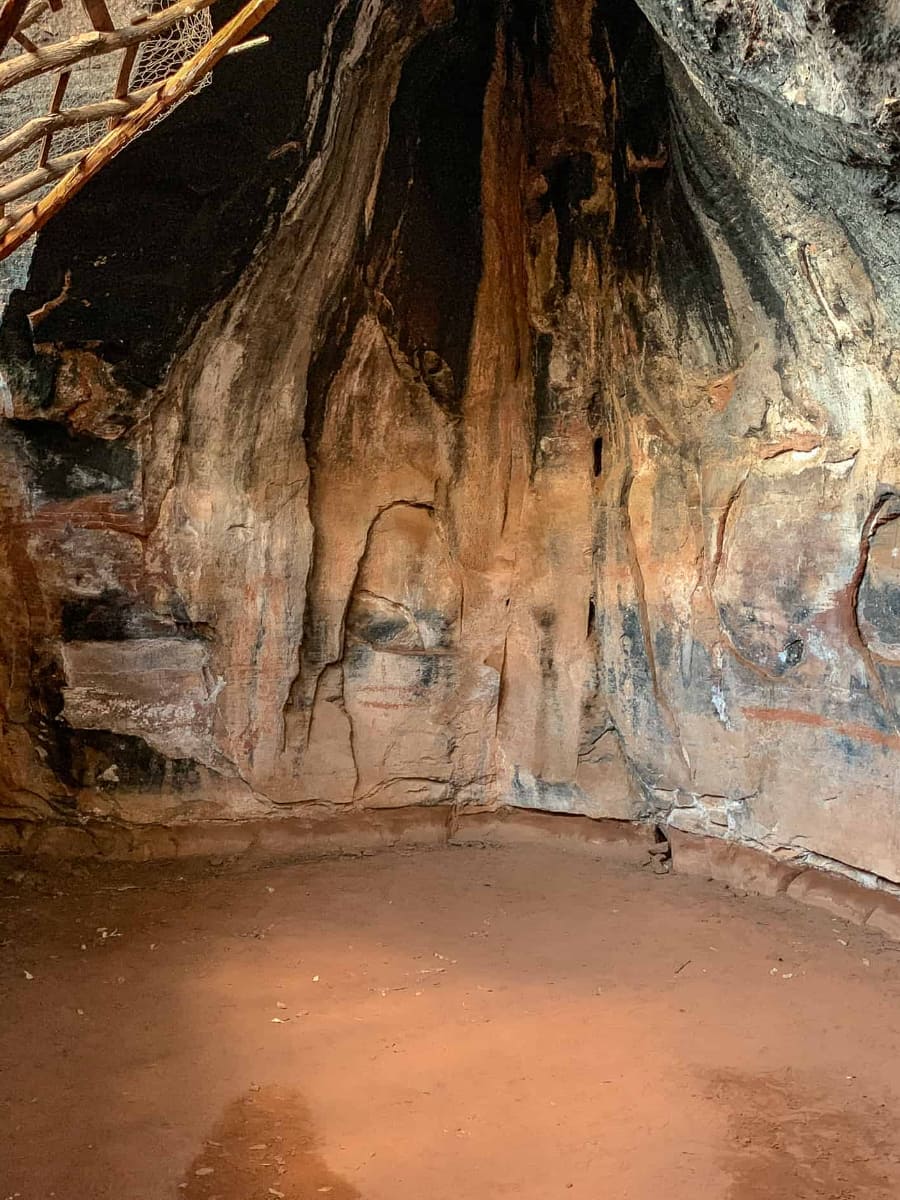
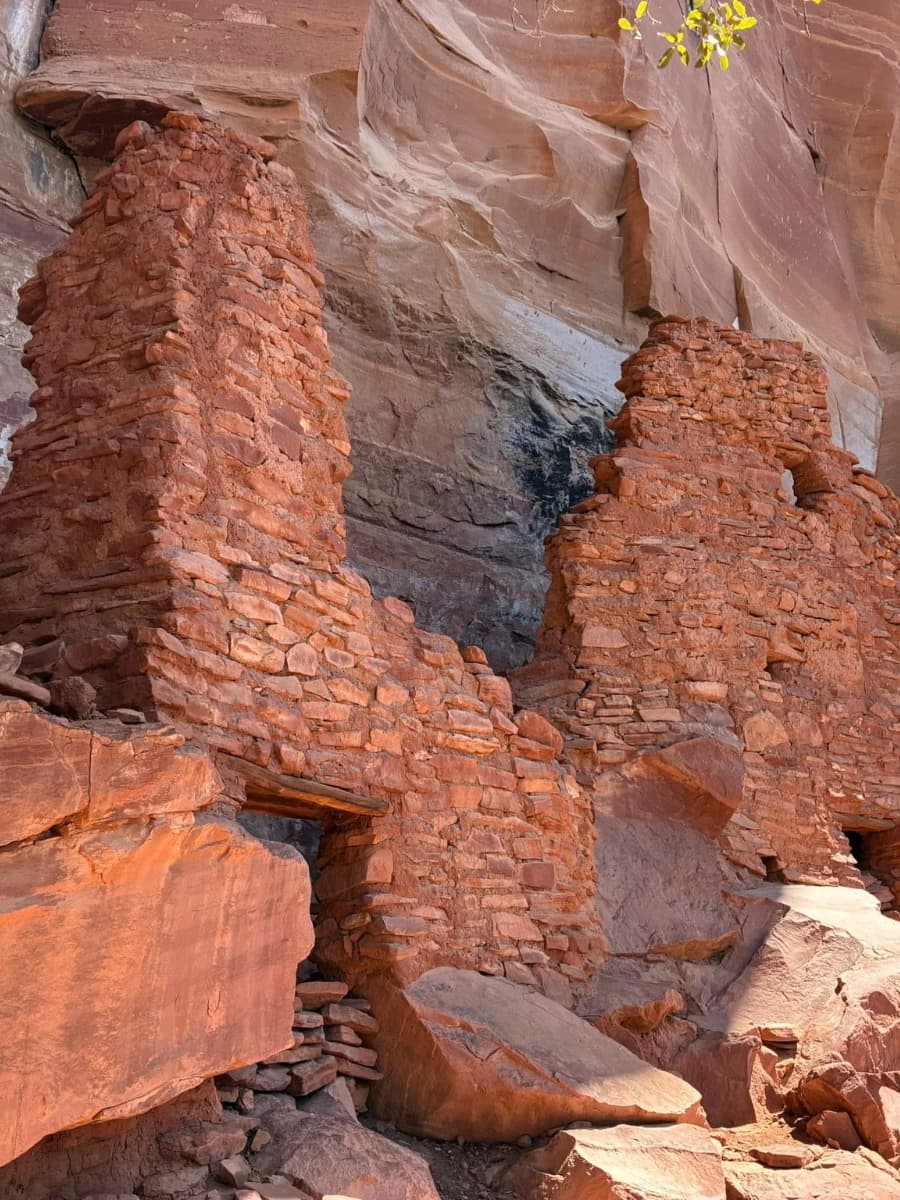
What you’ll see at Palatki Heritage Site:
- Ancient pictographs and petroglyphs from multiple cultures
- Grinding stones used for food preparation
- Evidence of agricultural practices
- Spectacular red rock canyon views
Visiting details. Located about 15 miles from Sedona, Palatki requires advance reservations ($6 per adult) as they limit visitors to 10 people per hour to protect the site. Call the Red Rock Ranger District (928-203-2900) up to 4 days ahead to secure your spot. The site is open 9:30 AM – 3:00 PM daily except major holidays.
Access information. The final 4.5 miles to Palatki are on a rough dirt road that can be challenging after rain. While most passenger cars can make it when dry, high-clearance vehicles are recommended. Tours last about 45 minutes per trail, and I suggest allowing 2-3 hours total to fully appreciate all three areas. Wear sturdy shoes and bring water, as there are no services at the site.
⭐ Best Activities
- Hopi Lands: Archaeology and Culture Day Tour – Journey into the ancient world of the Hopi people on this cultural tour that visits traditional villages, archaeological sites, and art galleries while learning about one of America’s oldest continuously inhabited indigenous cultures.
13. Honanki Heritage Site
Sister site. Honanki, meaning “bear house” in Hopi, is Palatki’s sister site and one of the largest cliff dwellings in the Red Rock country. Built by the Sinagua culture between 1100-1300 CE, this impressive structure once contained more than 60 rooms spread across multiple levels. I was struck by how the natural red rock alcove perfectly sheltered the dwellings from rain while providing strategic defensive advantages.
Rock art gallery. What makes Honanki particularly special is its extensive collection of pictographs and petroglyphs spanning three distinct time periods. The white figures likely represent the earliest Archaic period (up to 8,000 years ago), while the red designs belong to the Sinagua, and the more recent white paintings are attributed to the Yavapai and Apache peoples who arrived later.
Key features of Honanki Heritage Site:
- Three distinct periods of rock art
- Evidence of ancient construction techniques
- Original wooden support beams
- Spectacular canyon setting
Practical information. Located about 12 miles from Sedona via Forest Road 525, Honanki is slightly more accessible than Palatki but still requires driving on unpaved roads. Unlike Palatki, reservations aren’t required, though the $6 Red Rock Pass is needed for parking. The site is open daily from 9:30 AM to 3:00 PM and typically sees fewer visitors than its sister site.
Visitor experience. Self-guided tours are available with informational signs explaining the site’s history and features. I spent about an hour exploring the main dwelling area and rock art panels. The 1/4-mile trail is relatively flat but uneven in places. For a deeper understanding, I recommend bringing a guidebook or downloading the Forest Service’s mobile app which offers additional historical context.
14. Sedona Art Galleries
Creative hub. Sedona’s stunning landscape has attracted artists for generations, resulting in one of the highest concentrations of galleries per capita in the country. I spent a delightful afternoon gallery-hopping in Uptown Sedona and Tlaquepaque, where I discovered everything from traditional Southwestern paintings to contemporary sculpture and Native American jewelry.
Artistic diversity. What impressed me most was the variety of styles and media represented. At Exposures International, I marveled at life-sized bronze sculptures and massive landscape paintings, while Lanning Gallery showcased more contemporary works. The Sedona Arts Center, a community hub since 1958, offers rotating exhibitions featuring local artists alongside workshops where visitors can try their hand at various techniques.
Must-visit Sedona art galleries include:
- Exposures International (largest gallery in the Southwest)
- Tlaquepaque Arts & Crafts Village (collection of smaller galleries)
- Sedona Arts Center (community art hub with classes)
- Goldenstein Gallery (contemporary Southwestern art)
- Turquoise Tortoise (Native American art and jewelry)
Art walks. I timed my visit to coincide with the 1st Friday Gallery Tour (5-8 PM on the first Friday each month), when galleries stay open late and often serve complimentary wine and appetizers. Artists are frequently present to discuss their work, creating a festive atmosphere that attracts both serious collectors and casual browsers.
Shopping tips. Prices range widely from small $50 prints to major works costing thousands. Most galleries ship nationwide, so don’t let travel constraints limit your purchases. I found the staff knowledgeable and not pushy-they’re happy to educate visitors about the artists and techniques even if you’re just browsing. For authentic Native American pieces, look for artist signatures and ask about the tribe and region represented in the work.
15. Verde Valley Wine Trail
Wine country surprise. Just a short drive from Sedona lies the Verde Valley Wine Trail, Arizona’s emerging wine region that’s gaining national recognition. I spent a day exploring this beautiful area, where vineyards are nestled between red rock formations and the Verde River creates a microclimate perfect for growing Mediterranean and Spanish grape varieties.
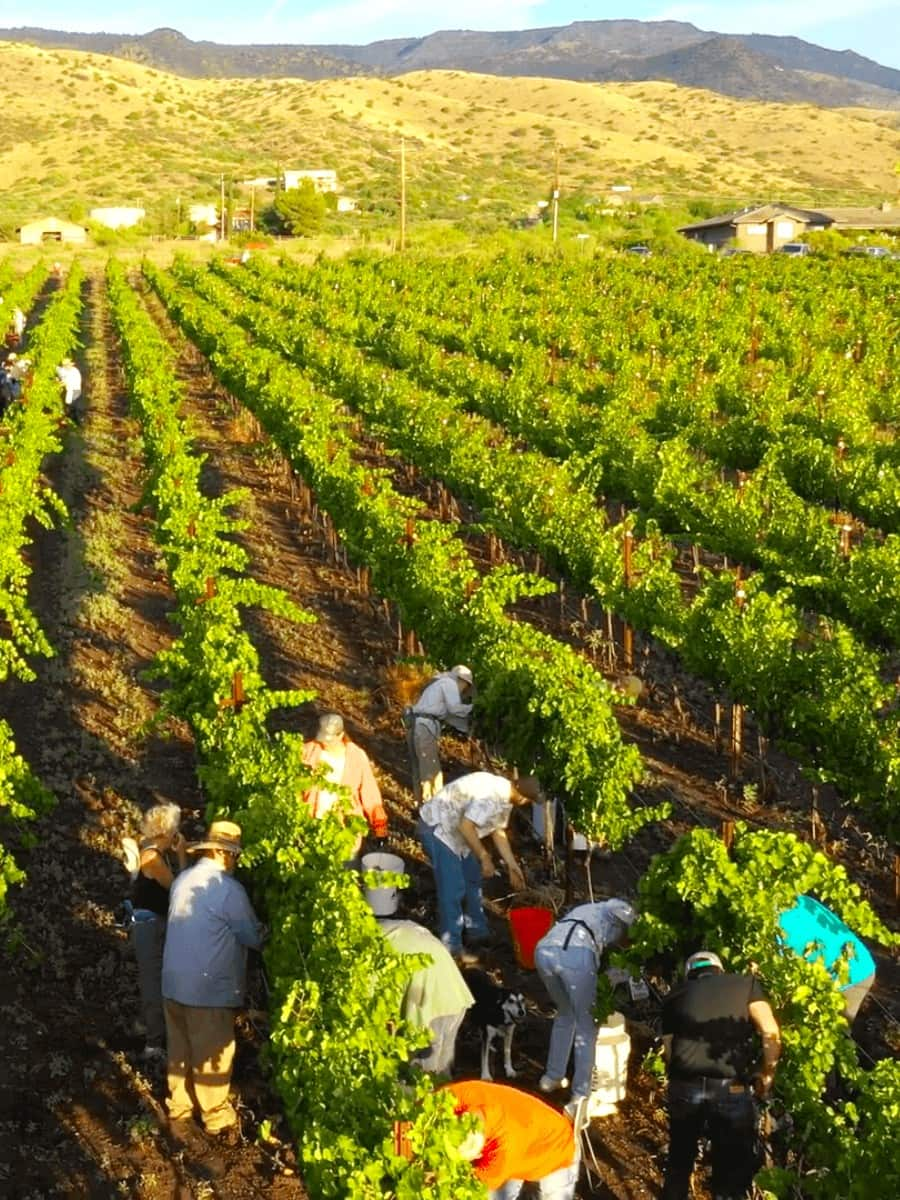
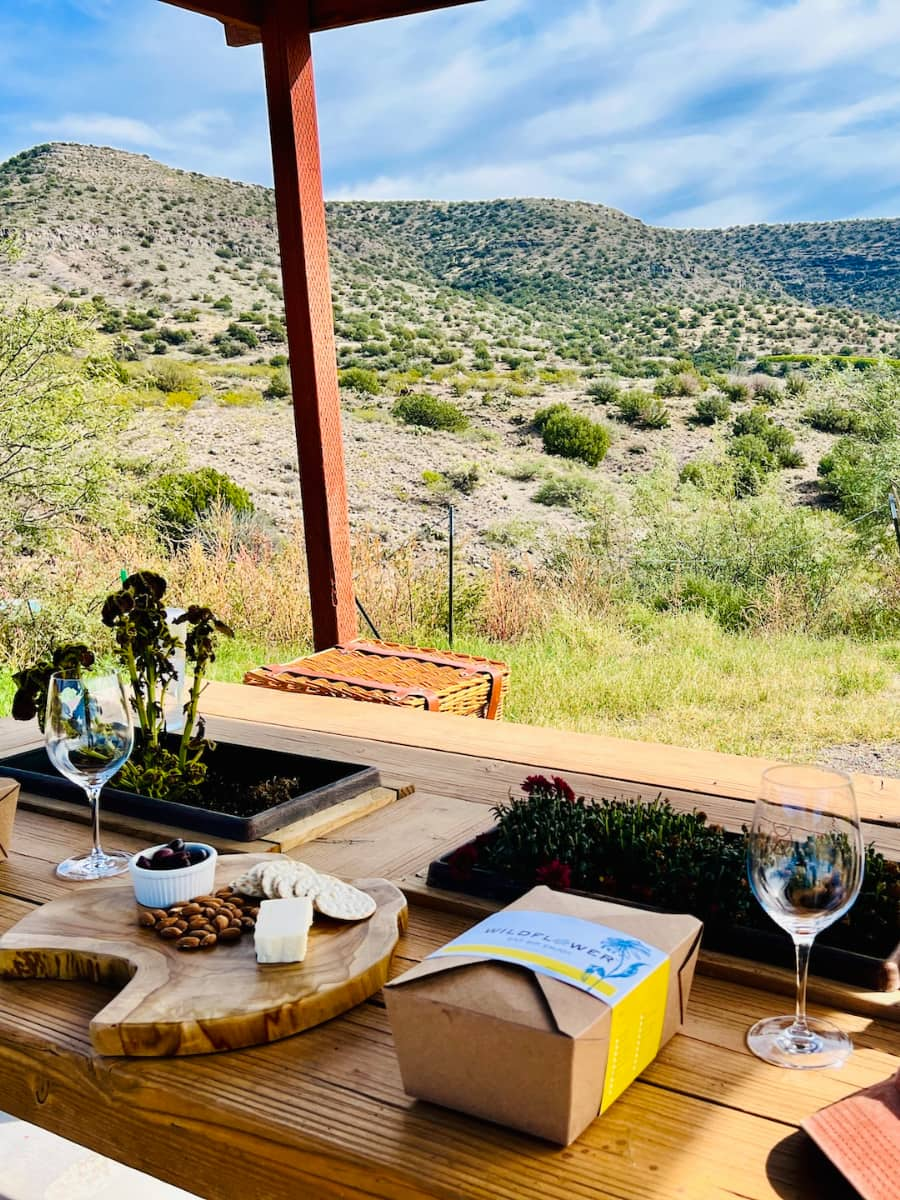
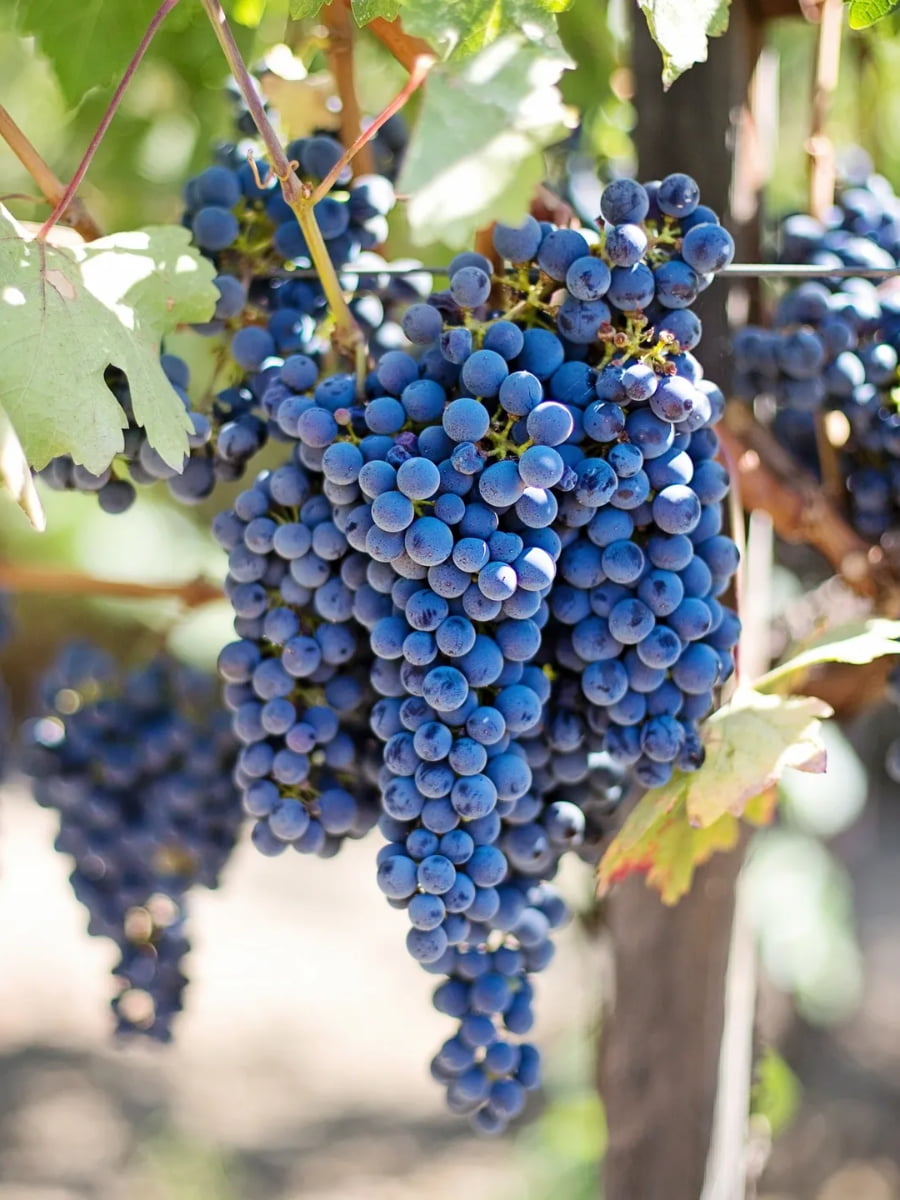
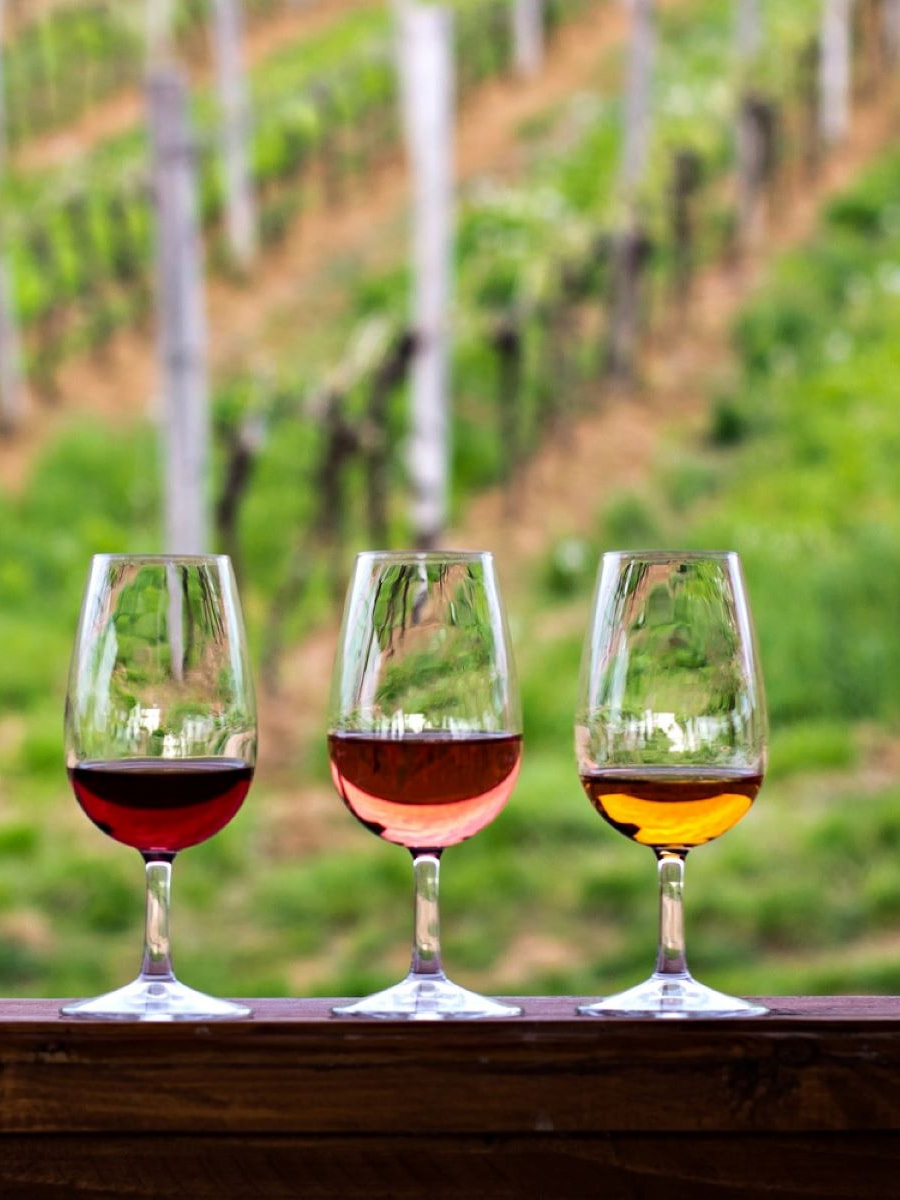
Winery experiences. Each stop on the trail offers something unique. At Page Springs Cellars, I enjoyed a creek-side tasting with views of the vineyards climbing the hillside. Alcantara Vineyards impressed me with its Tuscan-inspired setting at the confluence of the Verde River and Oak Creek, while Javelina Leap offered the most educational experience with detailed explanations of their winemaking process.
Verde Valley Wine Trail highlights:
- Page Springs Cellars – Rhône-style wines with creek-side tastings
- Alcantara – Mediterranean varieties in a scenic setting
- Javelina Leap – Award-winning small-batch wines
- Oak Creek – Relaxed atmosphere with cheese pairings
- Chateau Tumbleweed – Creative blends with artistic labels
Tasting details. Most wineries charge $12-15 for a flight of 5-6 wines, with fees typically waived with bottle purchases. For a comprehensive experience, pick up a Wine Trail Passport ($5 at any participating location), which includes a map and special offers. Getting your passport stamped at all locations earns you a souvenir wine glass.
| Winery | Signature Wine | Tasting Fee | Special Feature |
|---|---|---|---|
| Page Springs Cellars | Syrah | $15 | Vineyard tours, creek-side patio |
| Alcantara Vineyards | Viognier | $14 | Tuscan-style setting, river views |
| Javelina Leap | Zinfandel | $12 | Small-batch production, barrel room |
| Oak Creek Vineyards | Chardonnay | $12 | Cheese and chocolate pairings |
| Chateau Tumbleweed | “The Descendants” blend | $15 | Quirky labels, innovative blends |
⭐ Best Activities
- Wine Trail Tour – Sample Arizona’s emerging wine scene on this guided tour through picturesque places, where you’ll learn about the unique terroir that creates the region’s distinctive wines while visiting multiple family-owned wineries and tasting rooms.
16. Sedona Mountain Biking
Trail paradise. Sedona offers some of the best mountain biking in the Southwest, with over 200 miles of trails ranging from beginner-friendly paths to technical routes that challenge even expert riders. I rented a full-suspension bike from Over the Edge Sports and tackled the famous Hiline Trail, where flowing singletrack alternates with technical sections across the red slickrock.
Varied terrain. What makes Sedona mountain biking special is the diversity of experiences. Bell Rock Pathway offered smooth riding with spectacular views, while Mescal Trail tested my skills with narrow ledges and tight switchbacks. The red rock surface provides excellent traction even after rain, though the sharp edges can be tough on tires-I was glad I opted for the tubeless rental.
Popular mountain biking trails by difficulty level:
- Beginner: Bell Rock Pathway, Slim Shady (lower section)
- Intermediate: Mescal Trail, Llama Trail, Templeton
- Advanced: Hiline Trail, Hangover Trail, The Hog
- Expert: White Line, Sketch, Damifino
Rental information. Quality full-suspension bikes rent for $65-95 per day from shops like Over the Edge Sports, Absolute Bikes, and Thunder Mountain Bikes. Most shops provide trail maps and recommendations based on your skill level. For first-timers to the area, I highly recommend hiring a guide ($85-150 per person) who can tailor the experience to your abilities and show you hidden gems.
Riding tips. The best seasons for mountain biking are spring (March-May) and fall (September-November) when temperatures are moderate. Summer rides should start early (before 8 AM) to avoid the midday heat. Always carry more water than you think you’ll need-the dry climate is deceptive. Most trails are well-marked with cairns and signs, but downloading the TrailForks app provides helpful GPS navigation.
⭐ Best Activities
- EZRider Sedona Self-Guided E-Bike Tour – Explore Sedona at your own pace with this self-guided e-bike adventure that includes high-quality electric bikes, custom route maps, and insider tips to discover scenic trails and hidden viewpoints throughout the red rock landscape.
17. Sedona Horseback Riding
Western tradition. Exploring Sedona’s red rock country on horseback connected me to the area’s cowboy heritage while accessing stunning viewpoints away from the crowds. My sunset ride with Trail Horse Adventures took us through Dry Creek Basin, where our guide pointed out ancient Native American ruins I would have missed on my own and shared fascinating stories about the area’s history.
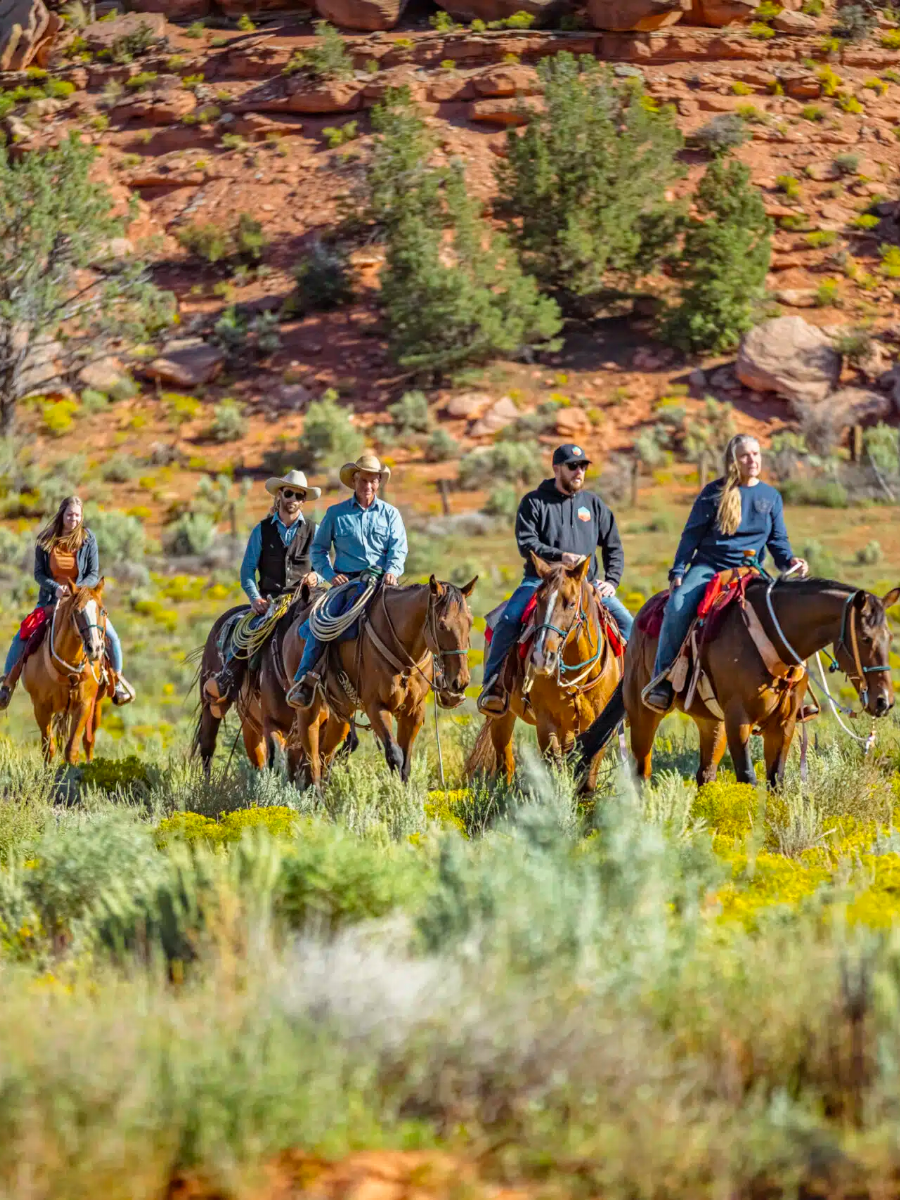
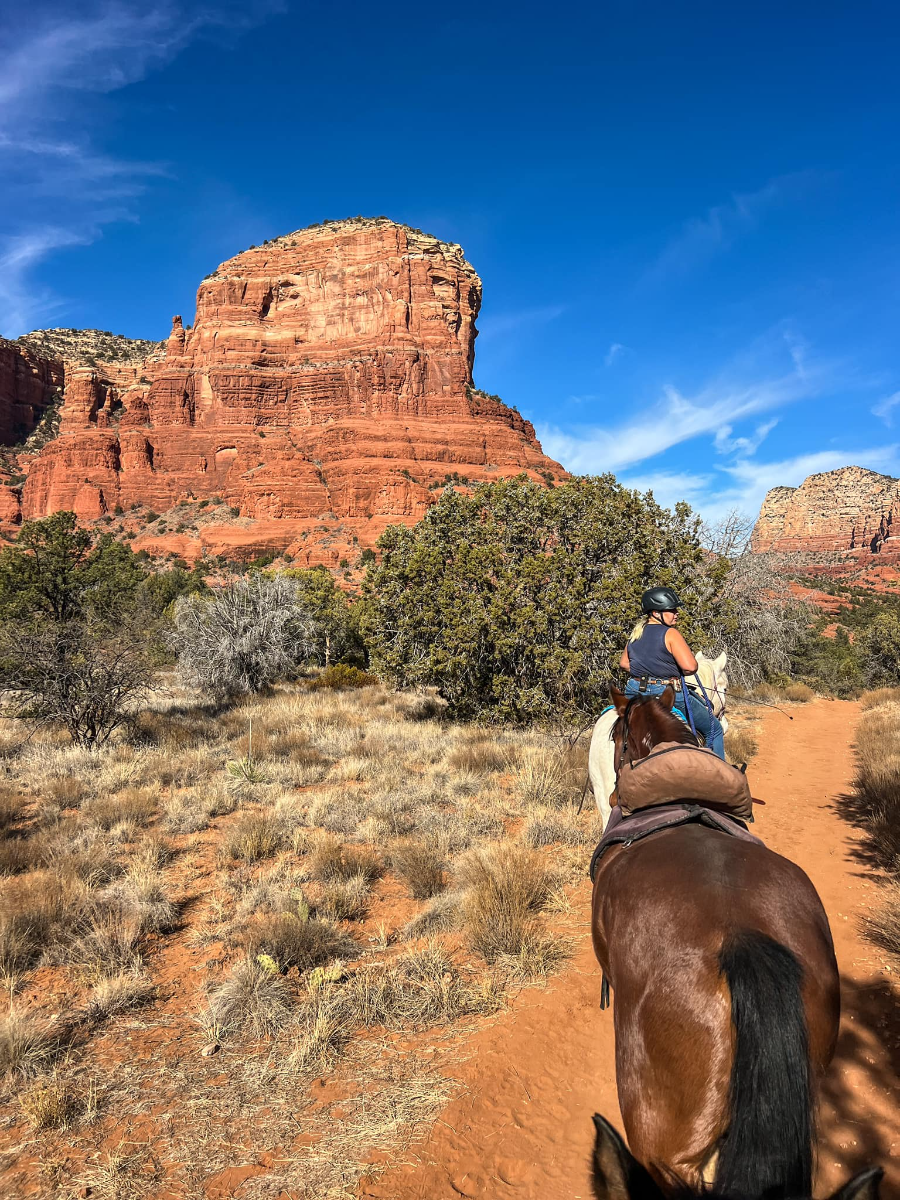
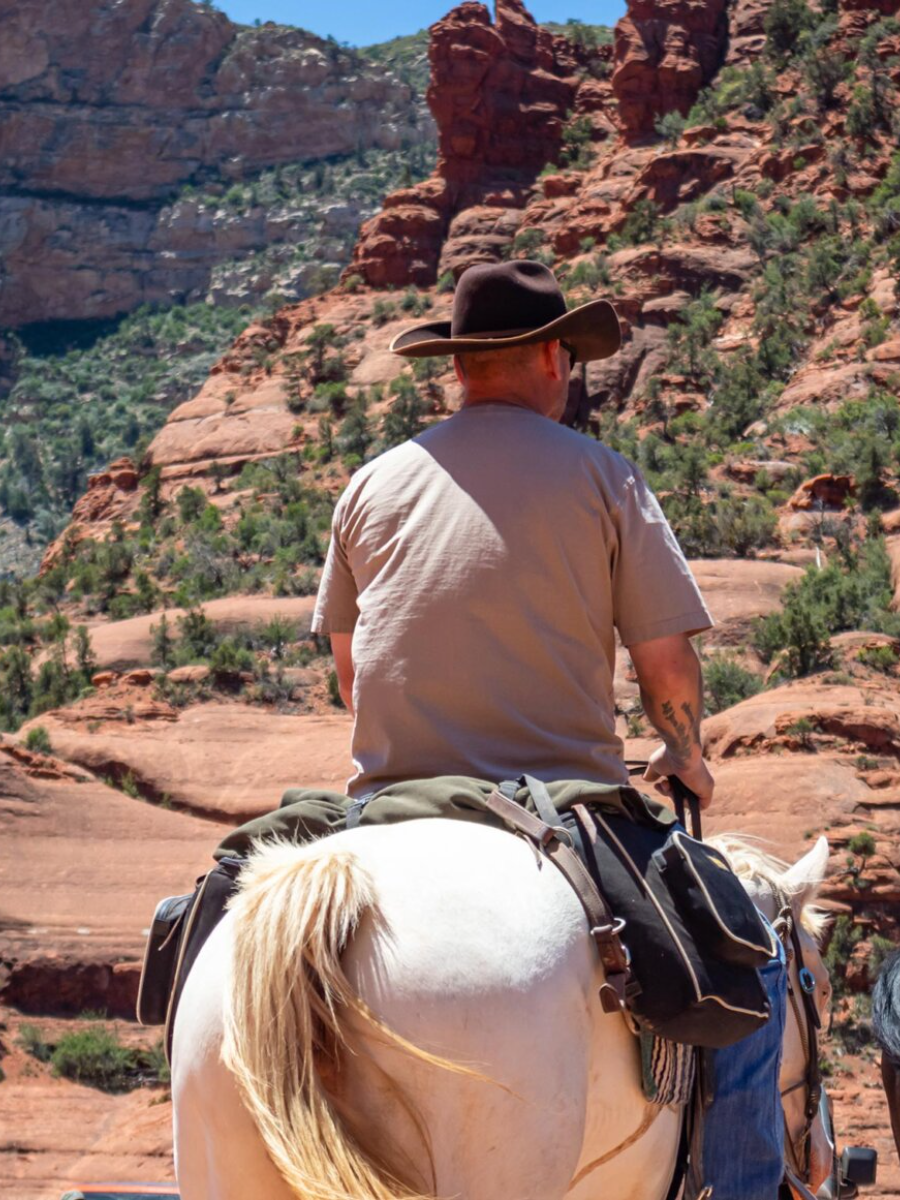
Riding options. Most outfitters offer rides ranging from 1-3 hours, with some including special experiences like cowboy cookouts or wine tastings. I found the 2-hour ride perfect-long enough to reach remote areas but not so long that beginners get uncomfortable. For experienced riders, private rides can be arranged that include more challenging terrain and opportunities to trot or canter.
What to expect on a Sedona horseback ride:
- Safety orientation and basic riding instruction
- Western saddles (more comfortable for beginners)
- Small groups (typically 6-8 riders maximum)
- Knowledgeable guides sharing local history and geology
- Plenty of photo opportunities at scenic viewpoints
Top outfitters. I researched several companies before booking with Trail Horse Adventures ($95 for 2 hours), but A Day in the West, M Diamond Ranch, and Horsin’ Around Adventures also have excellent reputations. Prices range from $75-150 depending on duration and inclusions. The sunset rides typically cost $10-20 more but offer magical lighting for photos and cooler temperatures.
Preparation advice. Wear long pants and closed-toe shoes with a small heel (hiking boots work well). Most outfitters provide helmets, though they’re often optional for adults. Apply sunscreen and bring water, even for shorter rides. No previous riding experience is necessary for basic trail rides, as the horses are well-trained and follow each other nose-to-tail. Weight limits typically range from 225-250 pounds depending on the outfitter.
Things to Do in Sedona with Kids
1. Blazin’ M Ranch Western Show
Cowboy entertainment. Blazin’ M Ranch in nearby Cottonwood offers the perfect family evening with its authentic western town experience and chuck wagon dinner show. My kids were thrilled by the pre-dinner activities including roping lessons, vintage tractor rides, and an old-time photo studio where we dressed up as outlaws and sheriffs for a hilarious family portrait.
Dinner and show. The all-you-can-eat barbecue dinner features tender beef brisket, BBQ chicken, baked beans, and cornbread served on tin plates for that authentic chuck wagon feel. While the food is hearty rather than gourmet, the real highlight is the after-dinner entertainment by the Blazin’ M Cowboys, who perform classic western songs, comedy routines, and impressive trick roping that had my children wide-eyed with amazement.
What’s included in the Blazin’ M Ranch experience:
- Western Town activities (5:00-6:30 PM)
- Chuck wagon dinner (6:30 PM)
- Live western music and comedy show (7:30 PM)
- Gift shop with western souvenirs
- Free parking
Practical tips. Located about 20 minutes from Sedona in Cottonwood, Blazin’ M Ranch operates seasonally (typically March-December) with shows running most evenings except Sundays and Mondays. Tickets cost $49.95 for adults and $24.95 for children 3-12, with reservations strongly recommended, especially during spring break and summer months.
Family tips. Arrive at 5:00 PM when the western town opens to enjoy all the pre-dinner activities. The show runs about 90 minutes and ends around 9:00 PM, making it manageable even with younger children. While alcoholic beverages are available for purchase, the atmosphere remains completely family-friendly. My kids still talk about learning to lasso and the cowboy who played “The Devil Went Down to Georgia” on his fiddle!
2. Sedona Heritage Museum
Living history. Housed in the historic Jordan farmstead, the Sedona Heritage Museum offers a fascinating glimpse into the area’s pioneer past that my children found surprisingly engaging. The main house and apple packing shed have been preserved with period furnishings, while interactive exhibits demonstrate how early settlers lived off the land long before Sedona became a tourist destination.
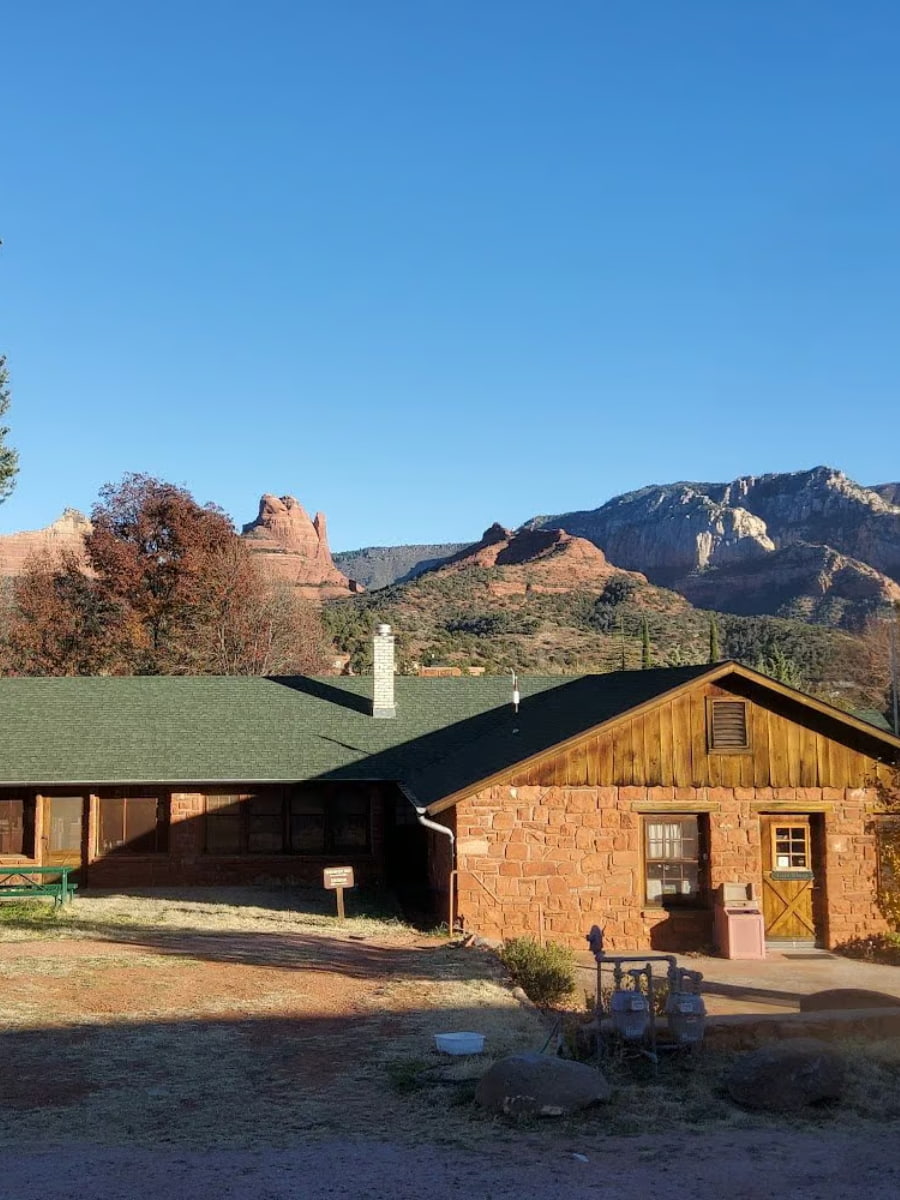
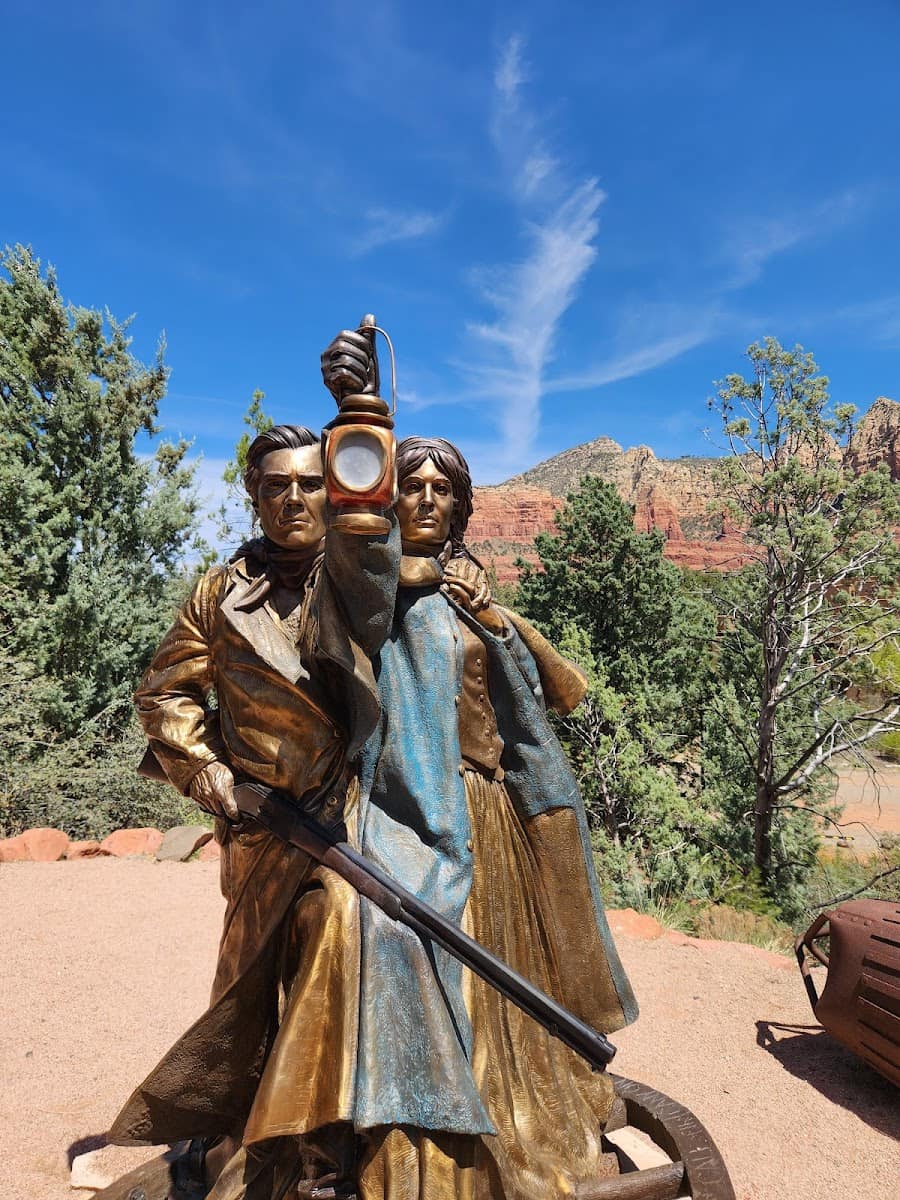
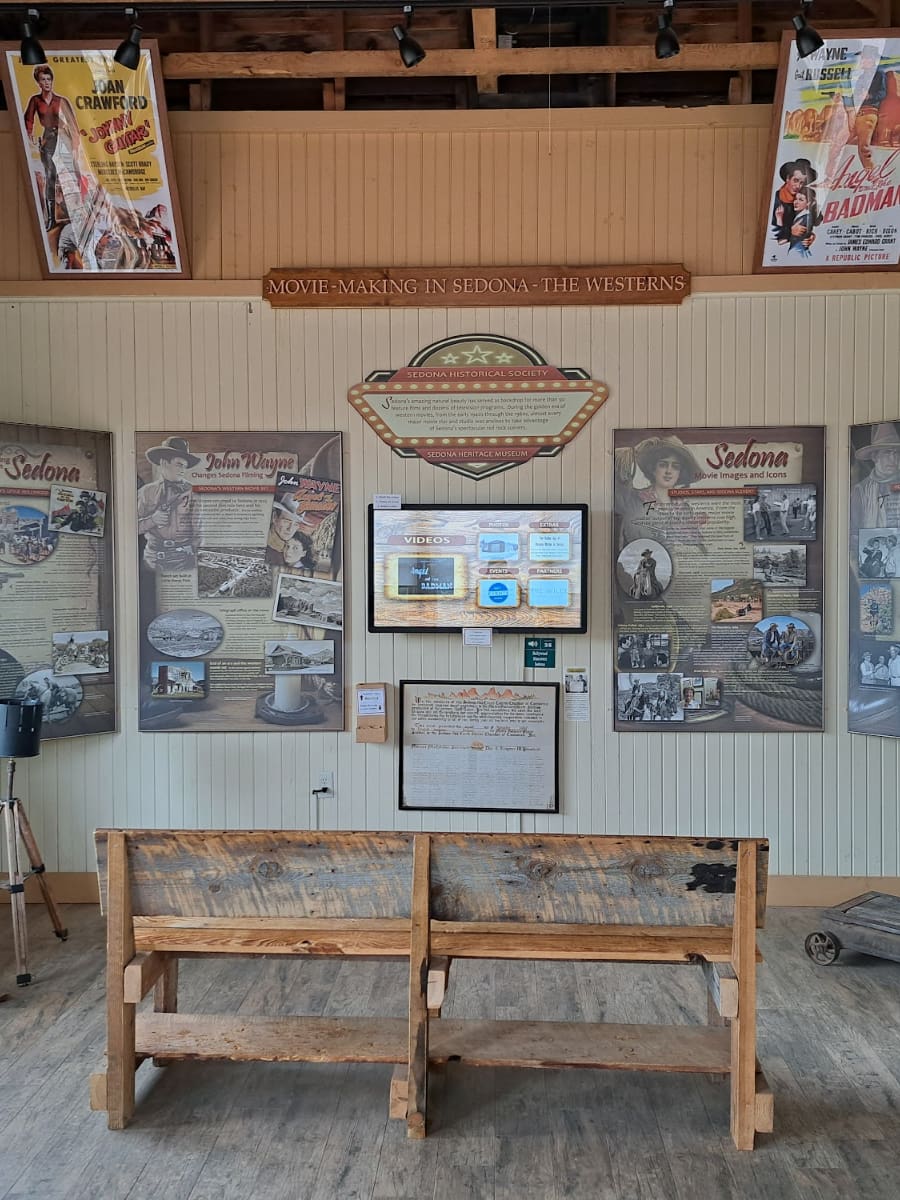
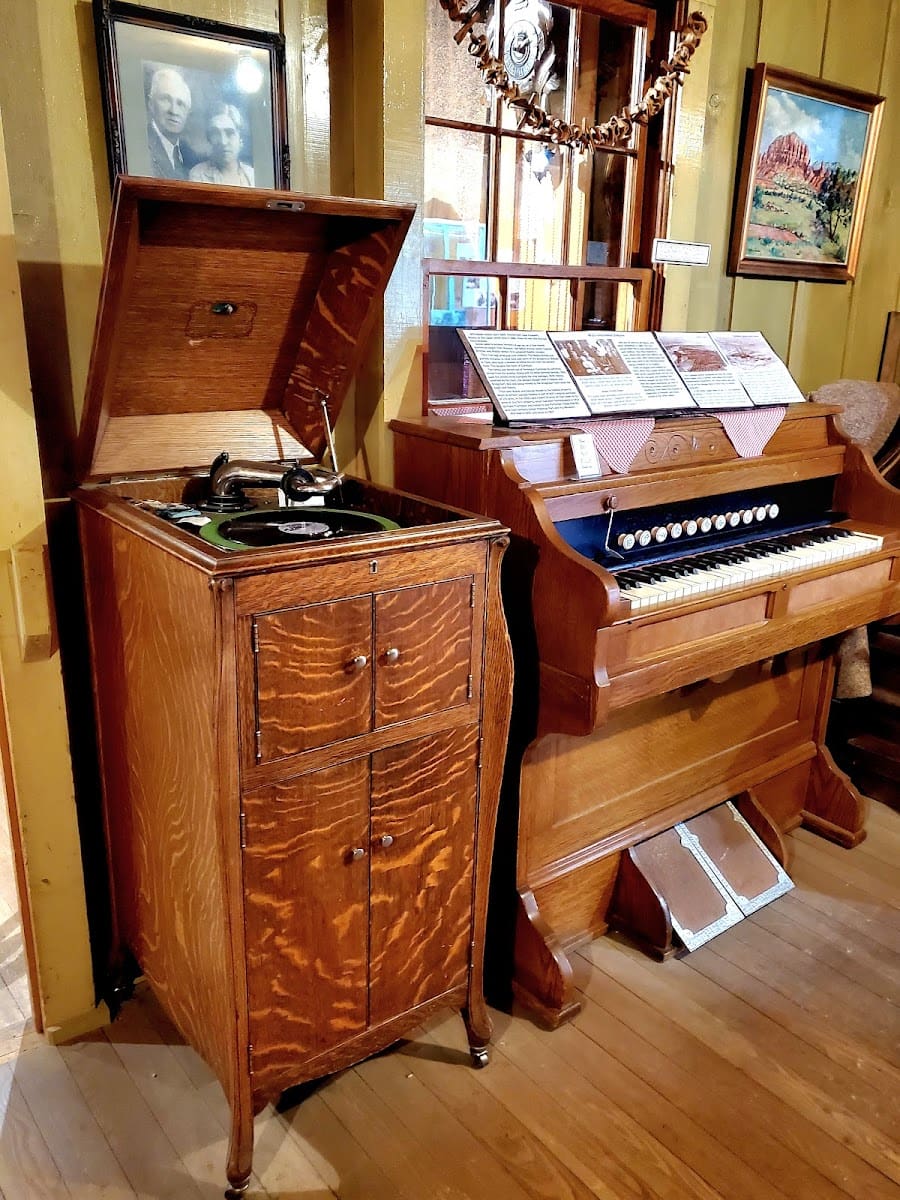
Kid-friendly exhibits. What made this museum work for my family was the hands-on nature of many displays. My children got to operate an old-fashioned telephone switchboard, try on pioneer clothing, and grind corn using traditional methods. The docents were wonderful with kids, sharing age-appropriate stories about Sedona’s cowboy days and early film history when western movies were frequently shot among the red rocks.
Interactive activities for kids at the museum:
- Telegraph and switchboard demonstrations
- Vintage clothing try-on station
- Apple sorting and packing simulation
- Old-fashioned toys and games
- Scavenger hunt with small prizes
Movie history. The exhibit on Sedona’s Hollywood connection was particularly interesting, showcasing how the area’s distinctive landscape served as the backdrop for over 100 westerns featuring stars like John Wayne and Jimmy Stewart. My movie-loving son enjoyed seeing clips from these films alongside photos showing how the same locations look today.
3. Sedona Wildlife Park
Animal encounters. Out of Africa Wildlife Park, located 30 minutes from Sedona in Camp Verde, offers close-up experiences with exotic animals that thrilled my entire family. Unlike traditional zoos, this 104-acre park focuses on interaction-we watched tigers splashing in their pool, fed giraffes by hand, and even saw the “Tiger Splash” show where big cats playfully chase toys into a pool.
Signature experiences. The highlight for my kids was the included Safari Tour, where we boarded an open-air vehicle that drove through habitats containing zebras, wildebeests, and ostriches. Some animals came right up to the vehicle, creating magical moments of connection. The predator feeding tour (additional $20) let us watch lions, tigers, and bears enjoying their meals while staff explained their natural behaviors.
Park highlights for families include:
- Tiger Splash Show (big cats playing in water)
- Predator Feed Tour (watching carnivores eat)
- Giant Snake Show (handling opportunities)
- Wildlife Safari Tour (open-air vehicle through habitats)
- Giraffe feeding platform (feed lettuce to giraffes)
Planning your visit. The park is open daily 9:30 AM to 5:00 PM, with shows scheduled throughout the day. Admission is $39.95 for adults, $27.95 for children 3-12, with discounts available online. I recommend arriving at opening to enjoy cooler temperatures and more active animals. The park is quite large, so wear comfortable shoes and be prepared for considerable walking.
Family tips. Pack water bottles (refill stations available), sunscreen, and hats as much of the park is exposed to the sun. The café offers basic lunch options, but bringing your own picnic is also permitted in designated areas. For an extra-special experience, book the “Feed the Animals” adventure ($99) where kids can help prepare and deliver food to various species-my daughter still talks about giving watermelon to the hyenas!
⭐ Best Activities
- Out of Africa Wildlife Park Admission – Experience close encounters with exotic animals at this unique wildlife park near Sedona, featuring safari tours, tiger splashing shows, and unforgettable animal interactions in a natural habitat setting just a short drive from town.
4. Family-Friendly Hiking Trails
Easy adventures. Sedona offers several gentle trails perfect for introducing children to the joy of hiking among the red rocks. Bell Rock Pathway became our family favorite with its relatively flat terrain and stunning views that kept my kids engaged without exhausting their little legs. The well-marked 1.5-mile loop allowed us to turn back whenever energy levels started flagging.

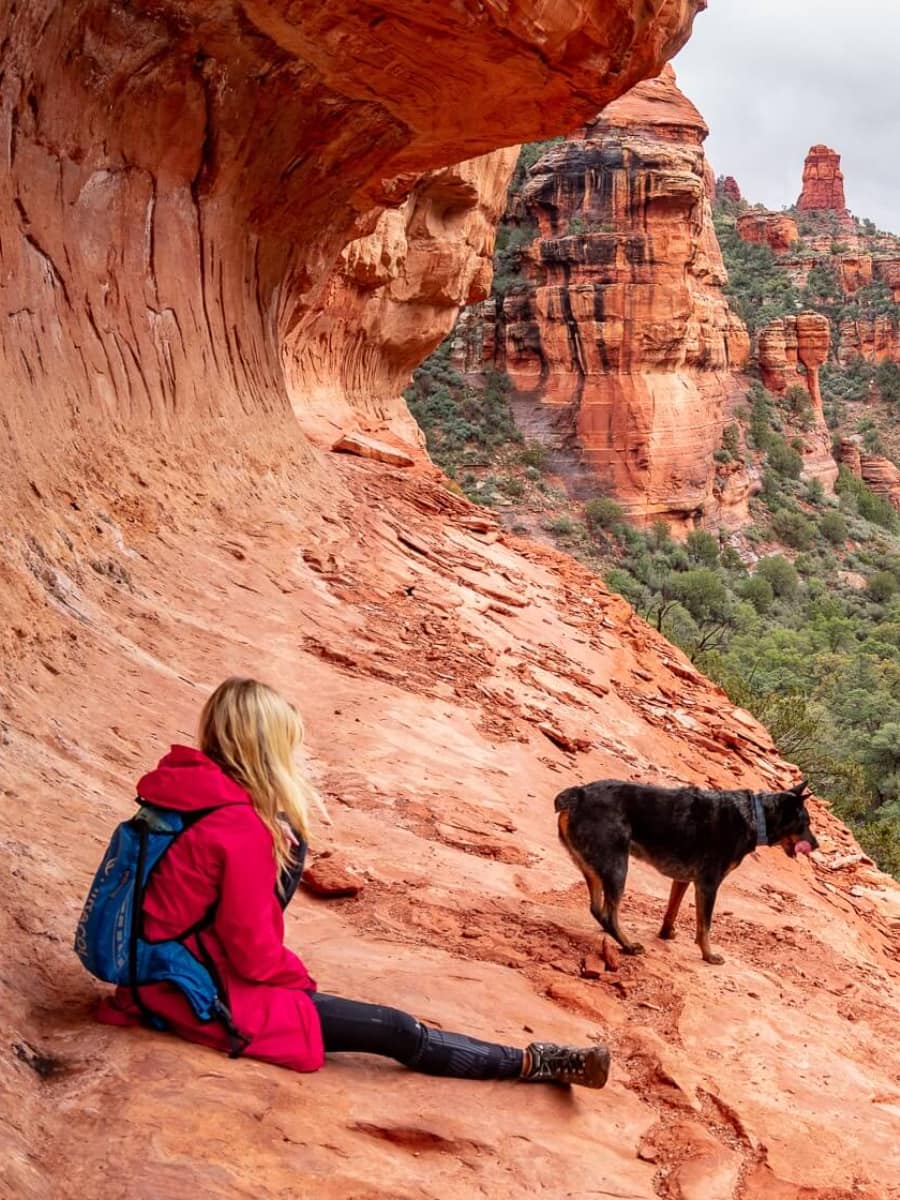
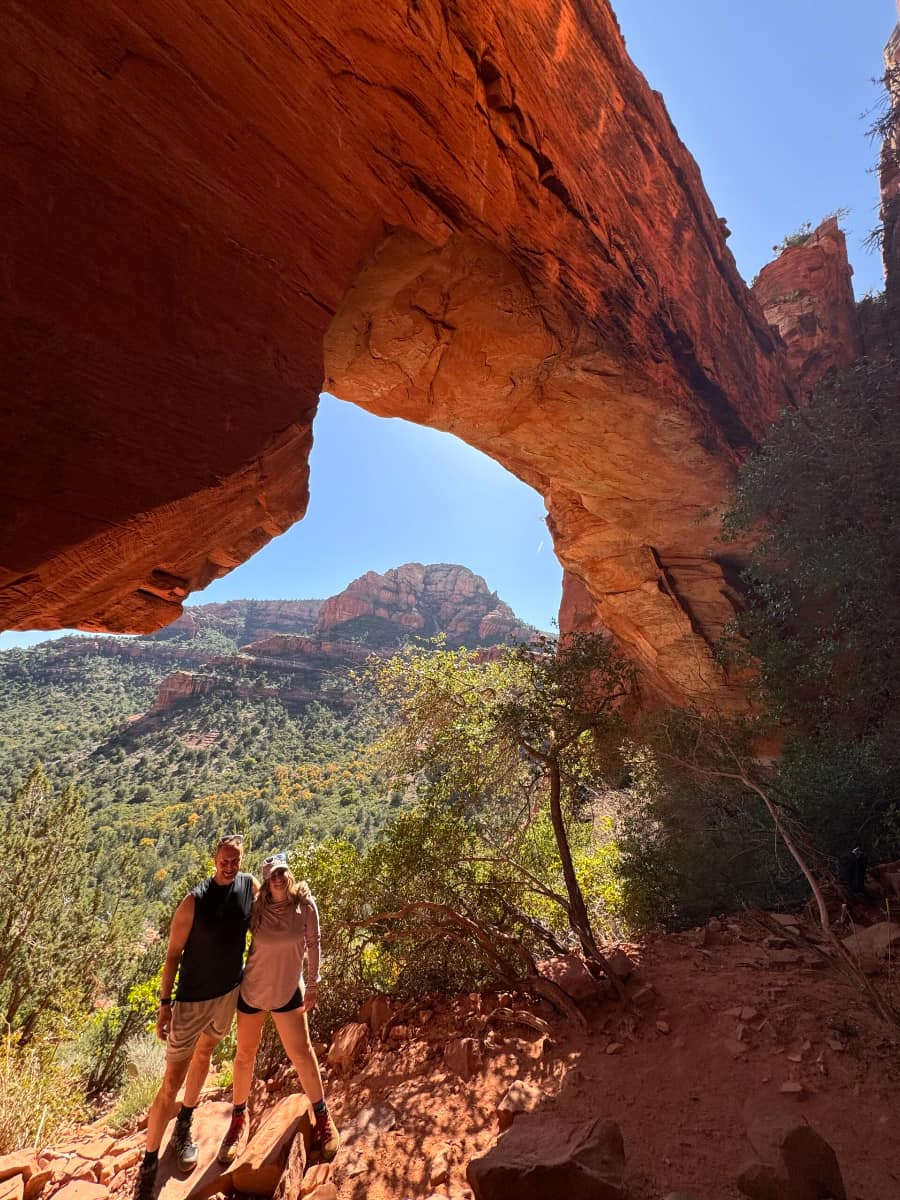
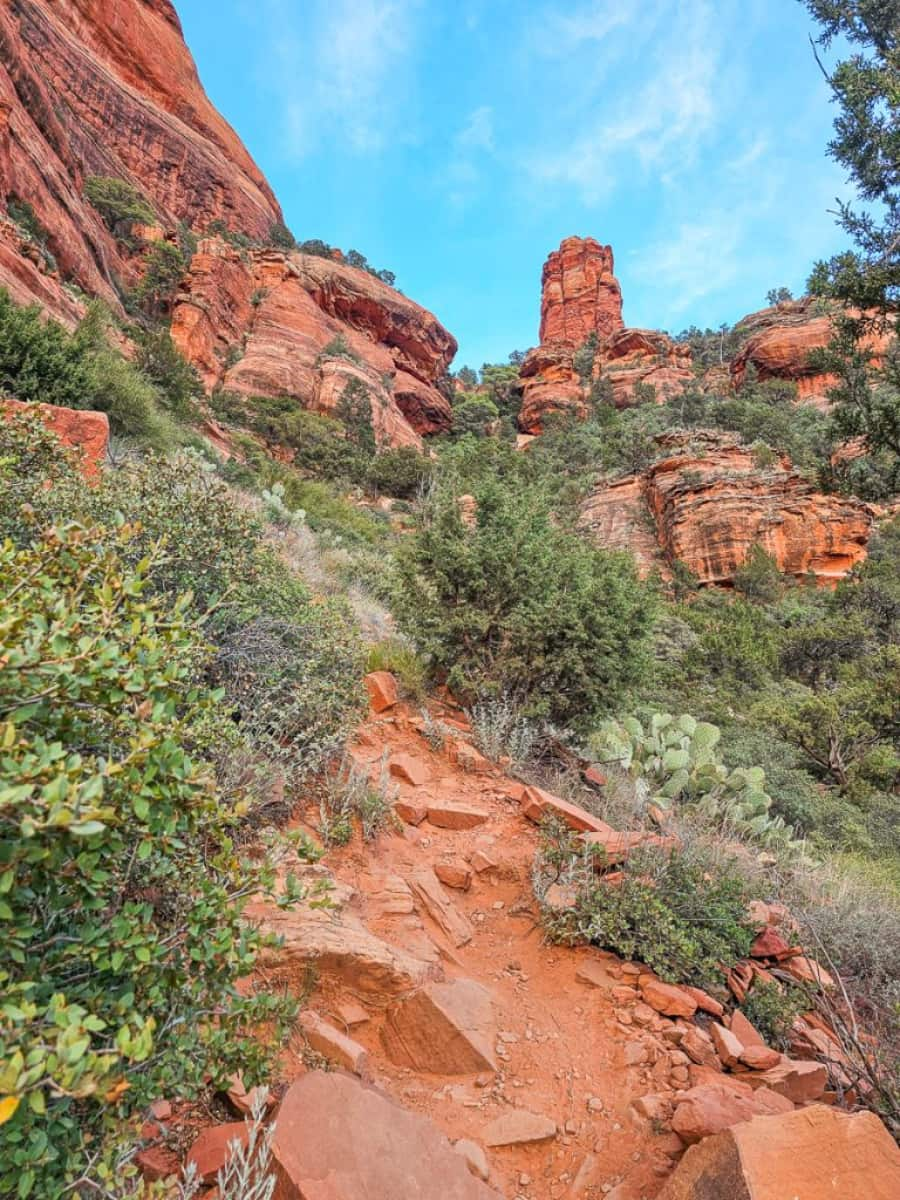
Natural playgrounds. What makes Sedona trails special for families is how they inspire natural play and exploration. At Fay Canyon, my children scrambled over smooth boulders and discovered small caves, while the West Fork Trail offered creek crossings on stepping stones that became an exciting challenge they were determined to master without getting wet feet.
Best family-friendly trails in Sedona:
- Bell Rock Pathway (1.5-mile loop, minimal elevation)
- Fay Canyon (1.2-mile flat trail with rock features)
- West Fork Trail (3 miles one-way with creek crossings)
- Courthouse Vista Loop (1-mile easy loop)
Hiking with kids tips. I learned to adjust expectations and focus on the journey rather than reaching a specific destination. We played “I Spy” with desert plants and wildlife, brought magnifying glasses for examining interesting rocks and insects, and created a scavenger hunt list of things to spot (lizard, cactus flower, heart-shaped rock, etc.) that kept enthusiasm high throughout our hikes.
5. Sedona Train Rides (Verde Canyon Railroad)
Scenic journey. The Verde Canyon Railroad, located 25 minutes from Sedona in Clarkdale, offers a four-hour rail adventure that captivated my entire family. Boarding the vintage train cars felt like stepping back in time, and as we pulled away from the station, my children pressed their faces against the windows, excited to spot eagles, hawks, and even the occasional deer along the route.
Train experience. What makes this ride special is the combination of comfort and wilderness access. The climate-controlled indoor seating provides respite from the heat, while the open-air viewing cars let us feel the breeze and take unobstructed photos of the stunning canyon scenery. The train travels at a leisurely 12 mph, perfect for spotting wildlife and ancient cliff dwellings that are inaccessible by road.
What to expect on the Verde Canyon Railroad:
- 4-hour round trip (20 miles each way)
- Indoor seating plus open-air viewing cars
- Narration about history, geology, and wildlife
- Snack bar and complimentary appetizers (first-class)
- Gift shop at the depot
Kid-friendly features. The railroad offers a “Junior Engineer” program where children receive a bandana, activity book, and special railroad knowledge from the conductors who were wonderfully patient with my curious kids’ endless questions. During certain seasons, they run special events like the Magical Christmas Journey (November-December) with Santa visits and holiday lights.
Free Things to Do in Sedona
1. Hiking Bell Rock Trail
Accessible adventure. Bell Rock Trail offers one of Sedona’s most rewarding hikes that won’t cost you a penny beyond the parking fee. I discovered that this bell-shaped formation has several interconnected pathways circling its base, allowing visitors of all fitness levels to enjoy stunning panoramic views without a strenuous climb.
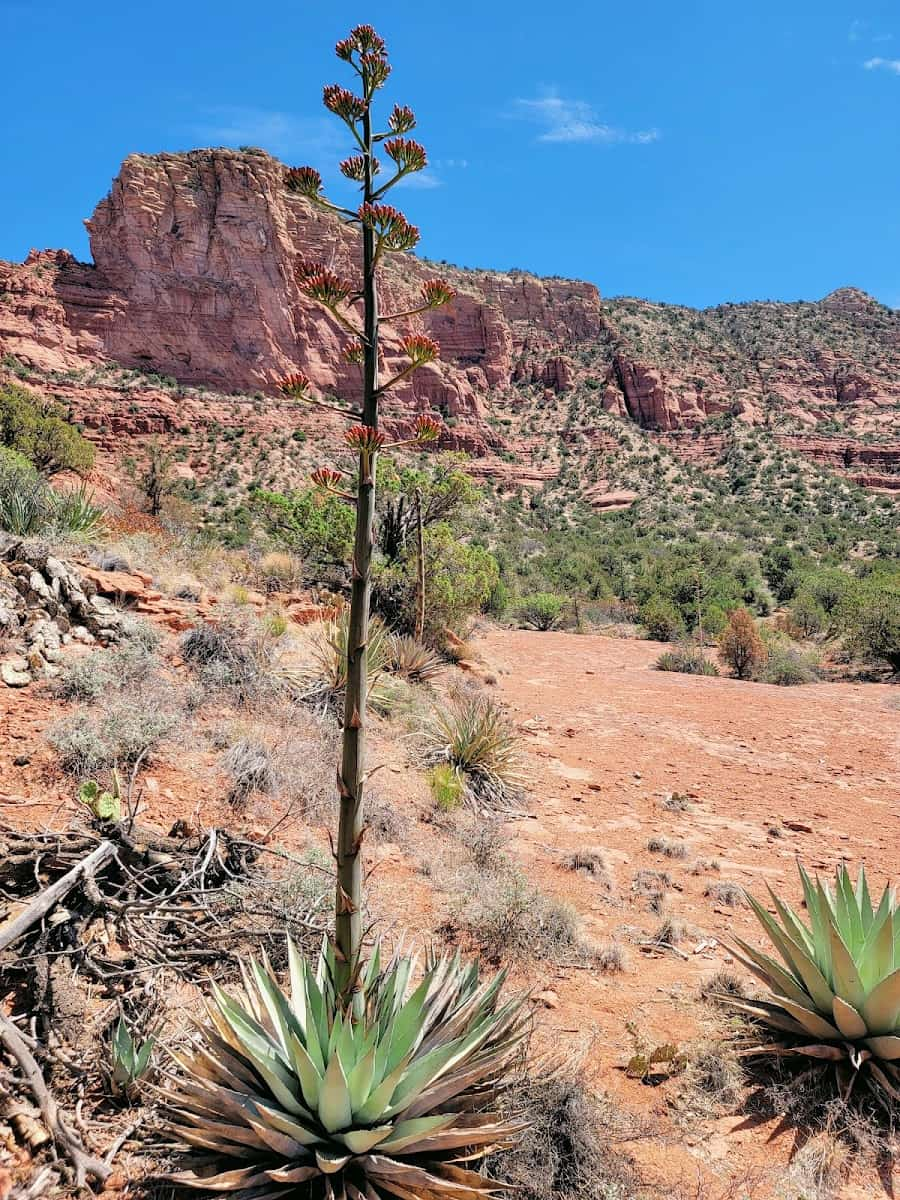
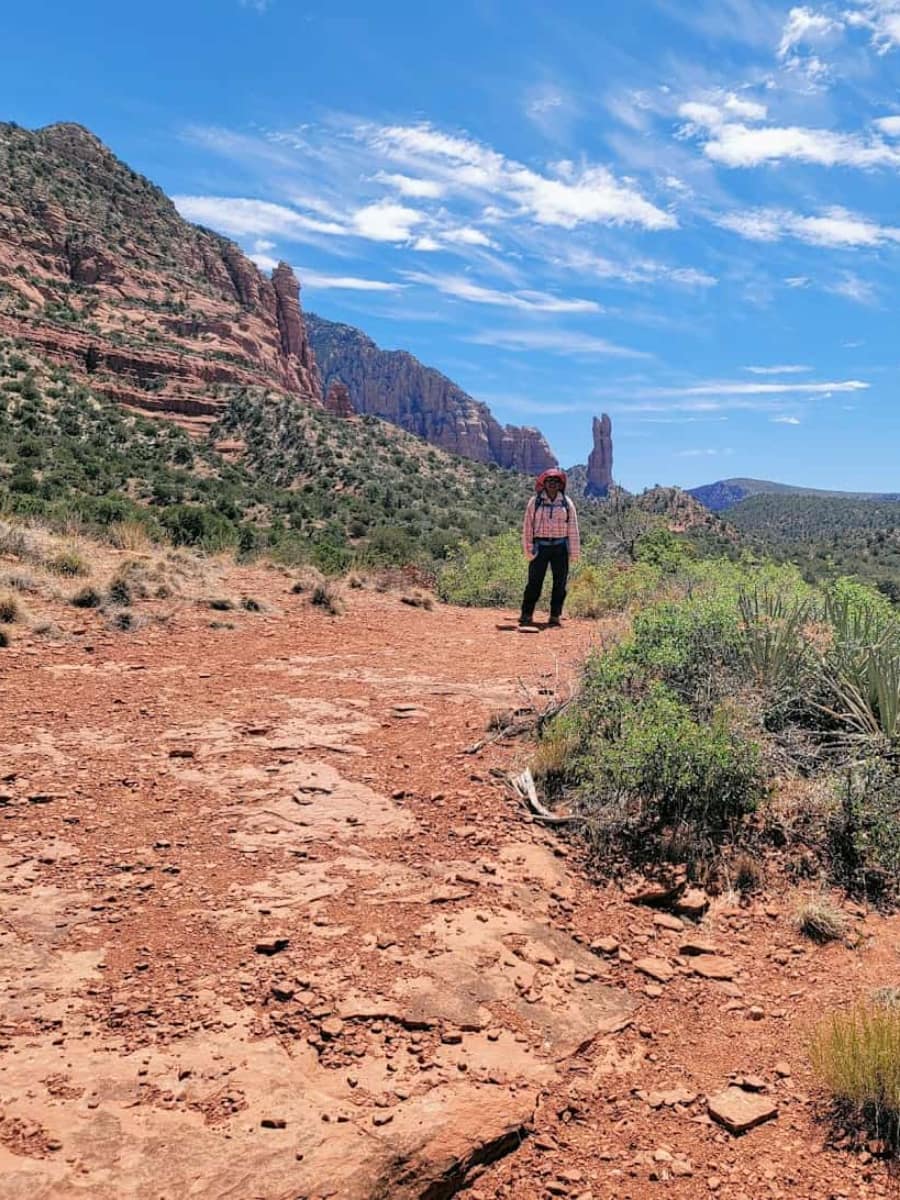
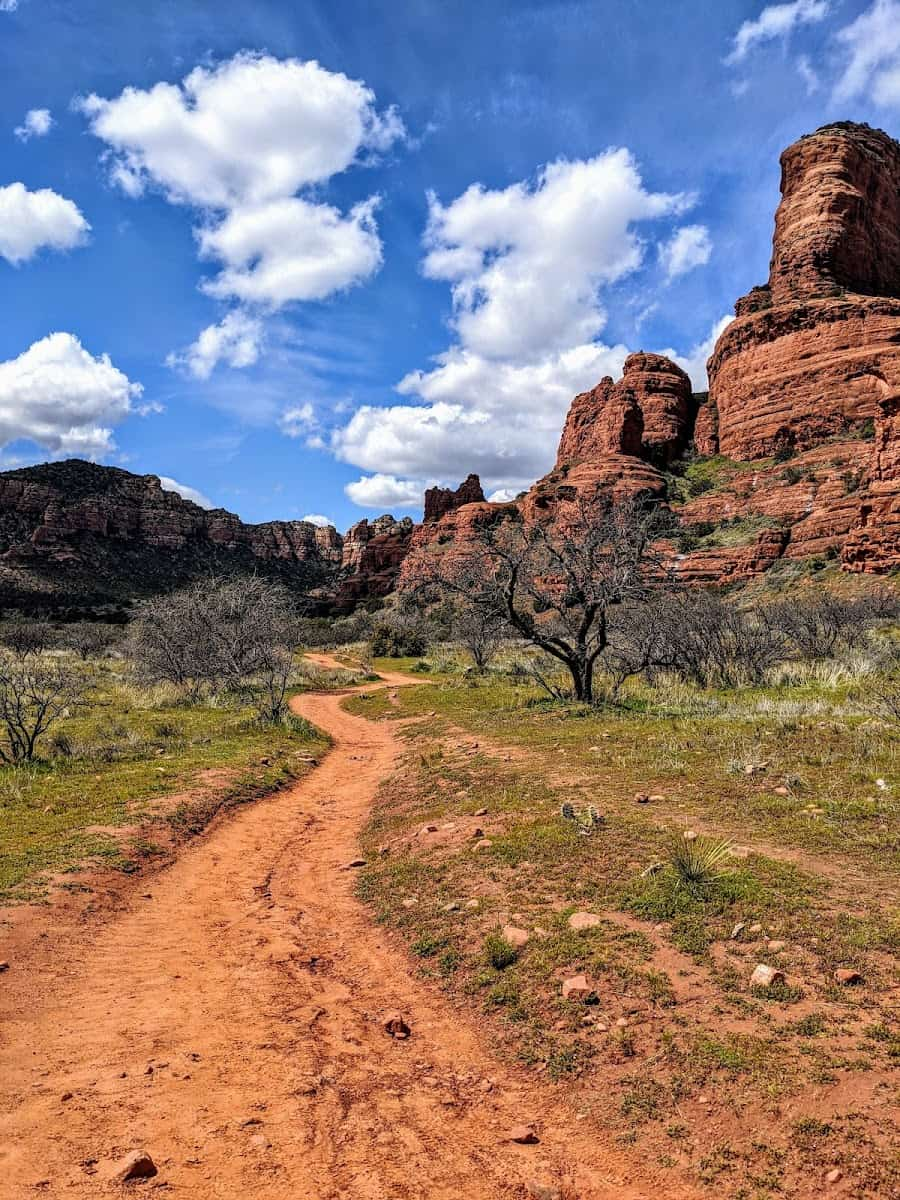
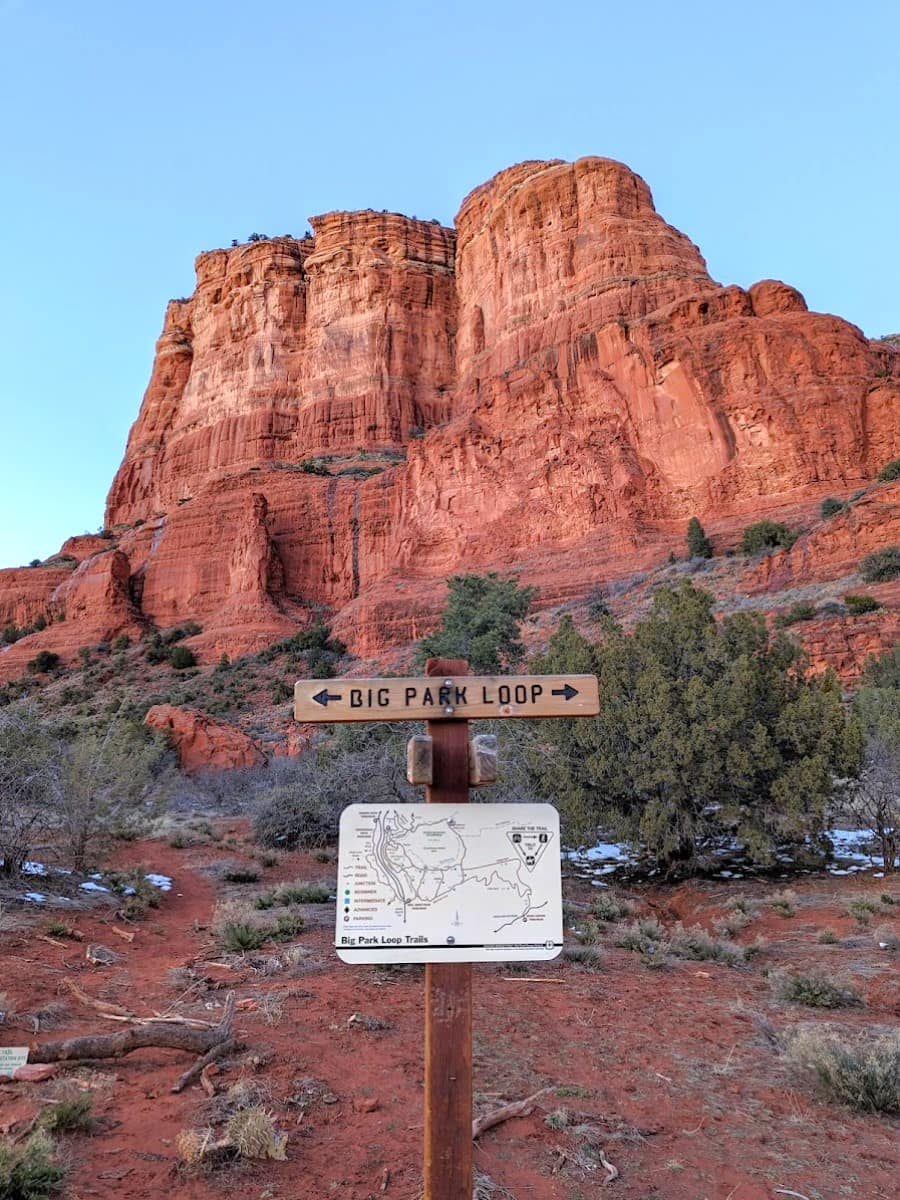
The Bell Rock Trail system includes:
- Bell Rock Pathway (easy, 3.6 miles round trip)
- Bell Rock Climb (moderate, varies with how high you go)
- Courthouse Butte Loop (moderate, 4.2 miles)
- Bell Rock-Courthouse Butte Vista (easy, 1 mile)
Vortex energy. Bell Rock is famous as one of Sedona’s main energy vortexes, and even as a skeptic, I felt something special while hiking here. Many visitors bring yoga mats to meditate on the flat areas of slickrock, and I noticed several people sitting quietly with their hands outstretched, apparently feeling the area’s reputed energy currents.
Trail access. You’ll find two main parking areas along Highway 179: the Bell Rock Vista (smaller) and the Courthouse Vista (larger). While technically you need a $5 Red Rock Pass, I discovered that America the Beautiful passes are also accepted-just display yours on your dashboard. The trail is well-marked with cairns (rock piles) guiding the way across sections of bare slickrock.
Photography tips. For the best lighting conditions, I recommend hiking in the early morning when the rising sun illuminates the eastern face of Bell Rock with a warm glow. The trail is mostly exposed, so bring plenty of water and sun protection even in cooler months-I was surprised how quickly I got thirsty in the dry desert air despite comfortable temperatures.
2. Exploring Uptown Sedona
Shopping district. Uptown Sedona is the bustling heart of town where you can soak in the vibrant atmosphere without spending a dime. I spent a delightful morning wandering along the main drag, admiring the stunning red rock views that frame the street while window shopping at everything from high-end art galleries to quirky souvenir shops selling crystals and vortex-themed merchandise.
Street performers. What makes Uptown special is the lively street scene, with local musicians often playing Native American flutes or acoustic guitars on corner spots. I was mesmerized by a talented artist creating intricate sand paintings right on the sidewalk, demonstrating traditional techniques that have been passed down through generations.
Must-see spots:
- Sedona Arts Center (exhibitions often free)
- Sedona Visitor Center (free maps and advice)
- Uptown crystal shops (fascinating displays)
- Public art installations and sculptures
- Scenic viewpoints between buildings
Local treats. While exploring doesn’t cost anything, I did splurge on a prickly pear ice cream cone ($5) that provided a refreshing taste of the desert. Many shops offer free samples of local specialties like prickly pear candy, spicy southwestern sauces, and local honey that give you a taste of Sedona’s flavors without opening your wallet.
Parking hack. Uptown parking can be challenging and expensive ($20+ at some lots), but I discovered free parking at the Sedona Heritage Museum just a few blocks away. From there, it’s an easy 10-minute walk into the heart of Uptown, with beautiful views of Thunder Mountain along the way that many tourists miss by driving directly to the main drag.
3. Airport Mesa Sunset Viewpoint
Panoramic vistas. Airport Mesa offers one of Sedona’s most accessible and spectacular viewpoints completely free of charge. I arrived about an hour before sunset and was rewarded with a breathtaking 360-degree panorama of Sedona’s most famous formations-Cathedral Rock, Bell Rock, and Courthouse Butte-all bathed in the golden light that gives Red Rock Country its magical glow.
Vortex energy. This location is known as one of Sedona’s strongest vortex sites, where the earth’s energy is said to spiral upward, creating a sense of rejuvenation and inspiration. I noticed several people meditating on the rocks, and while I can’t confirm the metaphysical aspects, the profound sense of peace I felt watching the sunset here was undeniable.

What to expect at Airport Mesa:
- 360-degree views of Sedona’s red rock formations
- Spiral juniper trees (said to be shaped by vortex energy)
- Flat rocks perfect for sitting and contemplation
- Dramatic lighting changes as sun sets
- Possible wildlife sightings (ravens, hawks)
Practical details. Located just off Airport Road, the main viewpoint has a small parking area that fills quickly before sunset. I arrived 60-90 minutes before sundown to secure a spot, but if it’s full, you can park along the road and walk a short distance. No facilities are available, so bring water and dress in layers as temperatures drop quickly after sunset.
Photography tips. The changing light creates a natural time-lapse effect as the rocks shift from bright orange to deep crimson before fading to purple in twilight. I found that my smartphone captured the colors surprisingly well, though a wide-angle lens would help capture the expansive views. Stay about 15-20 minutes after the sun disappears for the best “blue hour” photography when the sky turns deep blue against the silhouetted rocks.
4. Visiting Amitabha Stupa & Peace Park
Sacred monument. The Amitabha Stupa and Peace Park offers a tranquil spiritual experience that costs nothing to visit. I was immediately struck by the 36-foot tall Buddhist stupa (sacred monument) rising dramatically against the backdrop of Thunder Mountain, creating a powerful contrast between the white structure and the red rocks beyond.
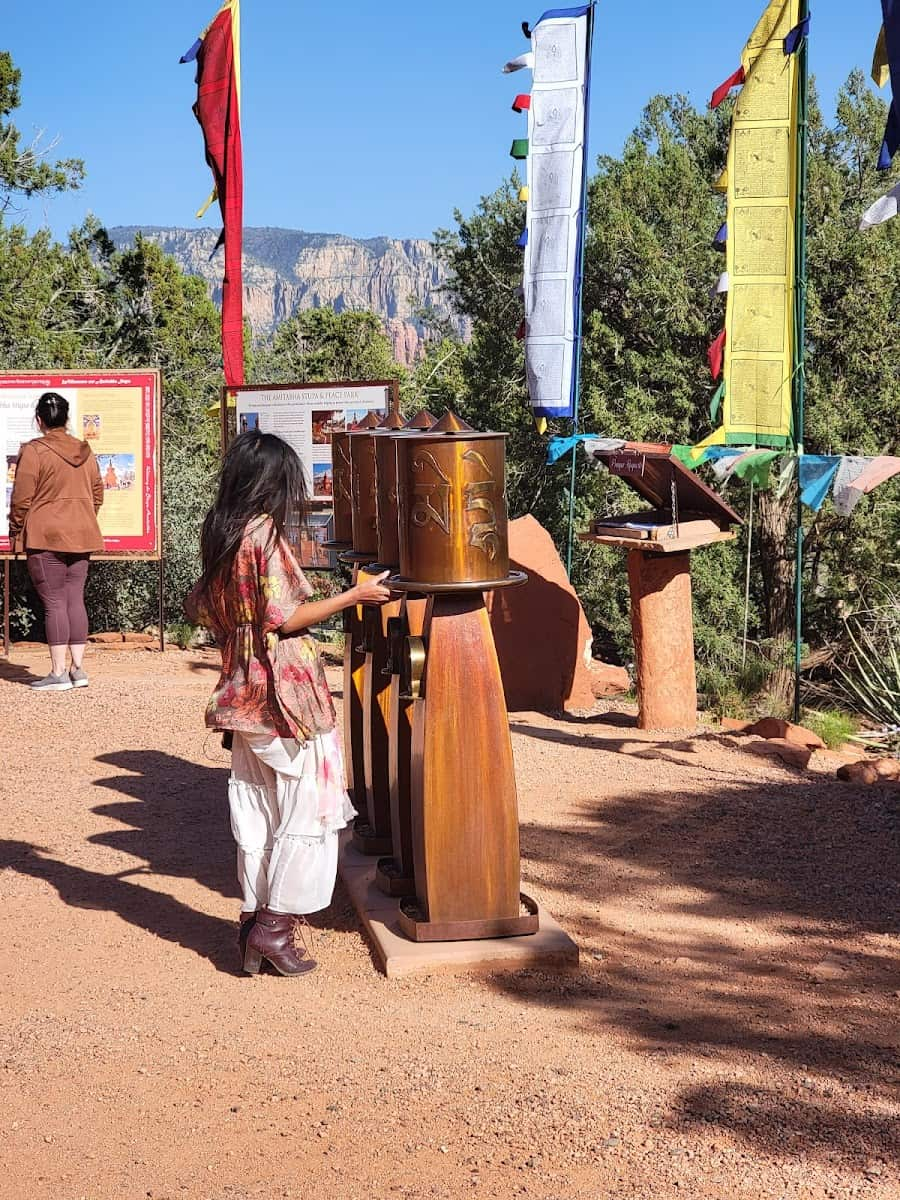
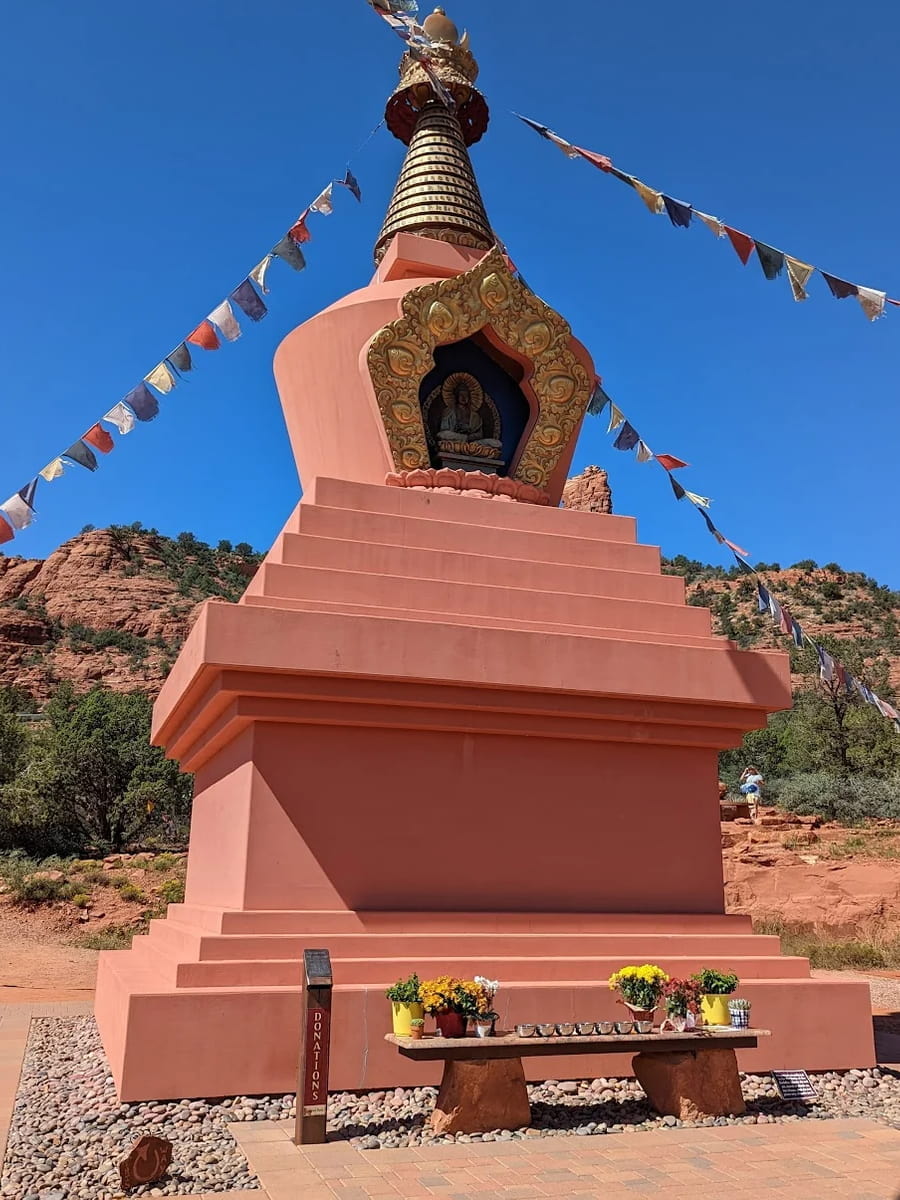
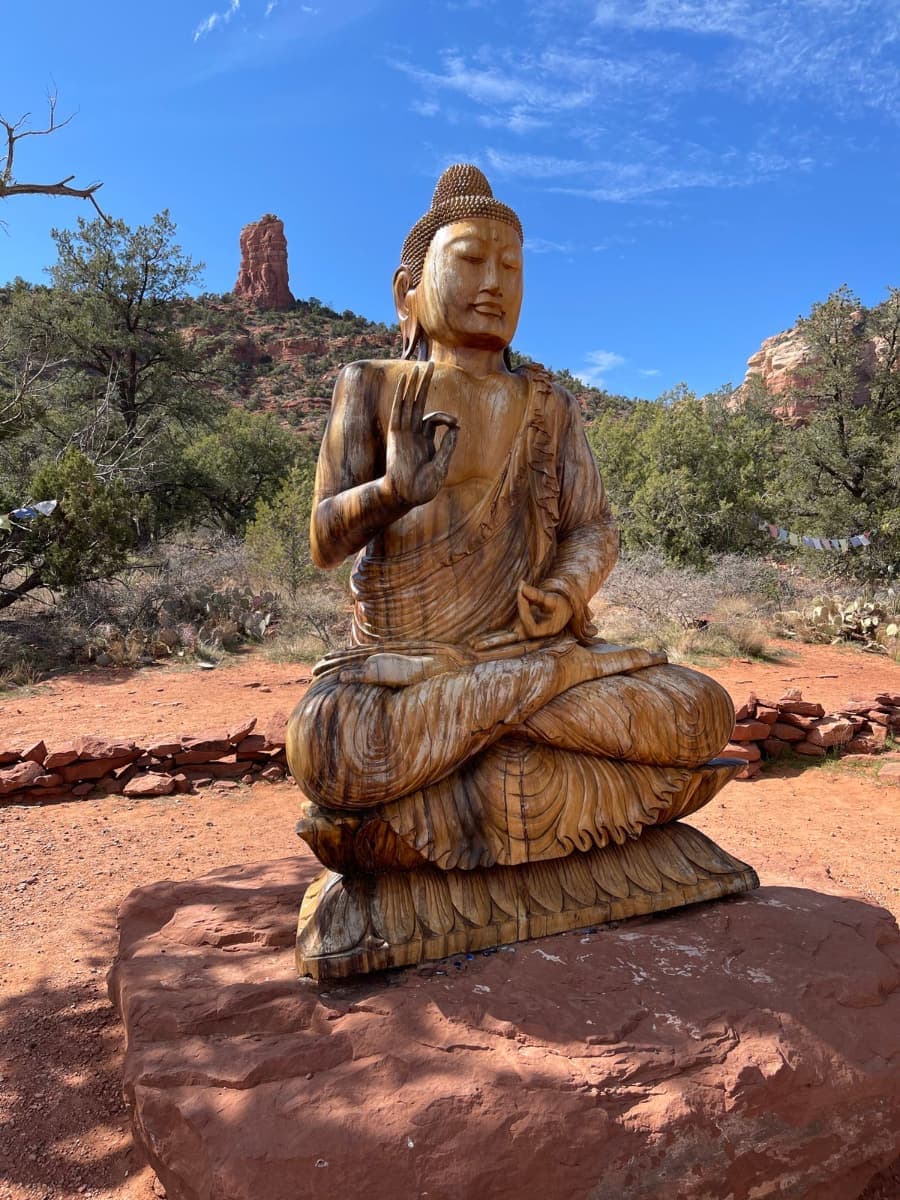
Spiritual practice. Walking clockwise around the stupa three times is the traditional practice, which I found surprisingly meditative. Many visitors leave small offerings-flowers, stones, or written prayers-while others sit quietly on the provided benches in contemplation. Despite being raised in a different faith tradition, I felt a profound sense of peace that transcended any specific religion.
What to know before visiting:
- Open daily from dawn to dusk
- No entrance fee (donations appreciated)
- Proper etiquette includes walking clockwise around stupas
- Quiet voices maintain the peaceful atmosphere
- Photography is permitted but be respectful of those praying
Natural setting. Beyond the main stupa, I discovered a network of short trails winding through juniper and pinyon pine trees, with smaller monuments and prayer flags adding splashes of color to the landscape. The 14-acre grounds offer several quiet meditation spots with stunning views of Coffee Pot Rock and other formations.
5. Window Shopping at Tlaquepaque
Architectural beauty. Tlaquepaque Arts & Shopping Village is a feast for the eyes that costs nothing to explore. I spent a delightful morning wandering through this meticulously designed Spanish Colonial-style village with its cobblestone walkways, arched doorways, and flowering courtyards that transport you to another time and place.
Artistic displays. The village houses over 50 shops and galleries, and while purchasing the artwork might be pricey, admiring it is absolutely free. I was mesmerized by the gallery windows displaying everything from massive bronze sculptures and landscape paintings to intricate jewelry and blown glass creations that capture the colors of the surrounding red rocks.
Highlights of window shopping at Tlaquepaque:
- Architectural details (hand-carved doors, iron work)
- Courtyard fountains and sculptures
- Gallery window displays
- Seasonal decorations (especially beautiful at Christmas)
- Public art installations throughout the village
Cultural atmosphere. What makes Tlaquepaque special is the immersive experience-the sound of fountains, the scent of flowering vines, and often the music of strolling mariachi players or flautists that create a multi-sensory experience. I timed my visit to coincide with one of their free cultural events, watching traditional Mexican folk dancers perform in the central courtyard.
Insider tips. Located at 336 State Route 179, Tlaquepaque has free parking but can get crowded midday. I recommend visiting early morning (shops open at 10 AM) or later afternoon when you can enjoy the beautiful lighting on the adobe walls. The village is especially magical during holiday seasons when twinkling lights and decorations transform the space-December evenings feature the beautiful Luminaria Festival with thousands of candles lighting the walkways.
6. Red Rock Scenic Overlooks
Roadside wonders. Some of Sedona’s most spectacular views don’t require hiking boots or entrance fees-just a car and a camera. I discovered several stunning pullouts along Highway 179 (the Red Rock Scenic Byway) that offer frame-worthy vistas of Cathedral Rock, Bell Rock, and Courthouse Butte without a single step on a trail.

Photography opportunities. My favorite free overlook is Yavapai Vista Point, where a short paved path leads to a viewing area with expansive panoramas of several major formations. The elevated position provides a perfect perspective for capturing the scale and grandeur of Sedona’s landscape, especially in the golden hour before sunset when the rocks seem to glow from within.
Best free scenic overlooks around Sedona:
- Yavapai Vista Point (Highway 179)
- Bell Rock Vista (Highway 179)
- Midgley Bridge (Highway 89A)
- Schnebly Hill Vista (off Schnebly Hill Road)
- Airport Mesa Overlook (Airport Road)
Driving routes. The Red Rock Loop Road offered another series of free viewpoints, including a spectacular angle on Cathedral Rock reflected in Oak Creek at Red Rock Crossing viewing area. While the actual crossing requires a State Park fee, the viewing area just before it is free and provides nearly identical views.
Visitor experience. I found that having a car picnic at these overlooks was a perfect way to enjoy a meal with million-dollar views without restaurant prices. Most viewpoints have informational plaques identifying the formations and explaining the geology, turning a simple scenic stop into an educational experience. Early morning and late afternoon not only offer the best lighting but also fewer crowds-I had Schnebly Hill Vista completely to myself at 7 AM on a Tuesday.
7. Oak Creek Picnic
Creekside relaxation. One of my favorite free activities in Sedona was packing a simple picnic and spending a lazy afternoon beside the cool waters of Oak Creek. I discovered several public access points where you can spread a blanket on the banks and enjoy the soothing sounds of flowing water against a backdrop of towering red cliffs.
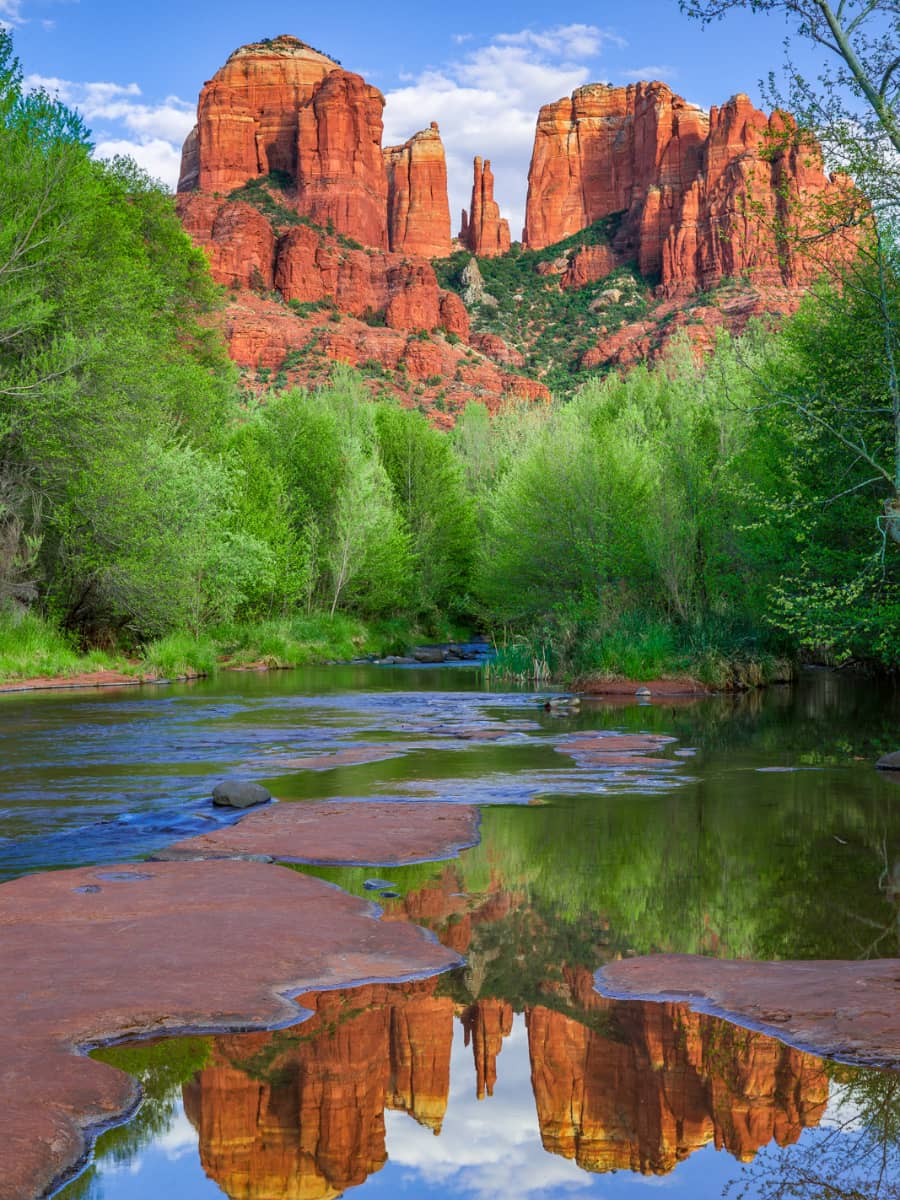
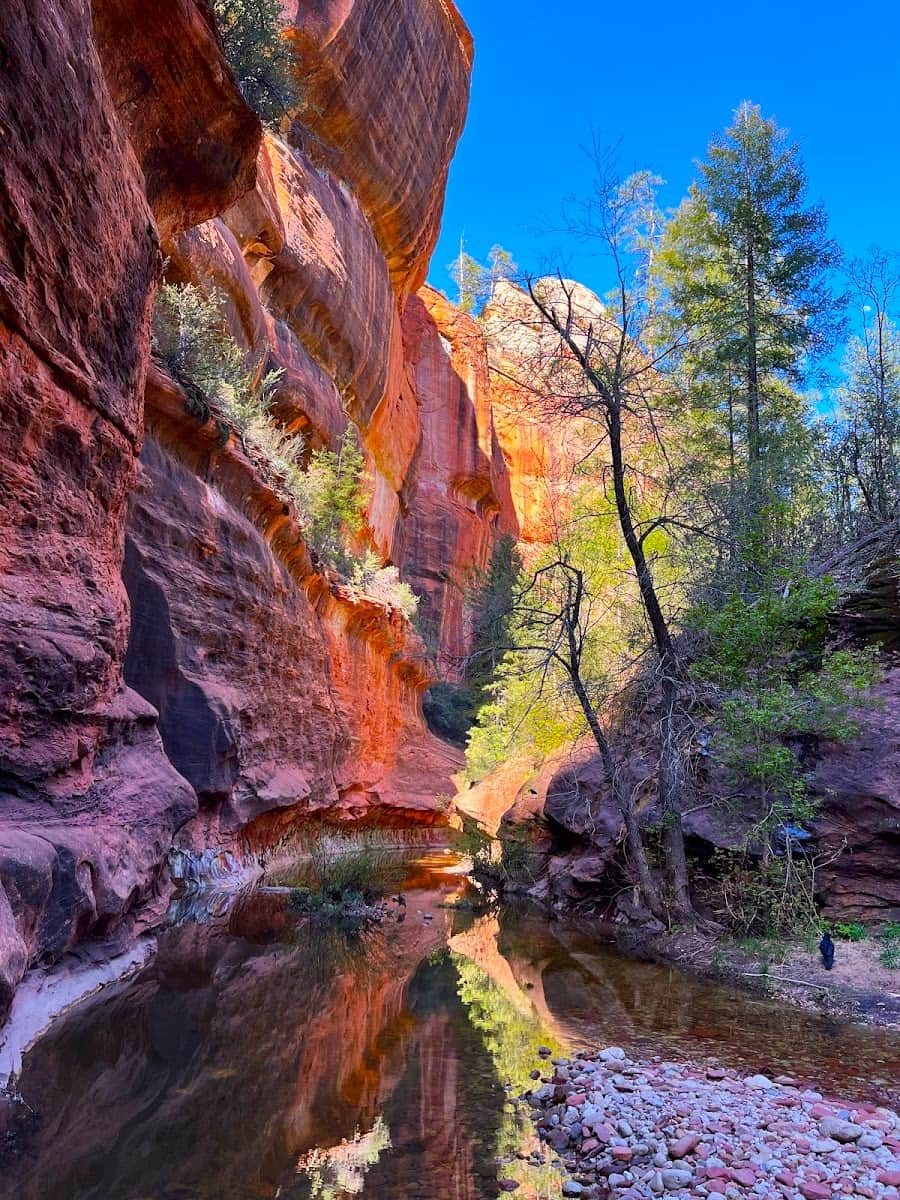

Natural swimming. I found free swimming holes along Oak Creek that were just as refreshing on a hot day. The creek access point at Grasshopper Point has a small parking fee ($9), but other spots like the Midgley Bridge area offer creek access with just a Red Rock Pass for parking.
Best free Oak Creek picnic spots:
- Crescent Moon Picnic Area (Red Rock Crossing)
- Midgley Bridge creek access
- Indian Gardens (along 89A)
- Bootlegger Day Use Area
Wildlife watching. Oak Creek creates a riparian habitat that attracts diverse wildlife absent from the drier surrounding areas. During my creekside picnic, I spotted herons stalking fish in the shallows, colorful butterflies flitting among wildflowers, and even a family of javelinas (wild peccaries) coming down to drink at dusk-nature’s entertainment that didn’t cost a penny.
Practical tips. Pack out all trash and respect private property boundaries, which are clearly marked along most creek access points. I found early weekday mornings or weekday evenings offered the most peaceful experience, while weekends can get crowded even at the free spots. Bring water shoes for exploring the creek, as the rocky bottom can be slippery and sometimes sharp.
8. Chapel of the Holy Cross (free entry)
Architectural marvel. The Chapel of the Holy Cross is not only one of Sedona’s most photographed landmarks but also completely free to visit. I was awestruck by how this modern chapel seems to grow organically from the red rocks, with its 90-foot cross and massive windows framing views that feel spiritually significant regardless of your religious background.
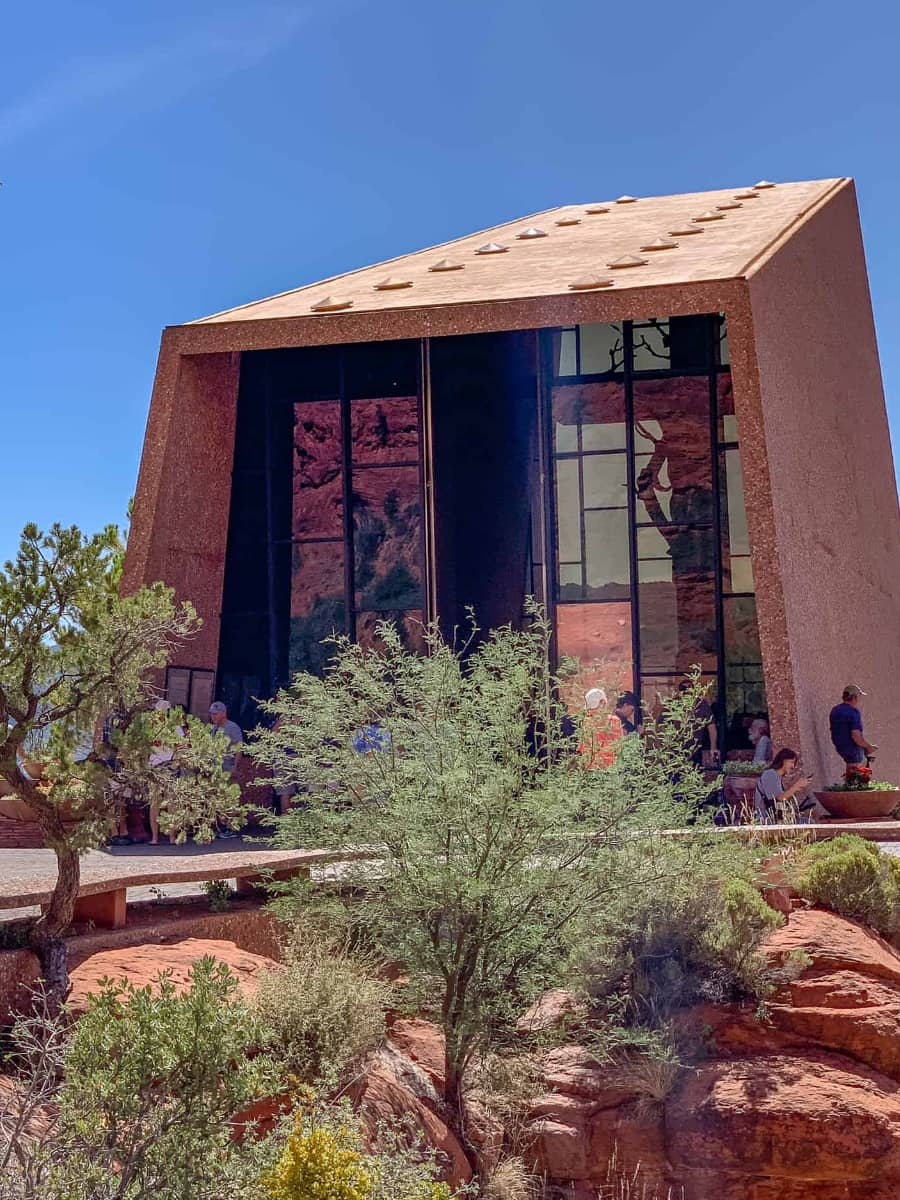
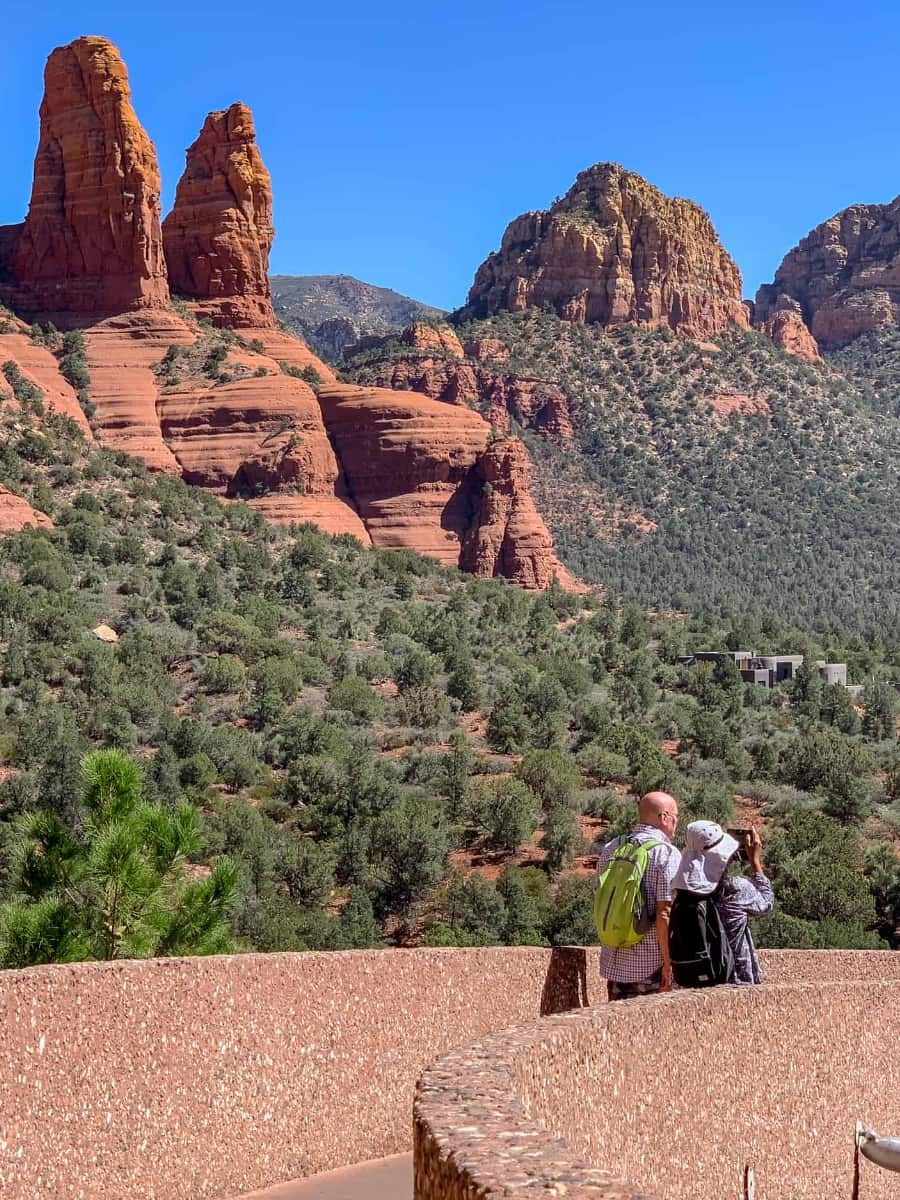
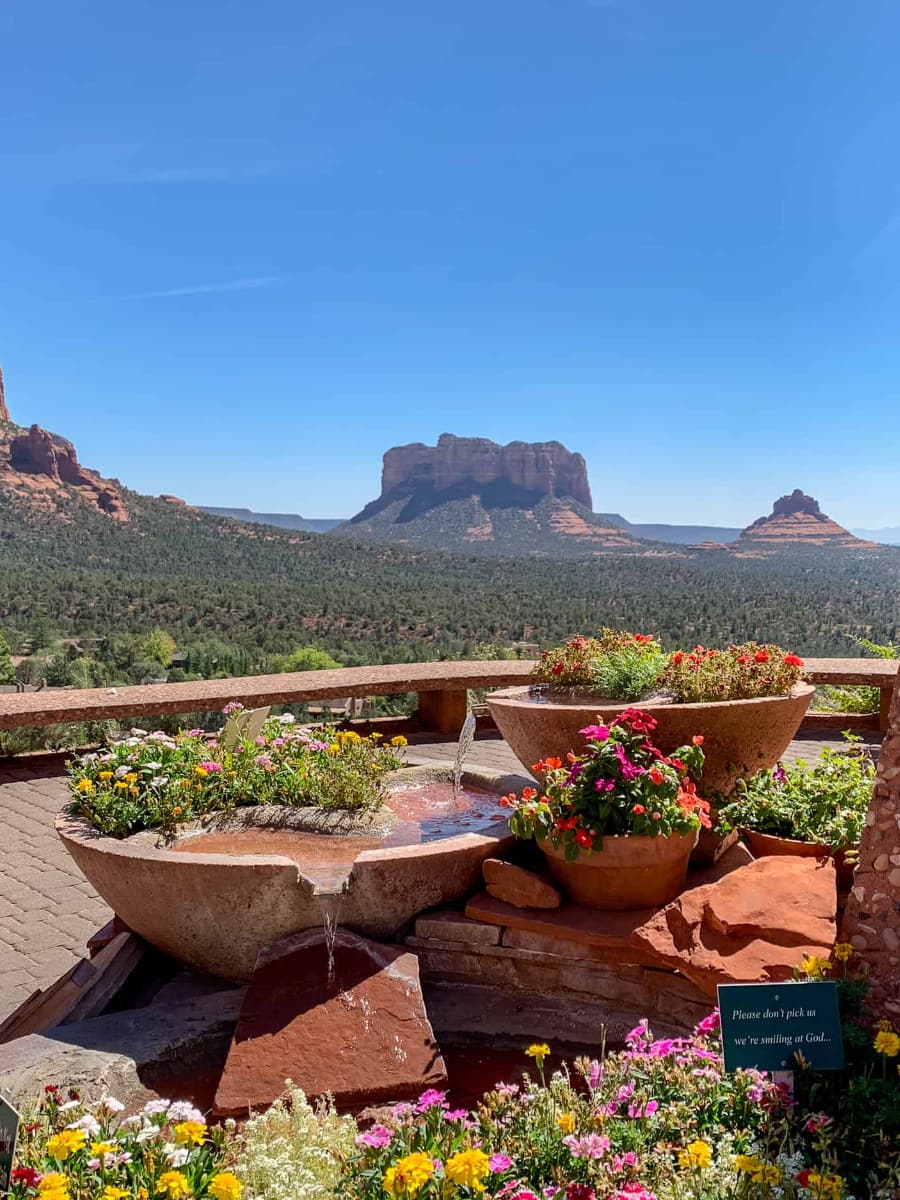
Interior experience. Inside, the chapel is surprisingly intimate, with simple wooden pews facing an altar backed by a wall of glass that frames the red rock landscape beyond. I spent about 20 minutes sitting quietly, watching the changing light play across the interior space and observing how the architecture directs your gaze both upward toward the heavens and outward to the natural beauty of creation.
What to expect when visiting the Chapel:
- Open daily 9 AM-5 PM
- No admission fee (donation box available)
- Limited parking (30 spaces)
- Short but steep walk from parking area
- Gift shop with religious items and souvenirs
Photography opportunities. While the chapel’s exterior against the red rocks makes for stunning photos, don’t miss shooting from inside looking out through the massive windows. I found that midmorning offered the best lighting, when the sun illuminated the red rocks visible through the glass but wasn’t directly shining into the chapel creating harsh contrasts.
9. Art Gallery Browsing
Cultural immersion. Sedona boasts over 80 art galleries, all free to browse, showcasing everything from traditional Southwestern paintings to contemporary sculpture and Native American crafts. I spent a rainy afternoon gallery-hopping in Tlaquepaque, enjoying world-class art without spending a dime on admission fees.
Artist interactions. What makes gallery browsing in Sedona special is the opportunity to meet working artists. At Exposures International, I watched a sculptor demonstrating his technique with clay, while at Sedona Arts Center, I chatted with a watercolorist capturing the unique light of the red rocks. These personal connections added depth to my appreciation of the artwork.
Free art experiences in Sedona:
- First Friday Art Walk (monthly evening event)
- Sedona Arts Center exhibitions
- Tlaquepaque gallery demonstrations
- Hillside Sedona art installations
Local perspectives. I found that gallery staff were happy to share information about the artists and techniques even when I made it clear I wasn’t buying. Many galleries display works depicting local landmarks, and I gained new perspectives on places I’d hiked by seeing how different artists interpreted the same formations through their unique artistic lenses.
Browsing strategy. With so many galleries, it can be overwhelming, so I focused on areas with high concentrations like Tlaquepaque and the Hillside Sedona complex. The Sedona Gallery Association publishes a free map available at the visitor center that groups galleries by location and style. For the most engaging experience, I recommend visiting during schedule
Seasonal Activities in Sedona
Christmas in Sedona
Festive transformation. Sedona takes on a magical quality during the holiday season, with the red rocks providing a dramatic backdrop for twinkling lights and seasonal decorations. I was charmed by Tlaquepaque’s transformation during the “Festival of Lights” (December 10), when thousands of luminarias (paper lanterns) line walkways and rooftops, creating a warm golden glow against the evening sky while carolers in Victorian costumes perform throughout the village.
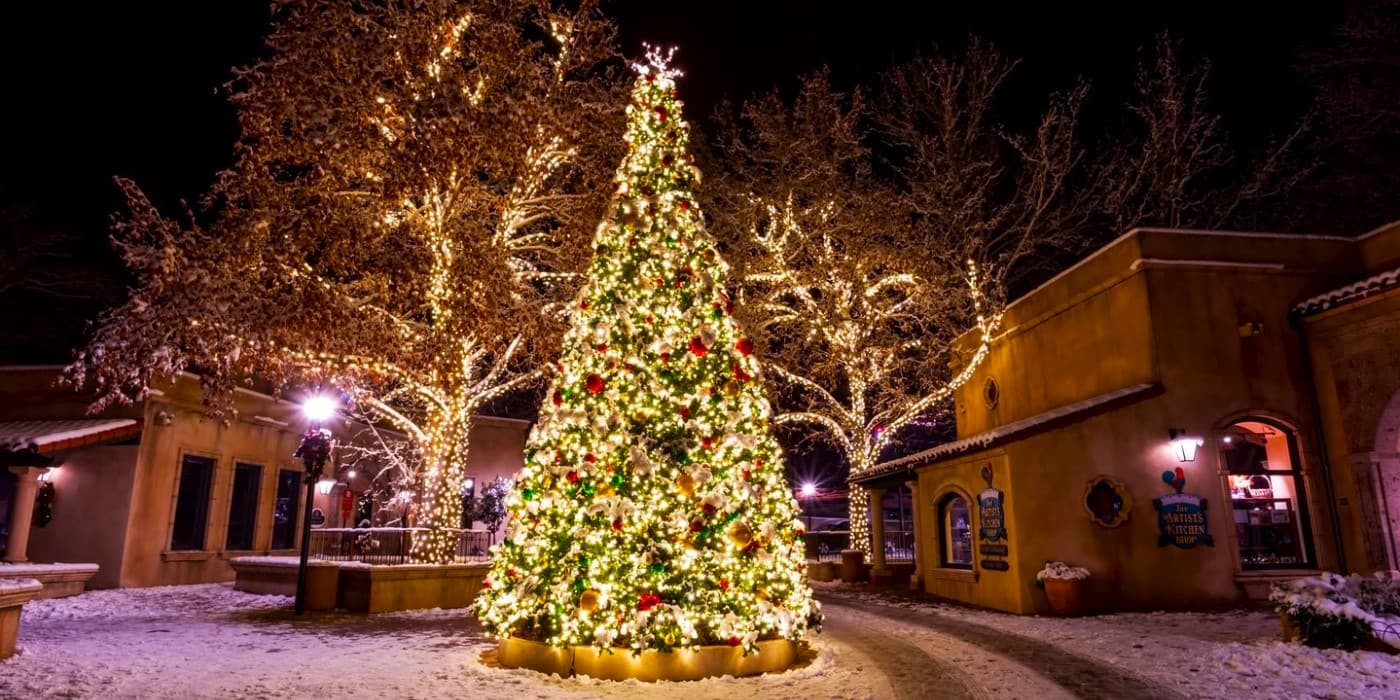
Holiday events. The “Red Rock Fantasy” light display at Los Abrigados Resort (December 1-30) features elaborate light sculptures created by local businesses and families competing for prizes. Though the resort is private, the display is visible from public areas and creates a festive atmosphere for evening strolls. The Chapel of the Holy Cross holds a special Christmas Eve service that combines traditional carols with the breathtaking setting for a truly memorable experience.
Sedona holiday activities include:
- Tlaquepaque Festival of Lights (December 10)
- Red Rock Fantasy light display (December 1-30)
- Santa visits at Tlaquepaque (weekends in December)
- Christmas Eve service at Chapel of the Holy Cross
- The Magical Christmas Journey with Verde Canyon Railroad
Shopping experience. Holiday shopping in Sedona offers a refreshing alternative to mall madness, with unique galleries and boutiques selling one-of-a-kind gifts. The annual Sedona Arts Center Holiday Gift Show (first weekend in December) features handcrafted items from local artists at various price points, perfect for finding something special that captures the spirit of Sedona.
Winter weather. December temperatures typically range from 30-60°F, with occasional light snow that rarely accumulates in town but creates stunning scenes of white dusting the red rocks. Pack layers for comfort throughout the day, and be prepared for early sunsets (around 5:15 PM) when planning activities. The cooler temperatures and holiday atmosphere make this an excellent time for hiking popular trails that would be too hot and crowded during summer months.
Summer Festivals and Events
Hummingbird celebration. The Sedona Hummingbird Festival (July 25-27) transformed my understanding of these fascinating creatures through expert presentations, garden tours, and banding demonstrations. I watched in amazement as dozens of hummingbirds buzzed around special feeding stations at the festival headquarters, sometimes hovering just inches from my face. The festival includes free activities at the Sedona Public Library alongside ticketed events at private gardens.
Artistic gatherings. The Sedona Summer Arts & Crafts Fair (Memorial Day weekend) fills Tlaquepaque with additional artist booths showcasing pottery, jewelry, painting, and sculpture. What makes this event special is the opportunity to meet creators and learn about their techniques while browsing unique handcrafted items in the beautiful setting of Tlaquepaque’s courtyards, with live music adding to the festive atmosphere.
Summer cultural events in Sedona:
- Sedona Hummingbird Festival (July 25-27)
- Summer Arts & Crafts Fair (Memorial Day weekend)
- Sedona Bluegrass Festival (early June)
- Red Rocks Music Festival (August/September)
- 4th of July Wet Fest at Posse Grounds Park
Outdoor concerts. The Sound Bites Grill Summer Concert Series (June-September) offers free performances on their patio overlooking Sedona’s red rocks, creating the perfect backdrop for enjoying local musicians. For a more formal experience, the Sedona Chamber Music Festival (August) brings classical performers to the Sedona Performing Arts Center for evening concerts that showcase exceptional acoustics.
Summer considerations. Temperatures regularly exceed 95°F during summer days, so plan outdoor activities for early morning (before 10 AM) or evening (after 5 PM). Many festivals offer indoor components or shaded outdoor venues to accommodate the heat. Summer brings afternoon thunderstorms, particularly during the July-August monsoon season, which create spectacular lightning displays over the red rocks but require flexibility in scheduling outdoor activities.
Spring Blooms in Sedona Parks
Desert wildflowers. March and April transform Sedona’s landscape with surprising bursts of color as wildflowers bloom among the red rocks. I discovered the best displays along the Marg’s Draw Trail, where globe mallow created orange carpets alongside purple lupine and yellow brittlebush. The contrast of these vibrant flowers against the red soil and rocks creates stunning photo opportunities that capture Sedona’s spring magic.

Best spring wildflower viewing locations:
- Marg’s Draw Trail (diverse species, moderate hiking)
- West Fork Trail (riparian flowers in shaded canyon)
- Doe Mountain Trail (panoramic views with wildflowers)
- Blowout Wash Recreation Area (less crowded)
Yoga connection. The Sedona Yoga Festival (April) coincides with spring blooming season, offering outdoor classes in spectacular natural settings. I participated in a sunrise session at Rachel’s Knoll where gentle poses and meditation were enhanced by the beauty of spring flowers and red rock vistas, creating a truly integrated mind-body experience.
Spring weather. March and April offer ideal temperatures (60-75°F days) for outdoor activities, though mornings can still be chilly (30-40°F). Spring brings occasional wind and rain showers that actually enhance wildflower displays. The shoulder season timing means fewer crowds and lower accommodation rates than the peak April-May period, making it an excellent time to experience Sedona’s natural beauty.
Autumn Foliage Walks
Canyon colors. Late October through early November brings spectacular fall foliage to Sedona’s riparian areas, with Oak Creek Canyon offering the most dramatic displays. The West Fork Trail became my favorite autumn hike, where the narrow canyon walls frame a stunning palette of golden cottonwoods, russet maples, and crimson sumac reflected in the clear creek waters below.
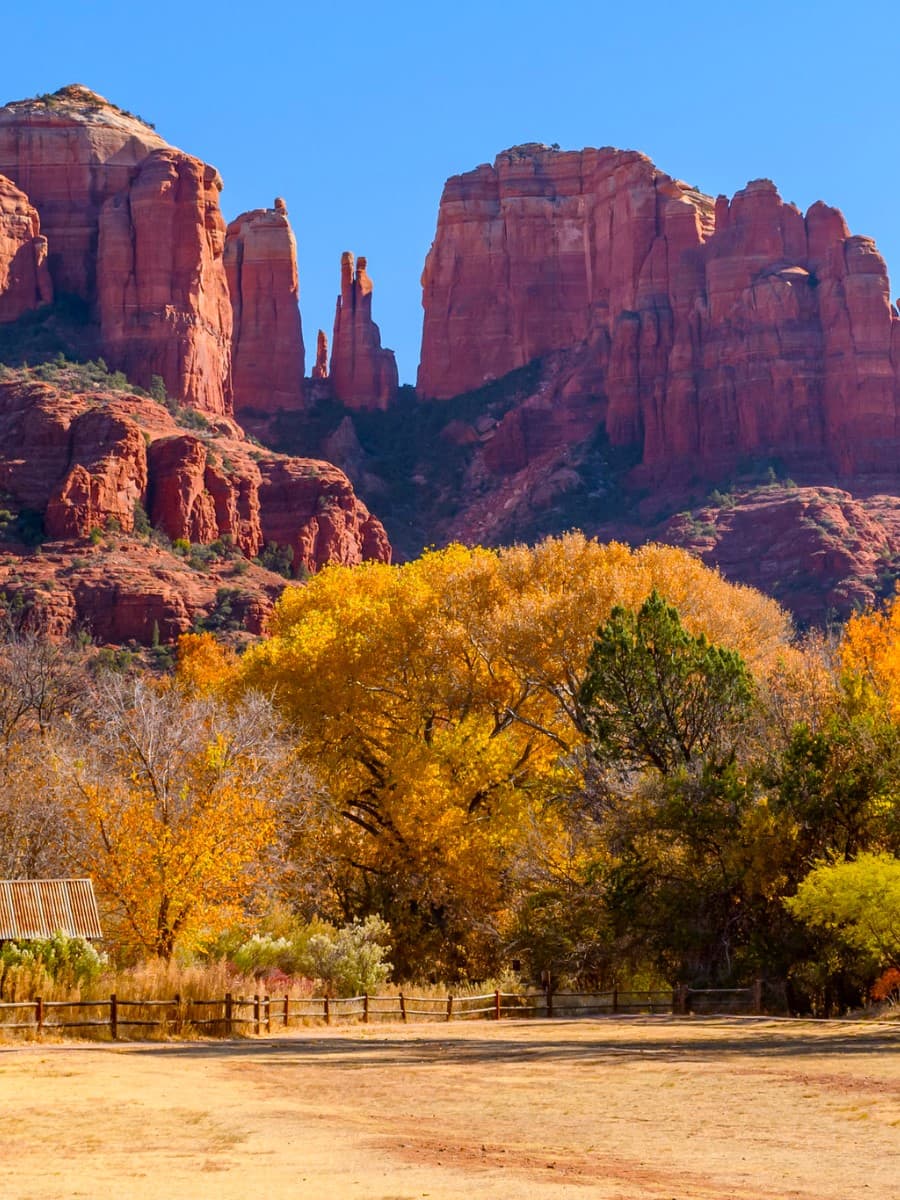
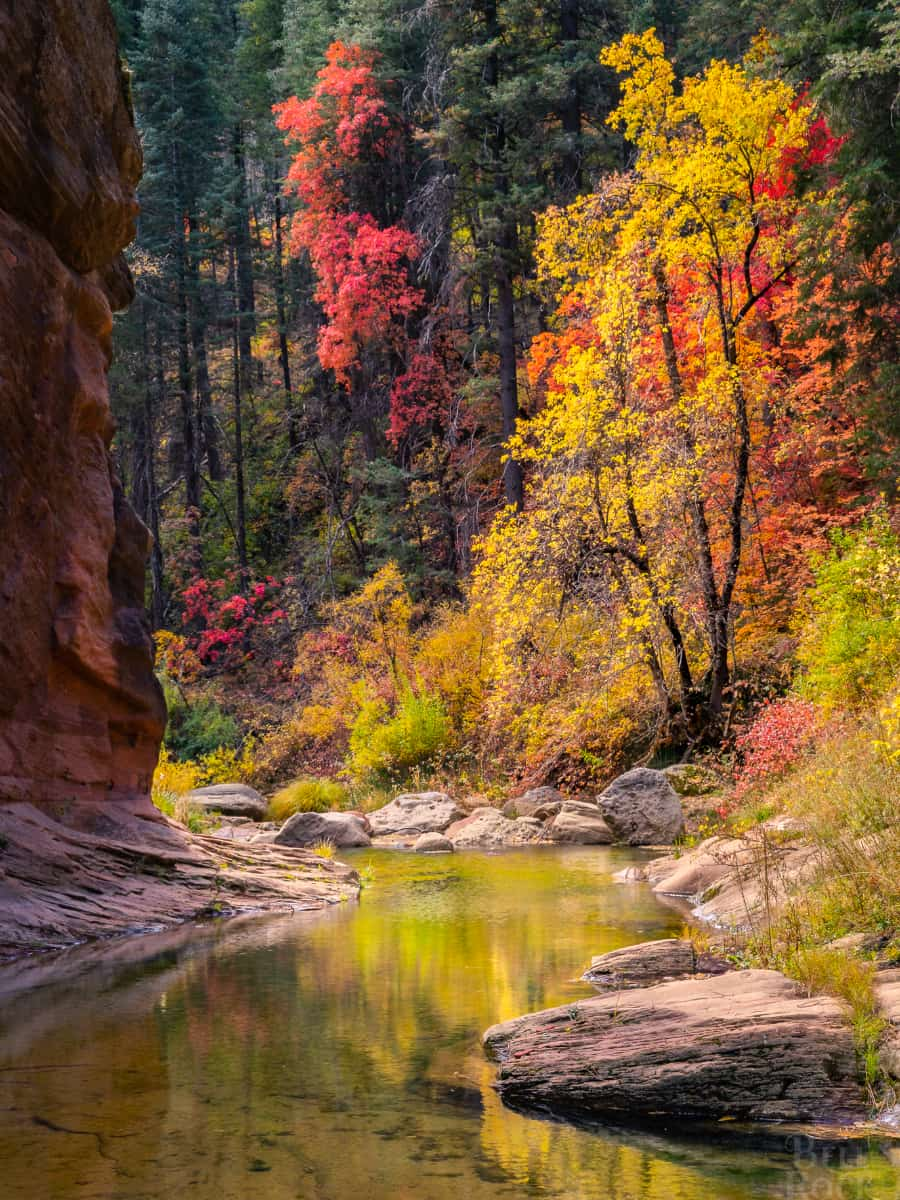
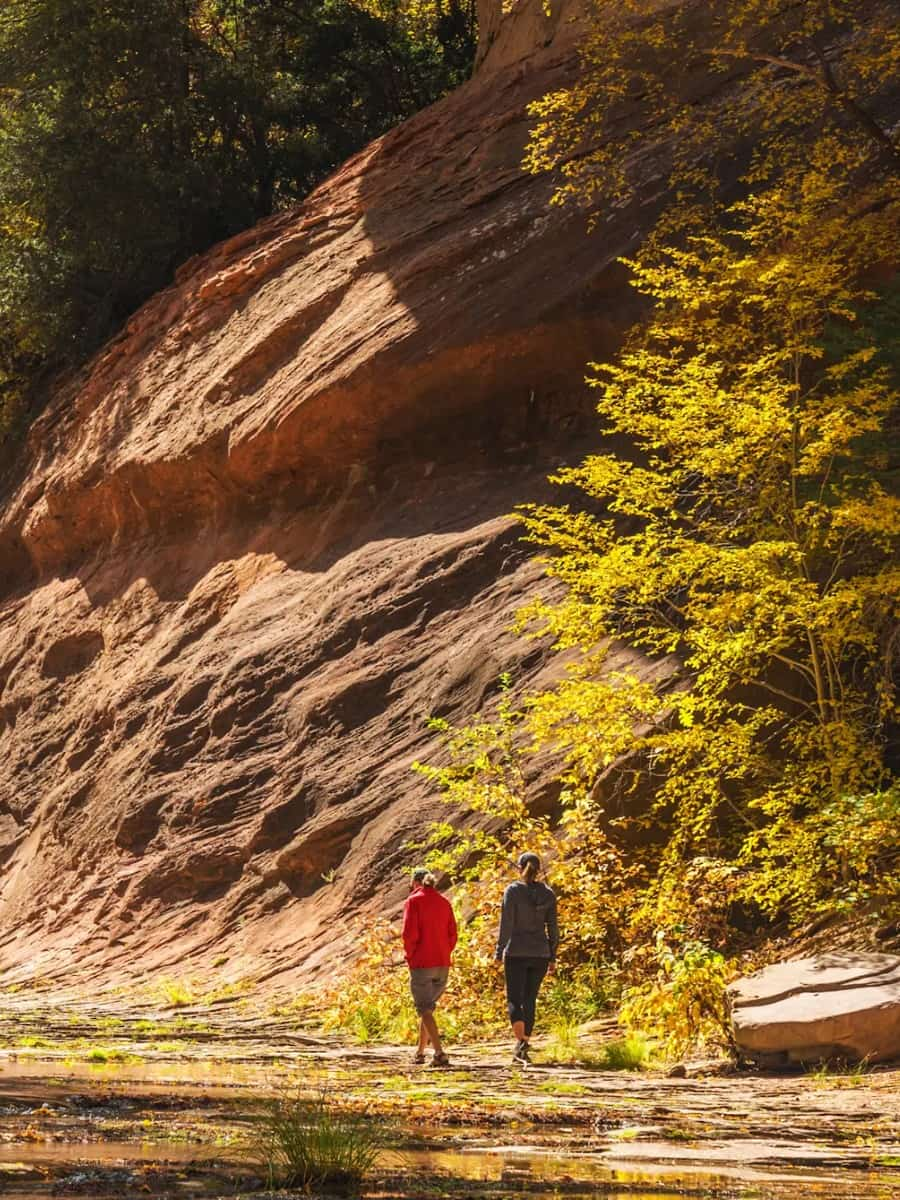
Photography paradise. The combination of red rocks, blue sky, and autumn colors creates a photographer’s dream landscape unique to Sedona. I found the best light for photography in the early morning when the low-angle sunlight illuminated the colorful leaves from behind, creating a glowing effect. The reflections in Oak Creek doubled the visual impact, especially at Red Rock Crossing where Cathedral Rock provides the perfect backdrop.
Prime fall foliage locations in Sedona:
- West Fork Trail (Oak Creek Canyon)
- Red Rock Crossing/Crescent Moon
- Tlaquepaque’s gardens and courtyards
- Oak Creek Canyon Scenic Drive
- Grasshopper Point
Cultural connection. The Sedona Arts Festival (October 7-8) coincides with early fall color, bringing together over 100 artists from around the country in Sedona’s Red Rock High School athletic field. I enjoyed browsing the diverse artwork while chatting with creators about their techniques and inspiration, many of whom incorporate Sedona’s autumn palette into their paintings, pottery, and textiles.
Autumn advantages. October and November offer comfortable temperatures (65-75°F days, 40-50°F nights) perfect for hiking. The clear, dry air enhances visibility for landscape photography and stargazing. Fall also brings smaller crowds than the spring peak season, though weekends remain busy. For the best experience, visit midweek when popular trails like West Fork might have just a handful of other hikers even during peak foliage season.
Day Trips from Sedona
1. Grand Canyon National Park
Natural wonder. The Grand Canyon’s South Rim is just a 2-hour drive from Sedona, making it the perfect day trip to one of the world’s most spectacular natural wonders. I left Sedona early (7 AM) to maximize my time at the canyon and was rewarded with my first breathtaking view at Mather Point just as the morning light was bringing the layered rock formations to life with rich colors and dramatic shadows.
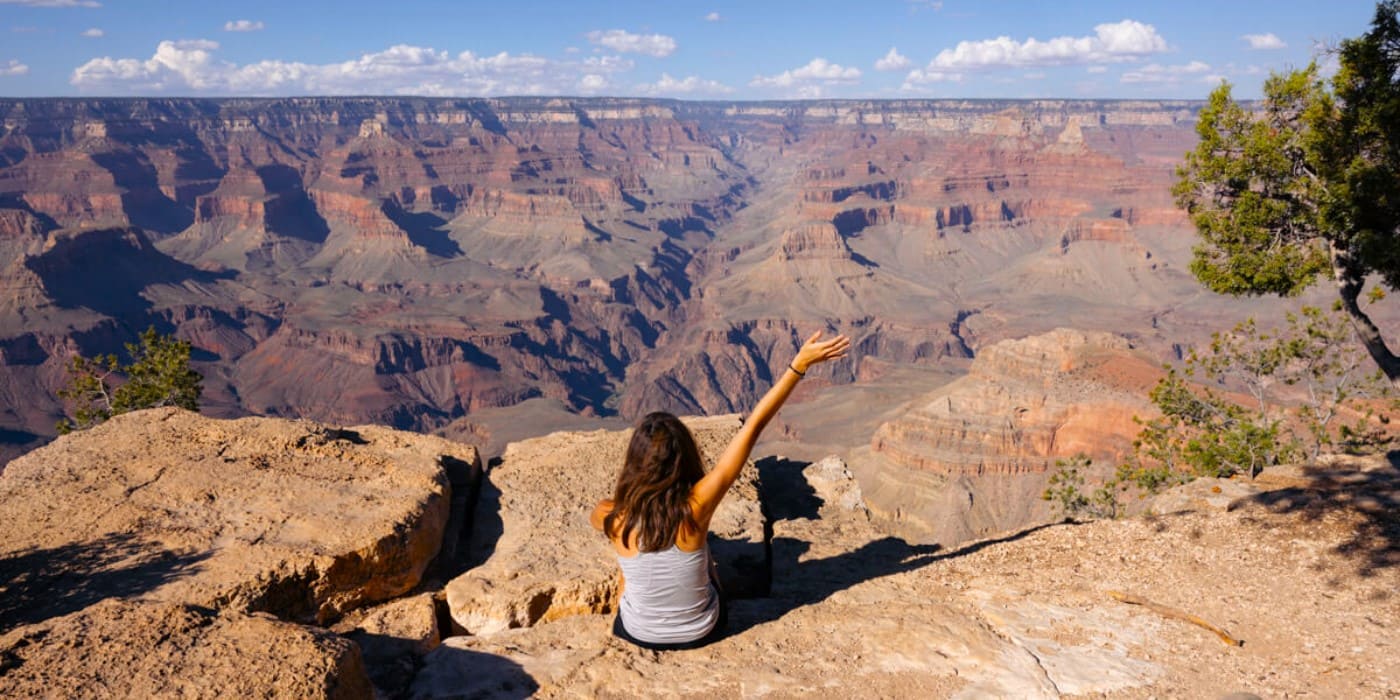
Rim experiences. Rather than trying to hike into the canyon on a day trip, I focused on the excellent Rim Trail, a mostly flat paved path with numerous viewpoints offering different perspectives. The section between Mather Point and Bright Angel Lodge (about 2.5 miles) provides constantly changing vistas without the crowds that concentrate at the main overlooks.
Essential Grand Canyon South Rim stops:
- Mather Point (first dramatic overview)
- Yavapai Geology Museum (educational exhibits)
- Desert View Watchtower (eastern viewpoint)
- Bright Angel Lodge (historic architecture)
- Hopi House (historic Native American crafts)
Practical details. The entrance fee is $35 per vehicle (valid for 7 days), but if you have an America the Beautiful Pass, admission is included. The South Rim is open year-round, though winter can bring snow and ice. The free shuttle bus system makes it easy to explore different viewpoints without moving your car, with buses running every 15-30 minutes depending on the season.
Day trip tips. Leave Sedona by 7 AM to arrive around 9 AM, avoiding the worst crowds. Pack a picnic lunch to save time and money, though food is available at several locations within the park. Plan to depart by 3 PM to return to Sedona before dark. The drive itself is scenic, especially the section through Oak Creek Canyon and Flagstaff. Consider the slightly longer return route via Cameron and Highway 89 for different desert landscapes and a stop at the historic Cameron Trading Post.
⭐ Best Activities
- Grand Canyon Biblical Creation Sunset Tour – Witness the Grand Canyon’s awe-inspiring beauty at sunset on this specialized tour that explores the natural wonder from a biblical creation perspective, with stops at multiple scenic viewpoints to capture the changing colors of the canyon walls.
2. Jerome Ghost Town
Mining history. Perched precariously on Cleopatra Hill just 30 minutes from Sedona, Jerome offers a fascinating glimpse into Arizona’s mining past. Once the fourth largest city in Arizona with 15,000 residents, this former copper mining boomtown nearly became a true ghost town when the mines closed in the 1950s. Today, it’s been revitalized as an artistic community where historic buildings house galleries, shops, and restaurants with spectacular views of the Verde Valley below.
Quirky character. What makes Jerome special is its eccentric personality and literally tilting buildings-the unstable ground has caused many structures to slide downhill over the years. The Jerome Grand Hotel, formerly the town hospital, is reportedly one of Arizona’s most haunted buildings, while the “sliding jail” has moved 225 feet from its original location due to ground subsidence.
Must-see attractions in Jerome:
- Jerome State Historic Park (Douglas Mansion)
- Gold King Mine Ghost Town (mining equipment)
- Jerome Historical Society Mine Museum
- Sliding Jail
- Audrey Headframe Park (glass floor over 1900-foot mine shaft)
Artistic renaissance. I was impressed by the quality of art galleries in this tiny town, particularly at the Jerome Artists Cooperative Gallery where local creators display diverse works inspired by the dramatic landscape and mining history. The town’s 30+ galleries and studios represent everything from fine art painting to quirky metalwork fashioned from mining debris.
Visitor information. Jerome is easily reached via Highway 89A, with the drive from Sedona taking about 30-45 minutes depending on traffic. Parking can be challenging on weekends-I recommend using the large lot at the top of town and walking down (remember you’ll be at 5,000 feet elevation, so the return uphill walk requires some stamina). Most attractions are open 10 AM to 5 PM, with some restaurants and bars staying open later. The Jerome State Historic Park ($7 admission) provides the best overview of the town’s mining history.
⭐ Best Activities
- Jerome Ghost Walk Tour – Discover the haunted history of Jerome, Arizona’s famous ghost town, on this evening walking tour that explores abandoned buildings, shares spine-tingling tales, and reveals the colorful mining past of this historic hillside community.
3. Montezuma Castle National Monument
Ancient architecture. Just 25 minutes from Sedona, Montezuma Castle National Monument preserves one of the best-preserved cliff dwellings in North America. I was awestruck by the five-story, 20-room structure built into a limestone cliff recess about 90 feet above the valley floor. Built by the Sinagua people around 1100-1425 CE, it demonstrates remarkable architectural skill and adaptation to the environment.
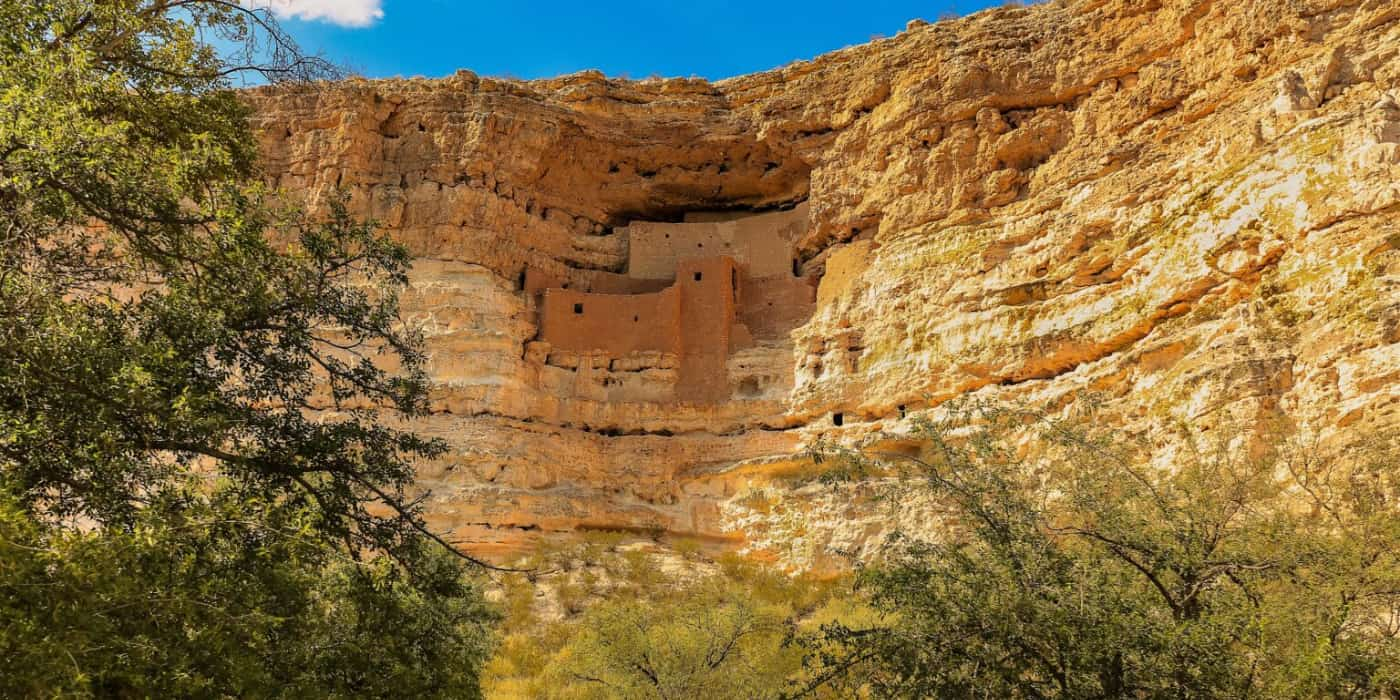
Cultural insights. Despite its name, the dwelling has no connection to the Aztec emperor Montezuma-early European settlers mistakenly attributed it to him. The excellent visitor center exhibits explain the actual history and culture of the Sinagua people, including their agricultural practices, trade networks, and eventual migration away from the area. The short interpretive trail includes signs identifying native plants and their traditional uses.
What to see at Montezuma Castle:
- Visitor center museum
- Native plant garden
- Beaver Creek riparian area
- Montezuma Well (separate section, 11 miles away)
⭐ Best Activities
- Sedona Red Rock Country and Native American Ruins Day Tour – Journey to explore Sedona’s stunning red rock landscapes and ancient Native American ruins on this full-day excursion.
FAQ
What makes Slide Rock State Park so special?
The park is a must-visit destination during your trip to Sedona, featuring an impressive 80-foot natural water slide that has been named one of the top swimming holes in the United States. The park’s slippery algae-covered sandstone creates an exhilarating ride that should be on your bucket list when you explore Sedona.
When is the best time to visit Slide Rock?
The best time to visit the parks is early morning, as the park opens at 8 AM and quickly fills to capacity during peak seasons. From May through September, this Sedona landmark becomes extremely busy, so arriving early is well worth the effort to secure parking and enjoy the natural water slide before crowds arrive.
Are there hiking trails at Slide Rock State Park?
Hiking is one of the best ways to explore the area around the park, with several nature trails that showcase the stunning red rocks of Sedona. The park offers day hike opportunities that allow visitors to experience the Sonoran desert landscape and historic apple orchards, making it one of the top outdoor destinations in West Sedona.
What wildlife can I see at Slide Rock State Park?
The park is home to a diverse range of wildlife including Coues whitetail deer, javelina, and black bears that frequent the apple orchards and brushy areas. Bird enthusiasts visiting Arizona will enjoy spotting colorful Steller’s jays and hummingbirds, so bring binoculars to enhance your wildlife viewing experience during your visit to Sedona.
What are the best hikes in Sedona for locals?
Doe Mountain is a favorite 1.5-mile hike among locals, offering 360-degree views of the red rocks and making it one of the best places to go for sunset viewing in West Sedona. Other top recommendations include Chicken Point via Broken Arrow trail and Seven Sacred Pools via Soldiers Pass, both unique things to experience during your guide to Sedona adventures.
How can I experience Seven Sacred Pools in Sedona?
Seven Sacred Pools is accessible via the Soldiers Pass trail, an easy 2.8-mile out-and-back hike with 403 feet of elevation gain north of Sedona. This natural landmark in Sedona features large rock formations that fill with water after monsoon rains, making it one of the best places to visit for experiencing the unique geological wonders during your road trip through Arizona.
Where is the best place for stargazing in Sedona?
Sedona’s designation as a dark sky community makes it one of the best places to experience the starry night sky without light pollution. Ambiente Sedona offers private rooftop stargazing experiences with professional astronomers using powerful telescopes, allowing visitors to observe stars, clusters, nebulae, and the Milky Way in remarkable clarity during their visit to Sedona.
What are some of the best restaurants in Sedona?
Elote Cafe and Mariposa are consistently ranked among the best restaurants in Sedona, offering exceptional Southwestern cuisine with spectacular views of the red rocks. For breakfast, Coffee Pot Restaurant and Casa Sedona Restaurant serve delicious morning fare like the “Sedona Style” eggs Benedict with smoked salmon and brie, making dining one of the best things to enjoy during your exploration of this hiking destination.
Where to watch the sunset in Sedona?
Doe Mountain is one of the best places to watch the sunset in Sedona, with its platform providing stunning 360-degree views after a moderate 30-minute hike to the top. Chicken Point, accessible via the Broken Arrow trail, also offers magnificent sunset vistas from large platforms overlooking the south side of Sedona, making sunset viewing a man-made wonder of Arizona that’s well worth the visit.
What tips should I follow when hiking in Sedona?
Always bring plenty of water when hiking in Sedona as the desert climate can be deceiving even during short explorations of the area. Stay on marked trails, download offline maps before your adventure, and maintain quiet to appreciate the natural sounds around you, remembering that the red rocks of Sedona deserve respect as you’re only visiting this ancient landscape.
